Last updated on April 30, 2024
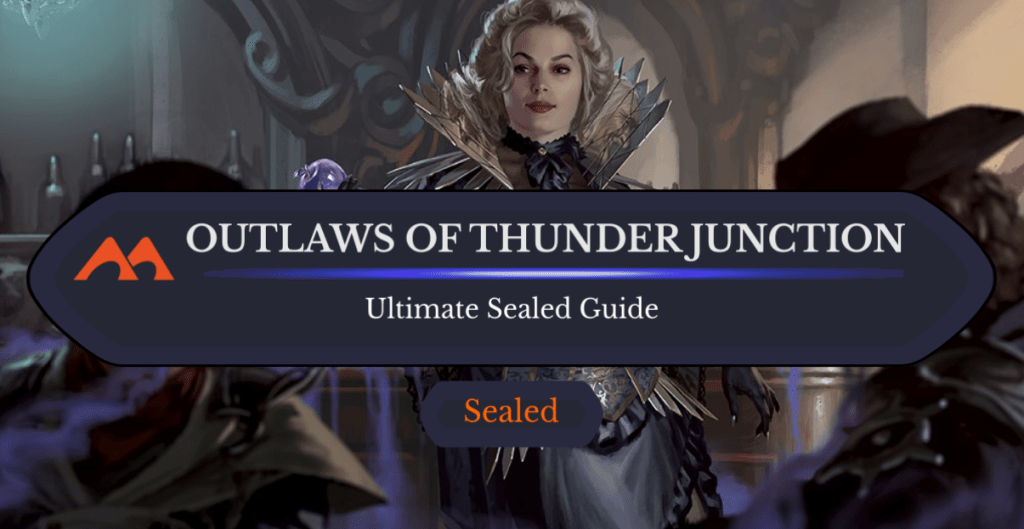
Eriette, the Beguiler | Illustration by Chris Rallis
Howdy planeswalkers! We’ll be going westward to a land of opportunity, crime, and seemingly endless cameos. Prerelease for Outlaws of Thunder Junctionis this weekend, and this Magic set will be available online on MTG Arena next Tuesday. I’m honestly not the biggest fan of this plane‘s flavor, but looking over the spoiler makes one thing clear: the set is jam-packed with powerful cards!
And before we begin, don’t forget to check out our OTJ Limited Set Review or article on the best cards in the set. While I try to draw a comprehensive big picture, it’s always handy to have a reference for individual cards as well.
Set Overview
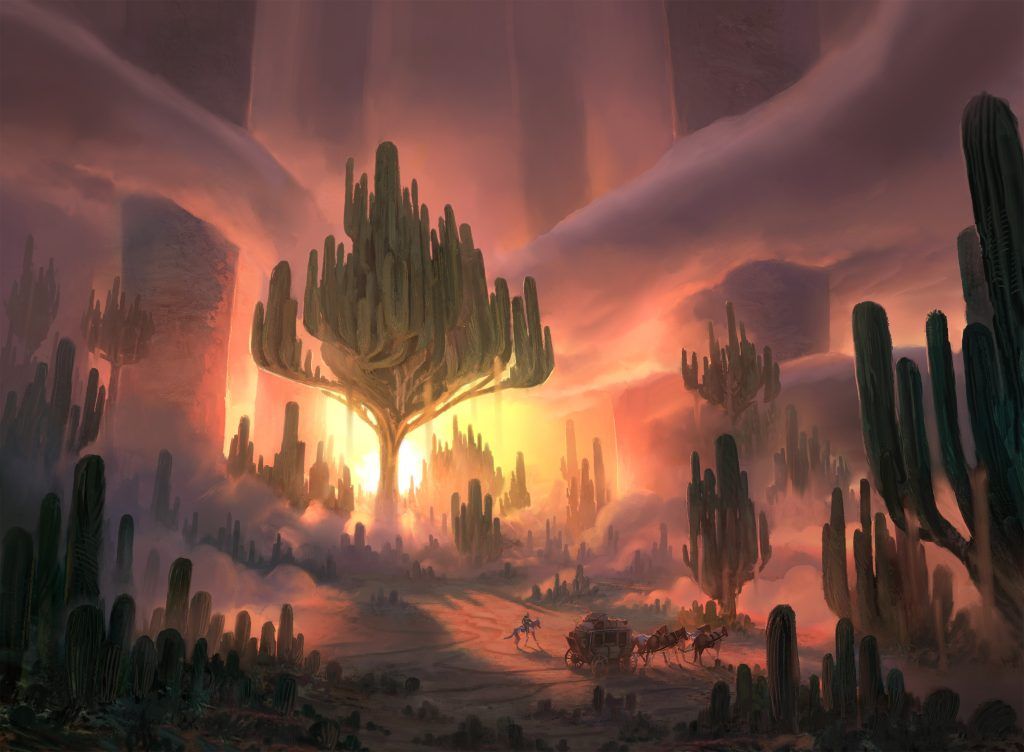
Creosote Heath | Illustration by Leon Tukker
Outlaws of Thunder Junction draws its flavor from two main themes: villain vs. villain conflict and Western tropes. References to both abound in the set’s mechanics, card names, and flavor. The set is also notable for having not one but two bonus sheets, Breaking News and The Big Score. This can be a lot to take in, so let’s start by evaluating how cards are distributed in Outlaws of Thunder Junction Play boosters. I’ve borrowed the blurb below from WotC’s article on collecting the set, which had the best explanation I could find.
OTJ Play Booster Contents
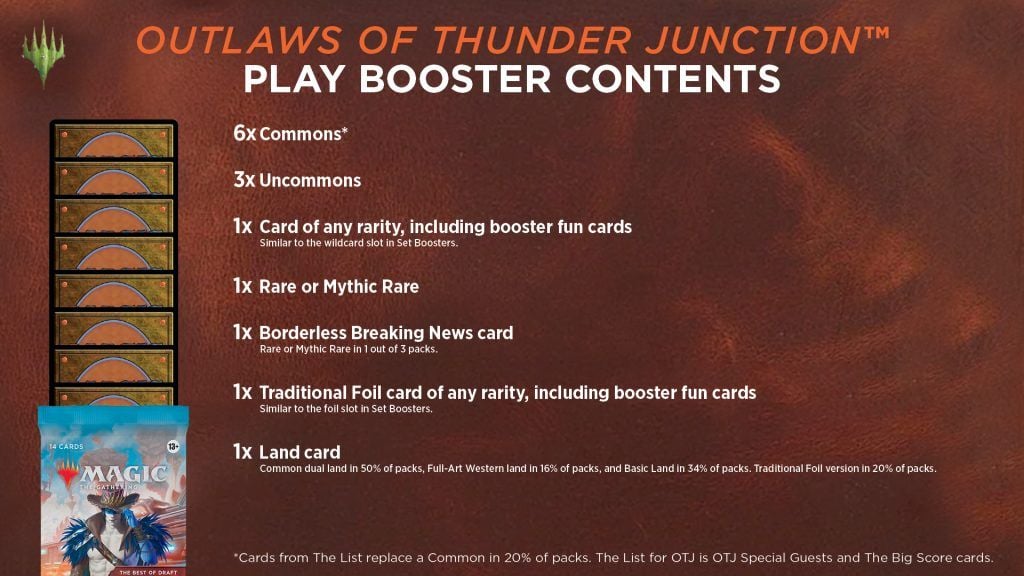
An Outlaws of Thunder Junction Play booster contains 14 cards and a token/ad card or an art card. You can open the following:
5–6 Commons
- 20% of Play boosters contain a card from The List instead of a common.
- As detailed above, The List for OTJ consists of cards from SPG (Special Guests) and BIG (The Big Score).
3 Uncommons
- 1 Wildcard of any rarity, including OTJ Booster Fun cards – In 1 out of 12 Play boosters, the wildcard is a rare or mythic rare.
- 1 Rare or mythic rare. All 60 rares and 20 mythic rares can be found in this slot. In 2.5% of Play boosters, you'll open a Booster Fun rare or mythic rare.
- 1 OTP card that can be uncommon, rare, or mythic rare. In 1 out of 3 Play boosters, this is a rare or mythic rare.
- 1 Traditional foil card of any rarity. This can include Booster Fun cards and OTP (Breaking News) cards but doesn't include cards from The List.
- 1 Land; half of all Play boosters contain a common dual land
What to Make of All This?
Thanks to all the extra content, Outlaws of Thunder Junction is jam-packed with cards; it has 271 on its own (not counting five basic lands), 65 cards from Breaking News, and 40 cards from The Big Score + Special Guests. This adds up to a whopping 376 different cards!
Most of the extra cards you’ll see come from Breaking News rather than The Big Score.
Breaking News is a collection of noncreature spells from Magic’s history. Its contents vary dramatically, both by power level and how recently they were printed. Card strength goes all the way up from Thornado to Oko, Thief of Crowns and Mana Drain, while card recency ranges from Heartless Pillage to Buried in the Garden (literally from the last set). Ultimately, the cards from this bonus sheet should make games more interactive and unpredictable, though some of the inclusions will be miserable to play against.
The Big Score, on the other hand, was originally planned as an epilogue set like March of the Machine: The Aftermath. After the terrible reception of Epilogue boosters, WotC decided just to release thirty out of the fifty planned cards via a second bonus sheet. The result is a grab-bag of cards that are individually powerful, synergistic with Standard themes (like Ux artifacts), or seem to hate on certain archetypes (i.e. Grand Abolisher, Torpor Orb). For Outlaws of Thunder Junction Limited, The Big Score will be most relevant when you open one of several busted rares from the sheet like Harvester of Misery, Hostile Investigator, and Bristlebud Farmer. Most of the other build-arounds and hate cards don’t look particularly well suited for Limited, though.
Finally, the ten Special Guests are rare enough that they should have a pretty minimal impact on the format. Since there’s only 10, I’ll list and review them here:
Stoneforge Mystic: Amazing card in Constructed, but usually lackluster here as Outlaws of Thunder Junction is light on equipment. I’m personally holding out for the pipe dream of opening this alongside Assimilation Aegis!
Brazen Borrower: Strong, flexible aggressive card that goes in every blue deck. Probably the best Special Guest to open.
Desertion: Immense blowout potential, but extremely clunky to use like any other 5-mana counterspell. Still might try it in Sealed if I was already blue.
Morbid Opportunist: Good value creature that goes off with removal and self-sacrifice.
Port Razer: Much better in Commander than in 1v1; I’m not even sure if I’d play this over Iron-Fist Pulverizer, which has reach and better stats.
Scapeshift: 100% useless in Limited as always.
Mystic Snake: The original creature Counterspell, still a bit clunky but definitely more practical than Desertion.
Notion Thief: Understatted creature that punishes your opponent for drawing cards; utility varies immensely by matchup.
Desert: Why yes, this does have the desert land subtype. How could you have guessed?
Prismatic Vista: Great fixing as 1 life is a lower cost to pay than having the usual cost of having the land enter tapped. Still not a bomb or anything though.
Mechanics
Crime
Crimes are a game action introduced in the set. Whenever you cast a spell or activate an ability that targets an opponent or their stuff (spells or permanents in any zone, like the battlefield, the stack, their hand, library or graveyard), you’re “committing a crime”.
As you might expect, there are various rewards in the set for crime, like:
- Gaining double strike on your bear (Omenport Vigilante)
- Getting a discount on your Divination (Seize the Secrets)
- Giving lifelink or menace to creatures you control (Rattleback Apothecary)
- Being able to cast Act of Treason at instant speed (Take for a Ride)
- Untapping your mana dork (Hardbristle Bandit)
There are 26 cards in total that reference committing crimes. Most of these appear in blue or black, which is no coincidence as crime is the primary focus of Dimir‘s () Draft archetype.
Plot
Plot is an alternative cost mechanic that resembles Kaldheim‘s foretell and Time Spiral‘s suspend. When you play a card’s plot cost, you exile it, then may cast it on a later turn without paying its mana cost, but at sorcery speed (even if the plotted card was an instant or has flash). Keep in mind that the card is always exiled face up, so your opponent knows what’s coming.
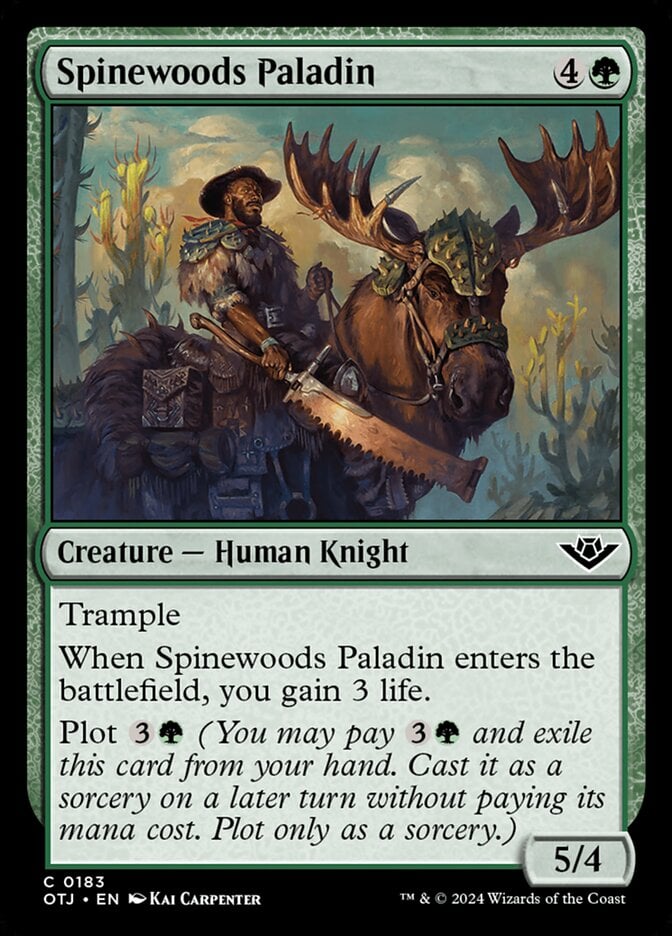
Without any deck synergy, the main reason you’d want to plot is for discounts. Take Spinewoods Paladin for example; you can play it for a full mana cheaper by taking a “blank turn” before you’d normally play it. On the other hand, you may be behind on board and not have the luxury of plotting.
Some cards like Rictus Robber and Irascible Wolverine have triggered abilities that are much easier to leverage when they cost 0 mana on a later turn.
Outlaws of Thunder Junction also includes several direct incentives for plotting:
- There are cards like Loan Shark and Thunder Salvo that reward you for playing two or more spells in one turn.
- There are also cards like Prairie Dog and Canyon Crab that reward you for not playing a spell on your turn.
- Some cards like Longhorn Sharpshooter and Aloe Alchemist have triggered abilities that reward you for plotting them.
There are 38 cards in total that reference plotting, most of which appear in blue, red, and green. Plotting is a core Draft mechanic for Simic () and also helps support () and ()’s archetypes.
Saddle
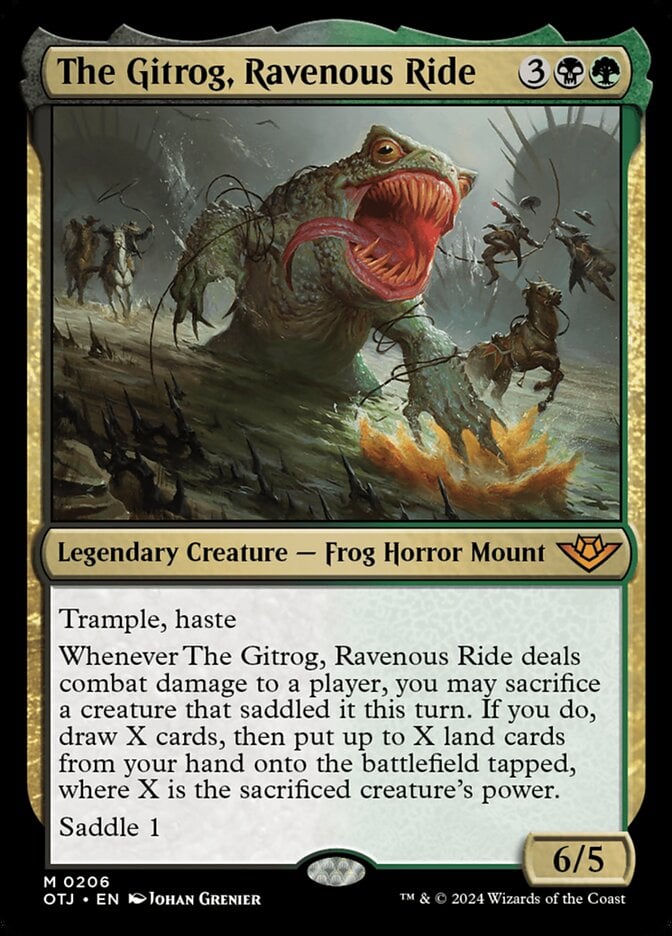
Saddle is a keyword ability associated with a new creature type, mounts. It greatly resembles vehicles' crew ability, as it’s activated by tapping any number of creatures you control with total power equal to or greater than the saddle value (just like crew’s crew cost). A key difference is that creatures with saddle don’t need to become creatures. They’re already creatures to begin with, but have abilities that only trigger when they become saddled or attack while saddled.
There are 17 mount creatures in the set, most of which are green or white. Red has three saddle creatures, while blue and black are limited to a pair of rares (plus The Gitrog, Ravenous Ride, if you count BG). Saddle is the defining focus for GW’s Draft archetype in this set.
Spree
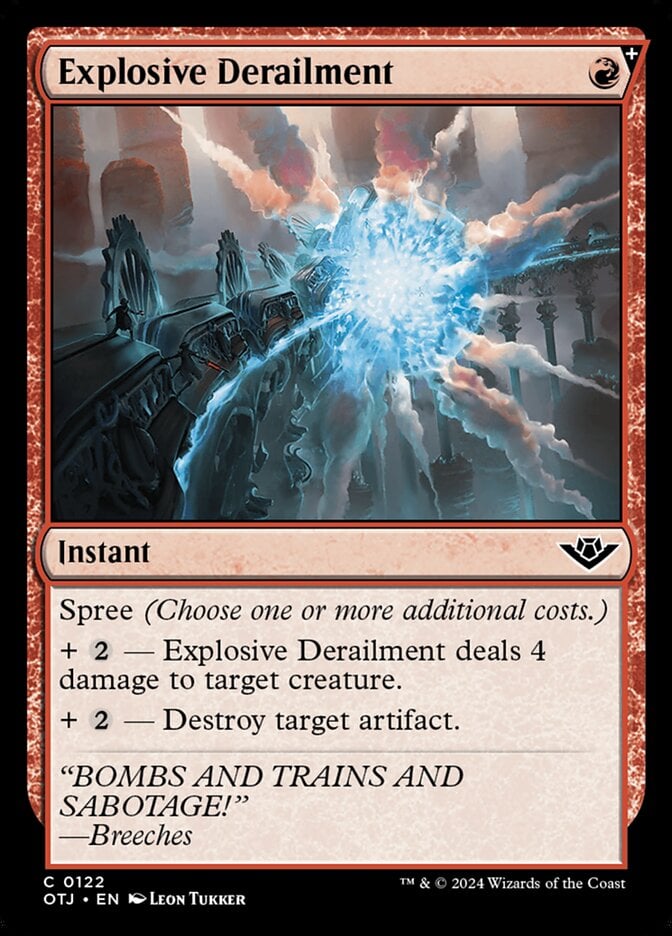
Spree is a keyword found on select instants and sorceries, which grants them modality in a way similar to escalate. Spells with spree always have either two or three additional costs that you can pay for various effects. You must pay at least one additional cost to cast a spell with spree.
To get a better feel for the spree mechanic, let’s start with a simple but excellent common from OTJ, Explosive Derailment. In practice this card can be:
Flexibility is always appreciated in Magic, so pay close attention to cards with spree. They aren’t all as good as Explosive Derailment, but the best ones will be very high picks. The mechanic appears on 21 cards in total with a fairly balanced spread across colors and rarities, though it’s least common in green.
Outlaws, Mercenaries, and Deserts
Three other elements to be aware of are the new “outlaw” type group, Mercenary tokens, and the return of seserts. A creature is considered an outlaw if it’s one or more of these creature types:
Being an outlaw is relevant for a number of cards, and a big focus of in Draft. Mercenaries on the other hand are tokens that are often created as a bonus on certain familiar effects (i.e. Lassoed by the Law, Mourner's Surprise). They’re 1/1 creatures that can tap to give a creature you control +1/+0 until end of turn (at sorcery speed).
As for deserts, the last time we saw them in Standard was with Hour of Devastationseven years ago. Desert is a subtype that appears on various lands in the set, including a cycle of ten common 2-color lands that enter the battlefield tapped. There is a small “deserts matter” theme for Draft, though it’s more of an accessory to other strategies than a full blown archetype.
Archetypes
Outlaws of Thunder Junction has ten distinct 2-color archetypes, just like most sets. Each color pair has two signpost uncommons to help show what their game plan is.
WU “No Spells Cast” Plot
Jem Lightfoote, Sky Explorer and Wrangler of the Damned are always thrilled to see a turn go by without anything cast from your hand. The main ways to set this up without falling behind are:
- Spending your mana to plot cards,
- Casting cards you plotted previously (don’t forget “from hand”),
- Holding up mana for instant speed cards like Phantom Interference and Stop Cold.
When all is said and done, you can treat WU as a soft flash strategy of sorts, prioritizing cheap instant speed interaction and plot spells.
UB Crime Control
Intimidation Campaign and Lazav, Familiar Stranger reward you handsomely for messing with your opponent. As the premier crime archetype, gives you a good opportunity to talk about how best to commit crimes in the set. Some effective ways include:
- Removal spells (which should already have been a priority in a controlling deck),
- Triggered abilities that target opponents or their stuff,
- This breathes extra life into familiar cards like Spring Splasher (Vedalken Mesmerist), as it subtly has “when this creature attacks, commit a crime”.
- Cheap cantrips like Take the Fall, which target something and replace themselves,
- Soured Springs and similar lands.
Always pay attention to the word target; if your card says “each” (i.e. Intimidation Campaign), then you are not committing any crimes.
BR Outlaws
At Knifepoint and Vial Smasher, Gleeful Grenadier want as many outlaws as you can muster.
These cards have strong synergy together, as playing an outlaw with Vial Smasher, Gleeful Grenadier out triggers At Knifepoint. But even if you can’t get both every Draft, there are still plenty of outlaws for you to draft an aggro deck around. Don’t forget to pack Outlaws' Fury as well, which is quite an improvement on Trumpet Blast for this deck.
RG “Ferocious”
trots familiar ground with Cactusfolk Sureshot and Jolene, Plundering Pugilist, both of which care about having 4+ power creatures in play. Expect to do usual RG things like fielding big dudes, using fight spells, and bashing face.
Quilled Charger, Drover Grizzly, and Giant Beaver are notable commons with 4 power for you to include.
GW Mounts & Vehicles
Congregation Gryff and Miriam, Herd Whisperer showcase ’s focus on mounted combat. Because mounts can saddle up other mounts (flavor fails aside), you’ll want to draft as many good ones as you can. Creature density in general is quite important for GW, so try not to dip below 15+ creatures if you can help it.
Note that while Miriam, Herd Whisperer boosts vehicles, there are only three vehicles in the entire set: Luxurious Locomotive, Mobile Homestead, and Unlicensed Hearse (from Breaking News). Ultimately, GW “Mounts & Vehicles” is a bit of a deceptive title.
WB Attrition
Baron Bertram Graywater and Ruthless Lawbringer are alike in their affinity for cheap fodder creatures. in this set is all about grinding out your opponent by sacrificing disposable creatures for value. Ideal choices for fodder include:
- Mercenary tokens
- Other 1/1 tokens like Sheep from Bridled Bighorn
- Creatures with death triggers like Outlaw Medic and Nezumi Linkbreaker.
You’ll want to include a balance of fodder, sacrifice outlets, and generally strong cards like bombs/removal.
UR Two or More Spells
Kraum, Violent Cacophony and Slick Sequence give a feel similar to what it had in Throne of Eldraine. The best ways to cast two spells in a turn are:
- Plotting cards beforehand
- Playing cheap cards in general (ideally ones that cantrip)
Card velocity is crucial for success in , so you’ll want to include some ways to refuel your hand if possible.
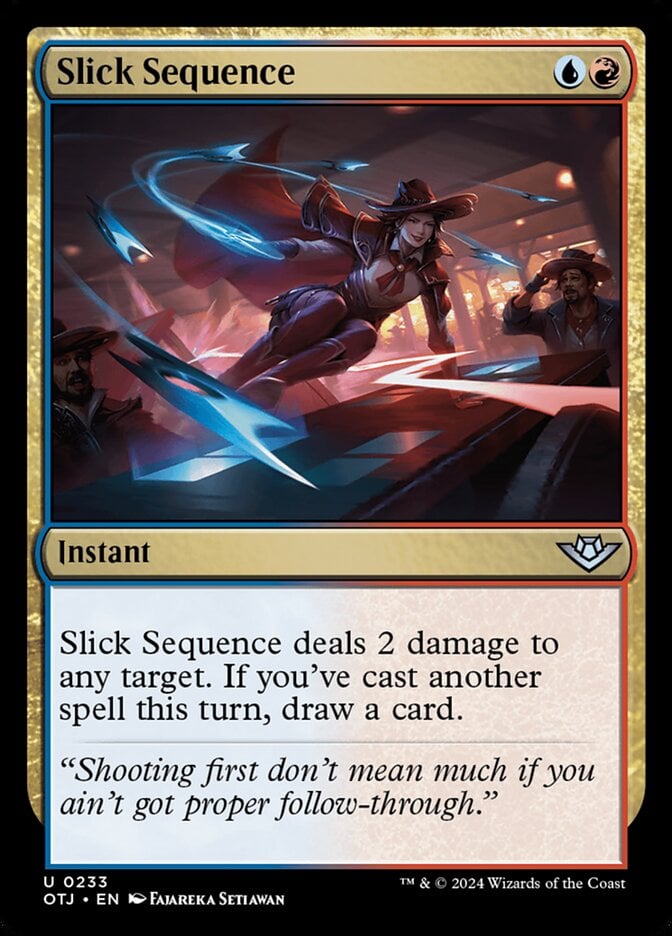
This archetype has some of the strongest-looking payoffs in the set; I mean seriously, did you read Slick Sequence? That’s a 2-mana Electrolyze when it works!
BG Recursion
Badlands Revival and Honest Rutstein give you the name of the game for : value. BG is often grindy, but its signpost uncommons are rarely this good. Honest Rutstein is a 3-mana Gravedigger with +1/0 and a passive creature discount, while Badlands Revival went ahead and tacked an entire card onto your Rise from the Grave.
Commons that should play well in BG include Ankle Biter, Cactarantula, and Vault Plunderer. Don’t forget to include strong removal spells, as games will go long and you might need to answer some bombs.
RW Mercenary Aggro
Ertha Jo, Frontier Mentor and Form a Posse have going wide and focusing on the new Mercenary token type.
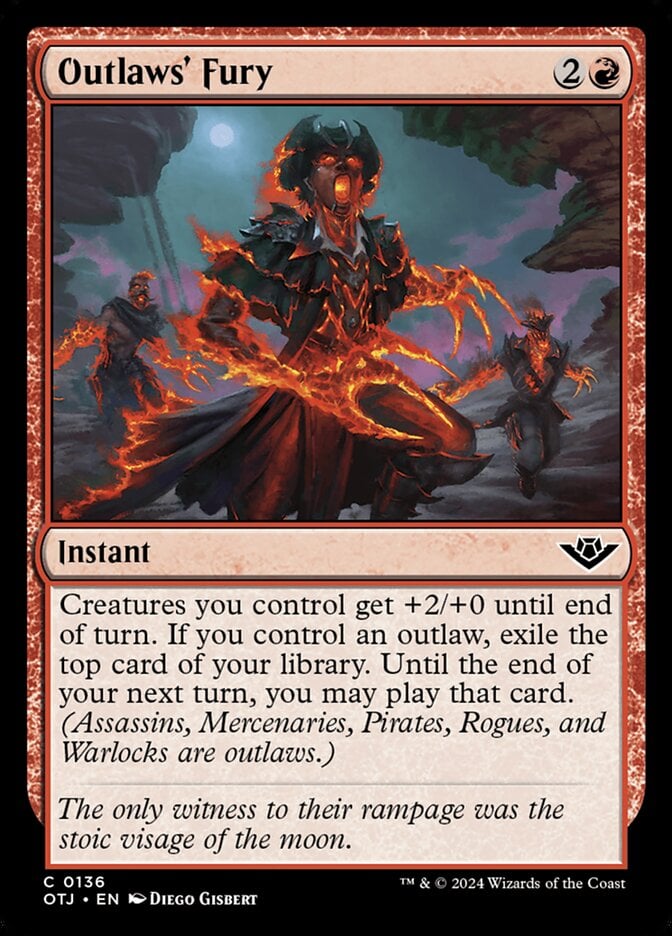
Mercenaries stack nicely in multiples, as they can buff each other to trade up or swing out on their own with something like Outlaws' Fury. RW is ultimately in pretty standard territory for it, as it’s once again one of the most aggressive archetypes in the format.
GU Big Mana Plot
Doc Aurlock, Grizzled Genius and Make Your Own Luck headline the final archetype, another deck based around plotting. Doc Aurlock, Grizzled Genius reduces costs in three ways, but generally only the cheaper plotting matters. Make Your Own Luck incentivizes you to include big spells for the largest possible discount. As is often the case with , I’d expect to splash frequently in this archetype for bombs/removal from other colors.
Thematic Overlap
There’s quite a lot of overlap in this set! You probably saw me hint at it, but let’s go for a full assessment:
- Crimes are a primary focus for , but also matter for which has cards like At Knifepoint. Some outlaw creatures also have abilities that commit crimes naturally (i.e. Deadeye Duelist).
- Even if you aren’t focused on them, you’ll incidentally commit crime whenever you play a removal spell, a 2-color land like Bristling Backwoods, etc.
- Plotting is a key mechanic for , , and , with each archetype having its own reasons to want to delay spells.
- Saddle is mostly doing its own thing, though any deck with creatures (i.e. every deck) can take advantage of mounts.
The Mercenary tokens in this set have a number of uses:
- They’re outlaws for ’s outlaws-matter theme.
- The +1/+0 ability can temporarily give you a 4+ power creature for RG payoffs.
- They’re extra creatures to saddle up your mounts.
- Mercenaries make good fodder for WB’s various sacrifice effects.
- And all of this is outside of RW, their primary archetype!
Also note that WB’s sacrifice theme goes well with ’s recursion focus. Both archetypes might consider splashing each other’s signposts.
Top Commons
Here I’ll wager four commons each for each color that look exceptional, but I’ll revisit these when my Draft Guide is out.
White
#1. Mystical Tether
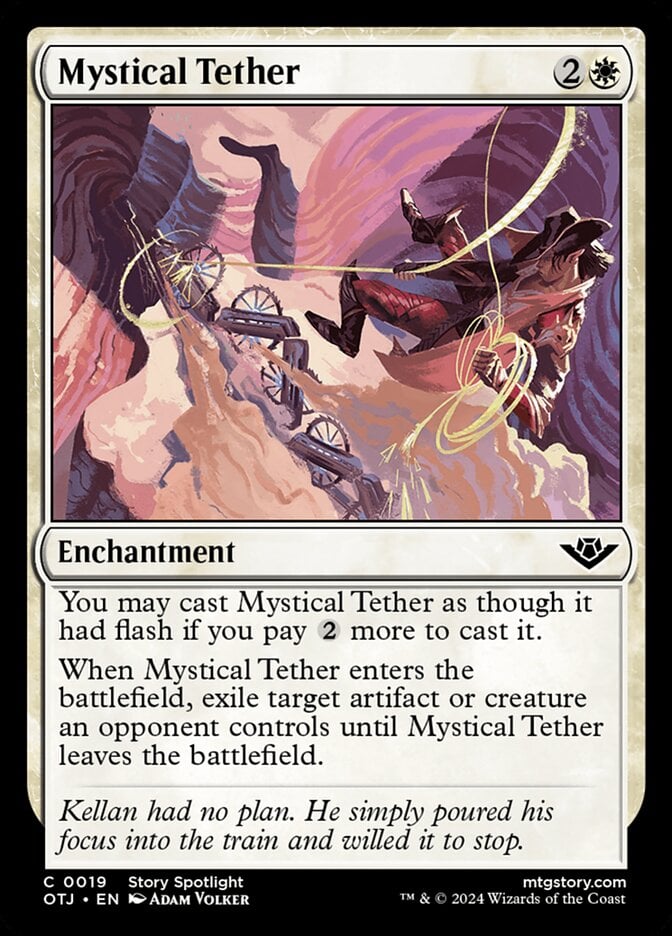
Makeshift Binding is back, but +2 life has been substituted for the option to play this white enchantment with flash for . Mystical Tether is a strong all-purpose removal spell that answers bombs and scales well as the game goes on.
#2. Vengeful Townsfolk
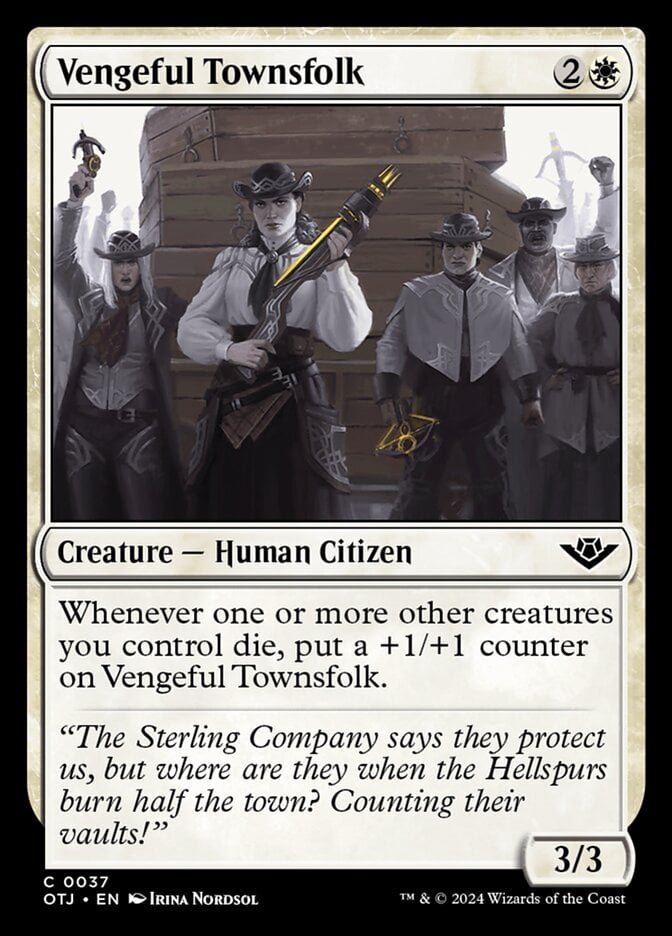
Power creep is real! Rising Populace now starts a 3/3 it seems, so it’s going to be starting in every white deck I draft. Vengeful Townsfolk is Best in WB Sacrifice but efficient enough to be played elsewhere.
#3. Holy Cow
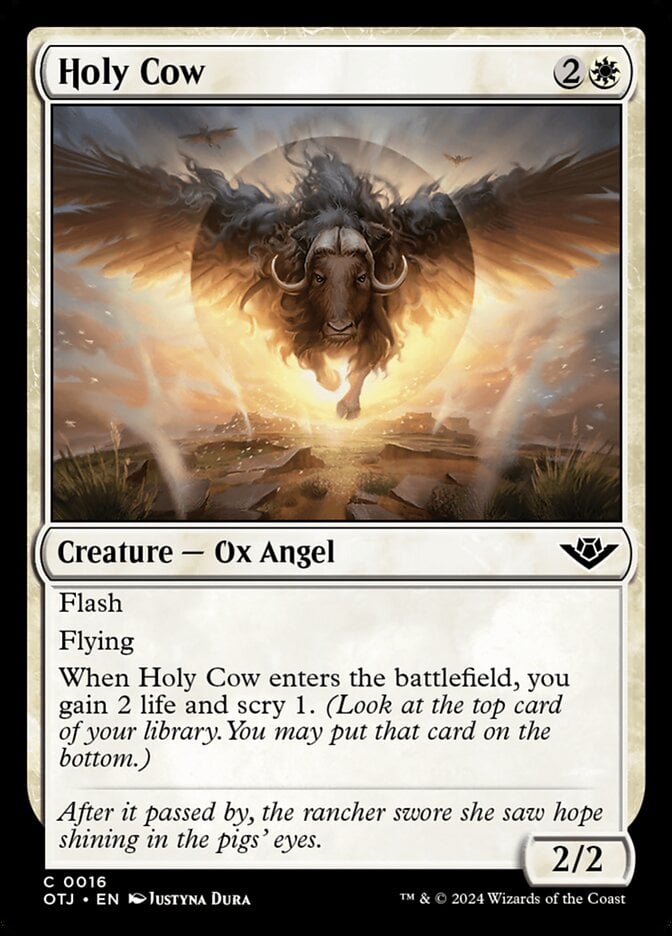
Holy Cow isn’t only a great pun but also a pretty solid white creature. The rate is good enough for any deck, but this particularly excels in WU thanks to flash.
#4. Sterling Keykeeper

Tappers aren’t usually bears, so I’d expect the combination of decent stats + late game utility to make Sterling Keykeeper white’s best common 2-drop. It also combos nicely with Eriette's Lullaby.
Blue
#1. Geyser Drake
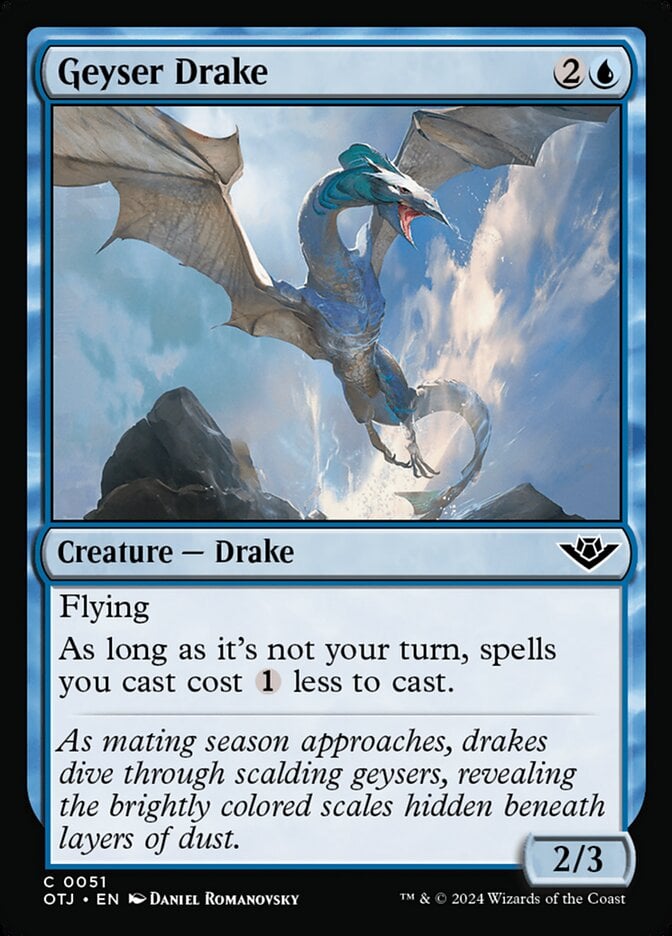
More power creep, since Soaring Drake now comes with pretty good upside. Geyser Drake is best in WU but the blue creature‘s stats are good enough for any blue deck.
#2. Phantom Interference
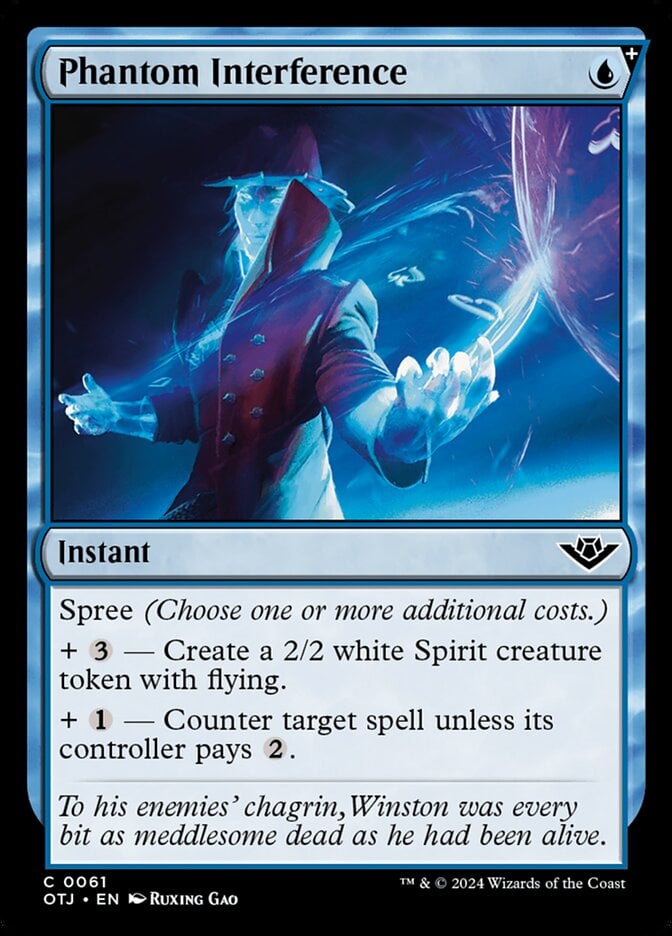
The upside for this blue instant here is immensely superior to something like Reasonable Doubt, so I have high hopes for this annoying card. Don’t hesitate to cast it as Quench though.
#3. Take the Fall

Take the Fall looked unassuming, but thinking about it some more it should be excellent. It’s not difficult to control an outlaw, and this cantrips while committing a crime either way.
#4. Loan Shark
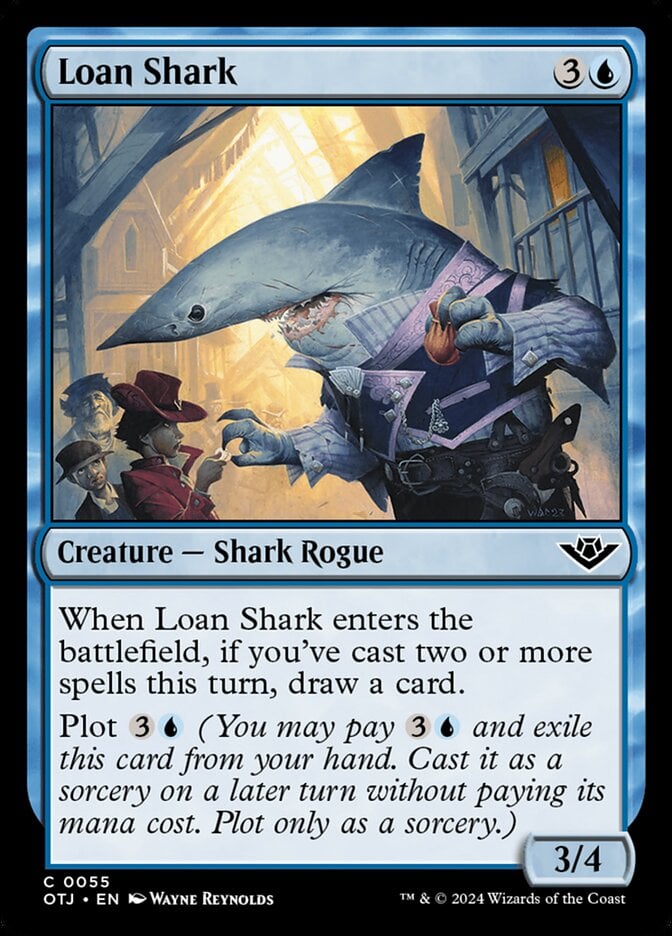
Loan Shark probably plays best when you are plotting cheaper cards with it, rather than relying on plotting itself. Still, the stat line is solid, and I’d never say no to value like this.
Black
#1. Consuming Ashes

Black’s presumed top common, like Extinguish the Light. This black instant works best as an answer to bombs and expensive creatures, but it’s acceptable to use against smaller targets.
#2. Vault Plunderer
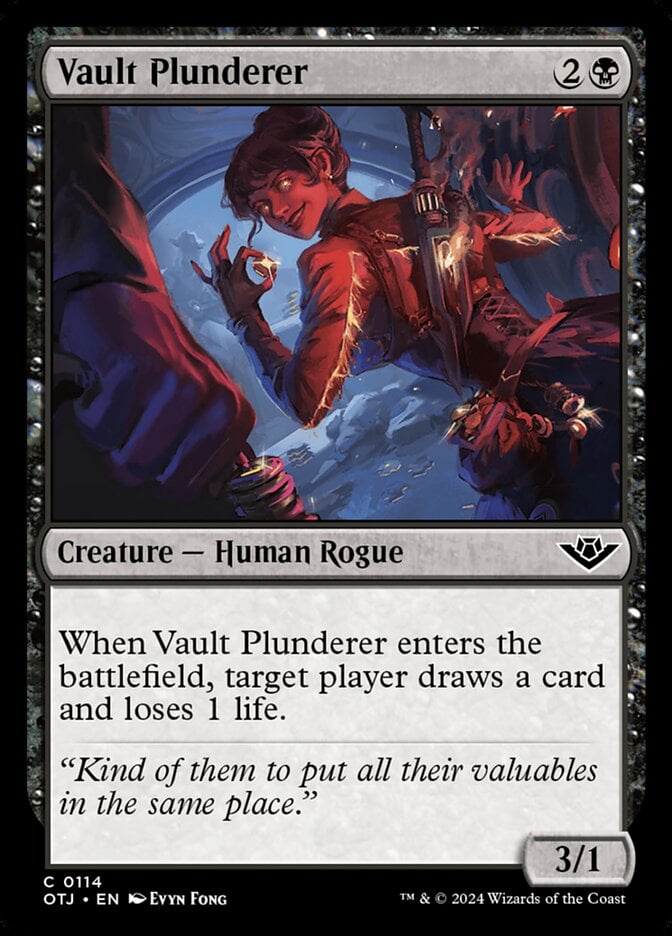
More like value plunderer, am I right? This black creature trades up nicely on defense and helps black decks out grind their opponents. You'll usually target yourself for the cantrip and shrug off the life loss, but this human rogue can target opponents for a crime if needed.
#3. Desert’s Due

-2/-2 for at instant speed is decent, but it shouldn’t be too hard to get this to Last Gasp-levels. The existence of this common incentivizes black players to take deserts more highly than others.
#4. Mourner’s Surprise
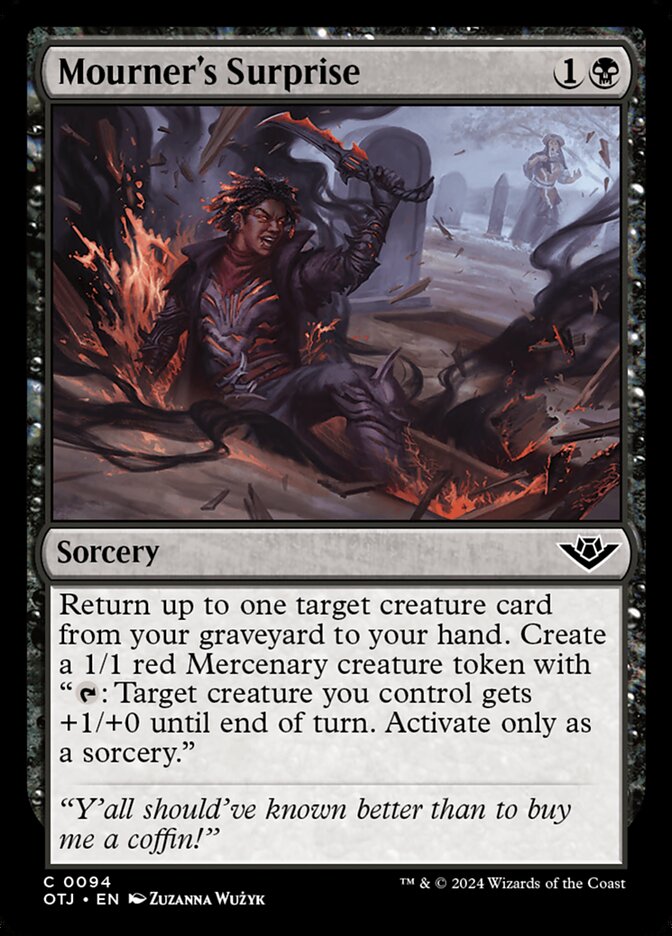
Raise Dead plus a Mercenary token is a nice deal for . I wouldn’t want a ton of these, but the first copy should be great in most decks.
Red
#1. Explosive Derailment

I extolled praise on Explosive Derailment earlier, so it should come as no surprise that it’s my top red common. Bombard is still a solid rate even in 2024 Magic, and the Shatter upside should come in handy.
#2. Prickly Pair
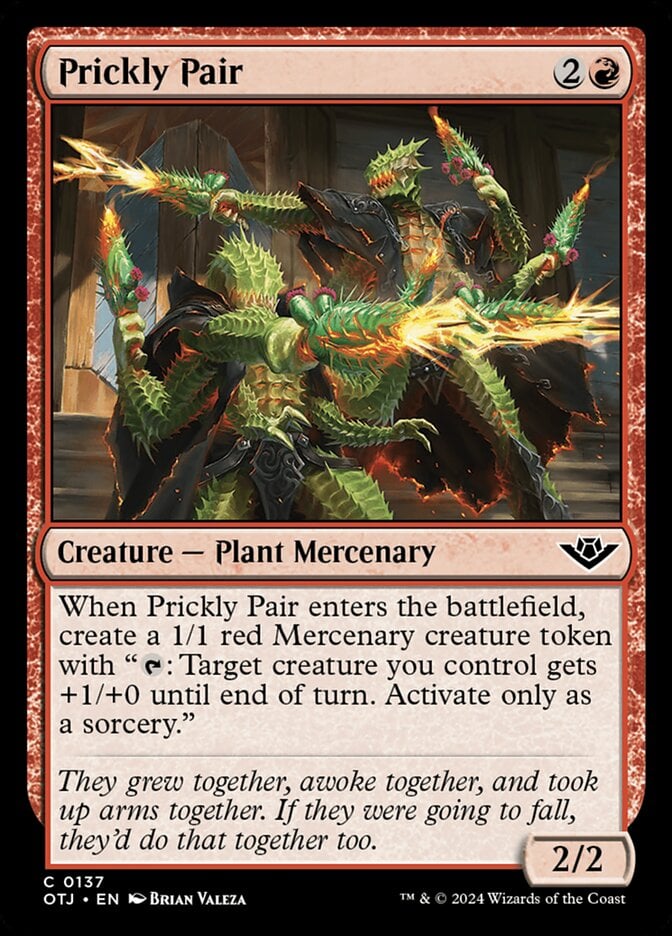
Prickly Pair is a close second to Explosive Derailment, as you’re getting two creatures for the price of one. Both creatures are mercenaries, so this red creature(s) should be a premium common in BR and RW.
#3. Thunder Salvo
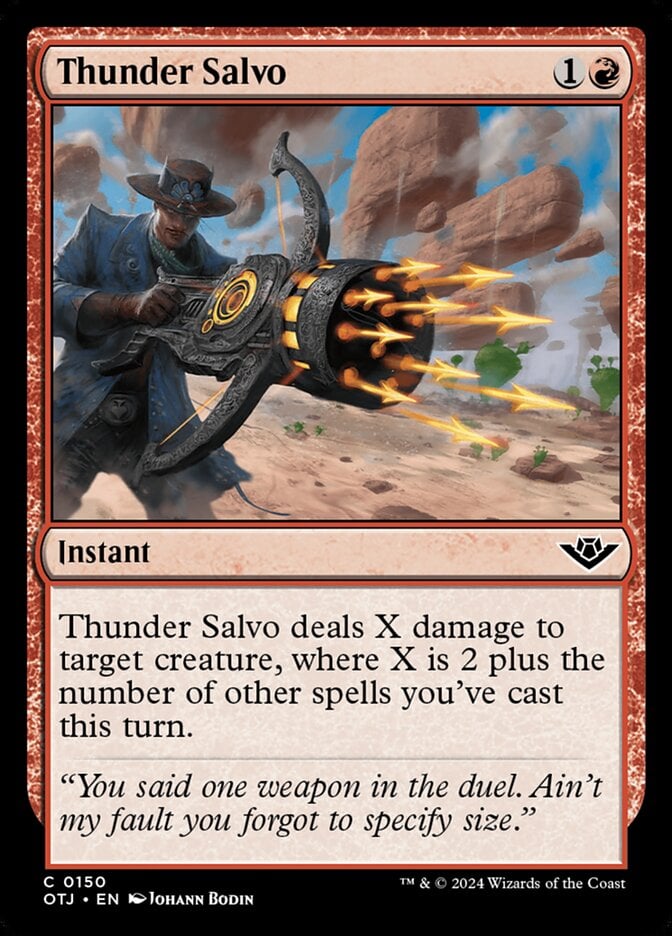
Two-mana Shocks are nothing special, but it doesn’t take much help for this to deal 3+ damage. Best in UR but probably good in every red deck.
#4. Reckless Lackey

Reckless Lackey is a cheap aggressive creature that scales surprisingly well for a hasty 1-drop, as you’ll have the option to chump block + sacrifice it later. Also helps with two-spell cards like Thunder Salvo.
Green
#1. Patient Naturalist
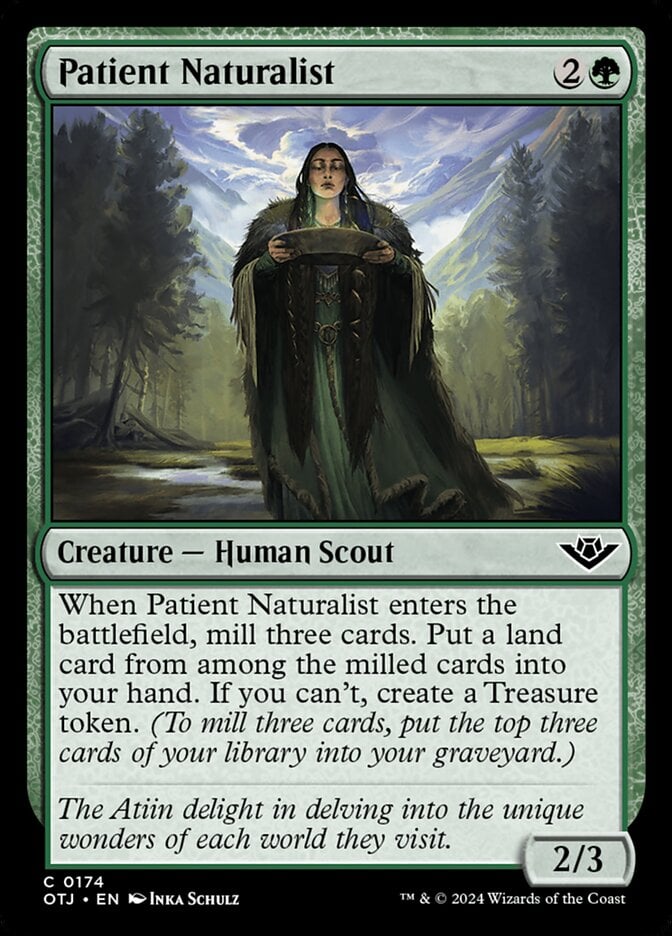
We love our value creatures, don’t we folks? Patient Naturalist is about 80% to draw a full card for you, and even has a rider clause to prevent it from ever fully bricking. The extra self-mill is also valuable in BG.
#2. Throw from the Saddle
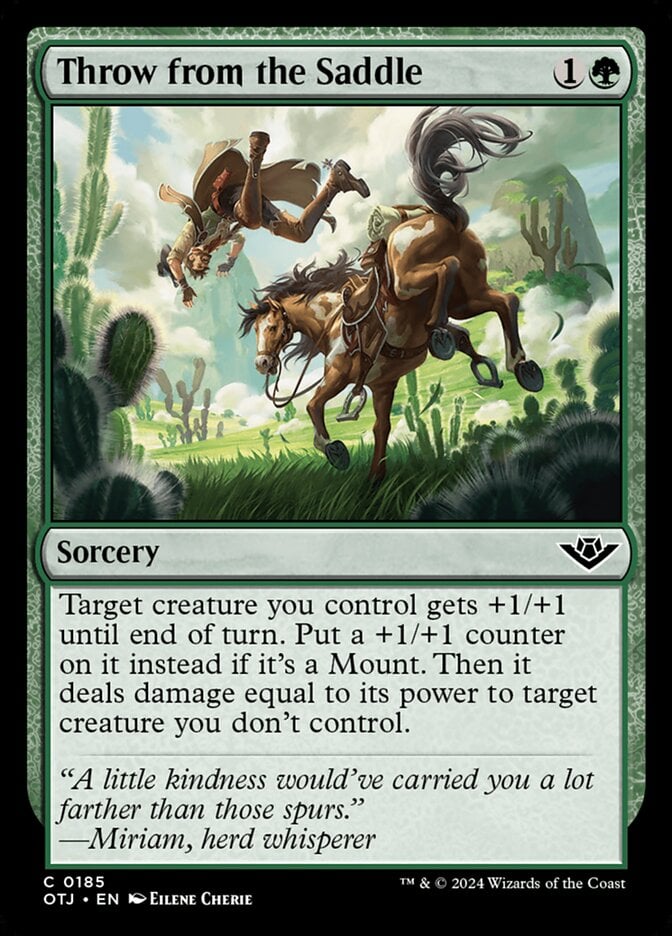
Green’s sole common removal spell is Rapid Bite with substantial upside. You’re always getting at least temporary +1/+1 from green sorcery, but you get to permanently keep the sizing if you target a mount.
#3. Dance of the Tumbleweeds
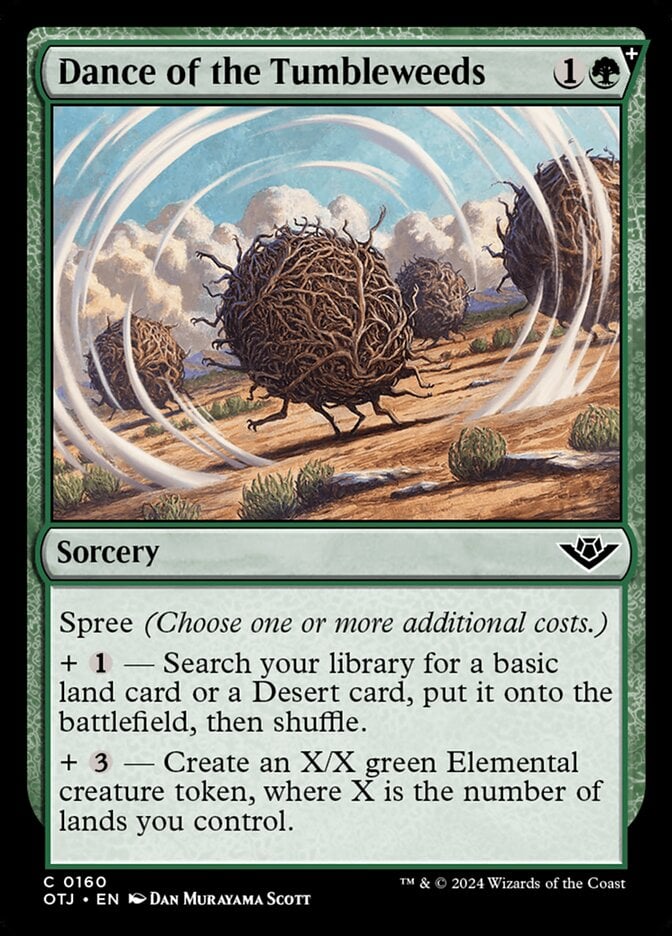
The risk of playing a mediocre ramp spell is substantially lower when it also happens to be a 5/5 (or bigger). Dance of the Tumbleweeds should be a strong role-player in any sort of greedy Gx strategy.
#4. Hardbristle Bandit

I’m not sure how much value you’ll get out of untapping this green creature, but either way it’s an omni-dork in a set with lots of overlapping themes and powerful cards.
Commons to Avoid
WotC prints very few outright bad commons these days. Still, there are a handful of cards I’d recommend against putting in most decks:
- Armored Armadillo: The pump mode is pretty expensive, so this is going to be a Kraken Hatchling for most of the game. Some decks will be fine with this, but try to avoid playing it in aggressive decks.
- Ambush Gigapede: I don’t hate playing a copy if you need some fat, but this isn’t particularly efficient for 6 mana.
- Nezumi Linkbreaker: Great with sacrifice effects like Corrupted Conviction, but don’t play it without synergy.
- Tumbleweed Rising: You can’t play this early on, so this seems like a fair amount of work for what is usually going to be a 4/4 token (or smaller). Still might be good in decks though.
Otherwise, Outlaws of Thunder Junction is remarkably short on bad commons. That’s not to say everything is great, but most cards at least seem to clear the bar of “acceptable filler” for me. Try to optimize your commons for whatever archetype you’re in!
Bomb Rares
This set also has quite a few bombs in it. Let’s put together a list of rares from the main set so that you can see this for yourself:
Archangel of Tithes
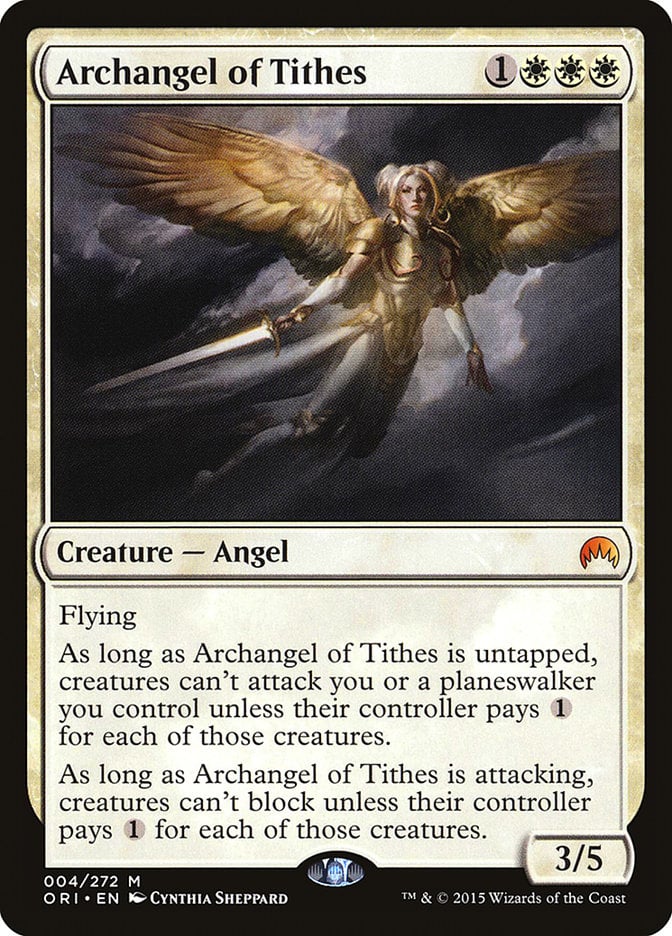
isn’t a small requirement (10+ Plains recommended), but this is a pretty excellent creature. If it sticks around, combat is almost certainly going to be miserable for your opponent.
Geralf, the Fleshwright

Powerful plot/multi-spell incentive. This is efficient enough that getting even just a couple of bears off it should be a game-winning advantage (let alone turns when you go off and get multiple big Zombies).
Jace Reawakened

Mostly you’ll just want to protect this blue planeswalker for card/mana advantage, then finally ultimate it and play a couple of spells (ideally plotted ones) for an insurmountable advantage. Not the most broken planeswalker for Limited, but definitely a good one. It's one of the only planeswalkers in OTJ, but it's not too bad.
Gisa, the Hellraiser

This snowballs remarkably quickly if you can commit some crimes after casting it. Casting just one crime after Gisa effectively leaves you with 10/10 worth of stats in play, so this is definitely a proper bomb.
Terror of the Peaks

This dragon was a hard groan test mythic in Core Set 2021 and should play out the same way here. If you stick this and it doesn’t die, your opponent (and their board) will be at the mercy of any future creatures you play.
Bristly Bill, Spine Sower
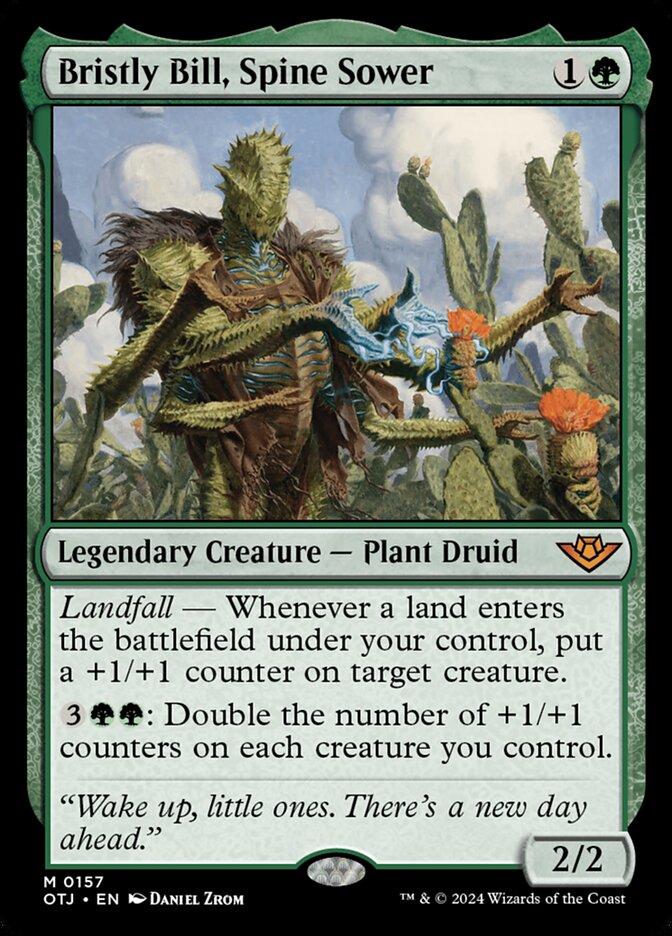
This plant druid is too efficient not to be a bomb and even has a powerful late game ability to boot. There’s nothing fancy here; play Bill, play lands, sling +1/+1 counters thanks to its landfall ability, get value.
Goldvein Hydra
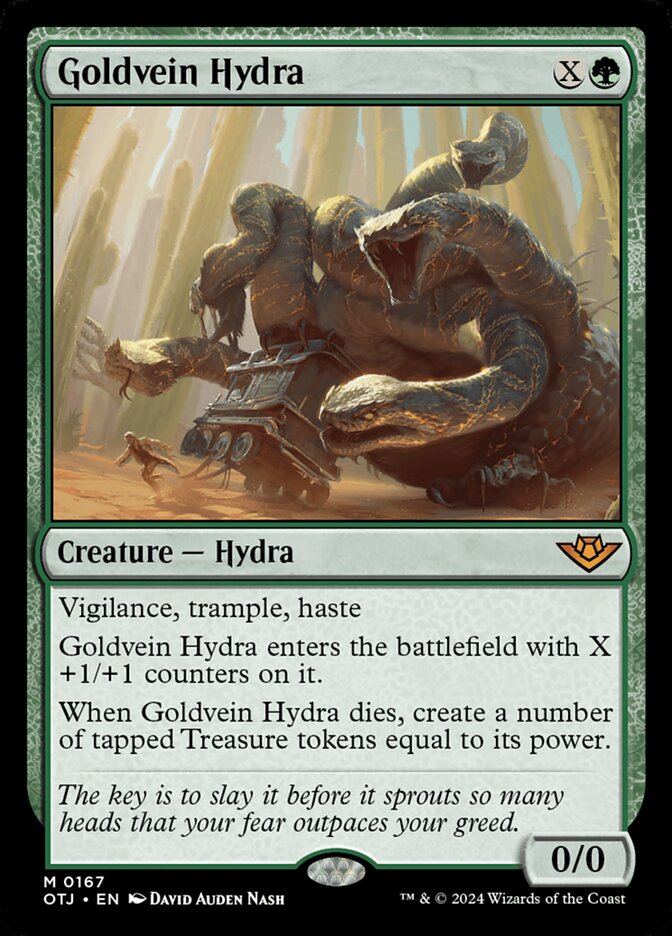
This would be an amazing rate without the death trigger, so I’m pegging this as one of the best bombs in the set. Feel free to splash it as well since it’s only to cast!
Railway Brawler

This is similar to Terror of the Peaks in that it’s a well-sized creature on its own that goes off with future creatures. The main difference is that you can also plot it for cheap, making payoff turns even harder to stop.
Assimilation Aegis
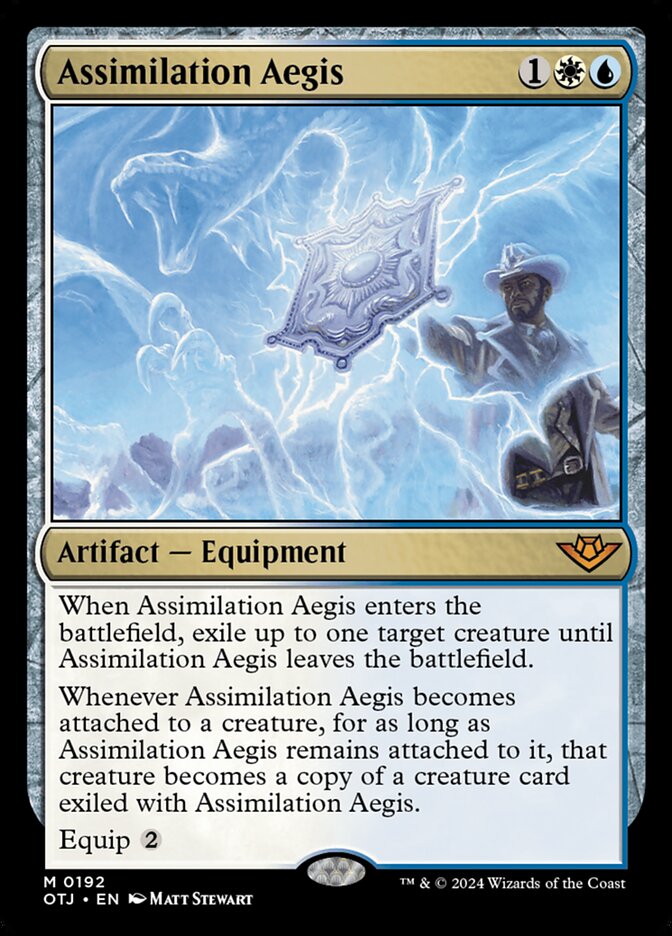
Hitting your opponent’s bomb with this is filthy, but the rate is good enough that you can just use this like a normal removal spell. One of the scariest mythics in the set, and a great reason to hold that Explosive Derailment.
Rakdos, the Muscle

This is a huge flying, trampling demon that can protect itself by sacrificing your other creatures. As if that wasn’t enough upside, doing so will also impulsively draw multiple cards from either your deck or your opponent’s!
Selvala, Eager Trailblazer
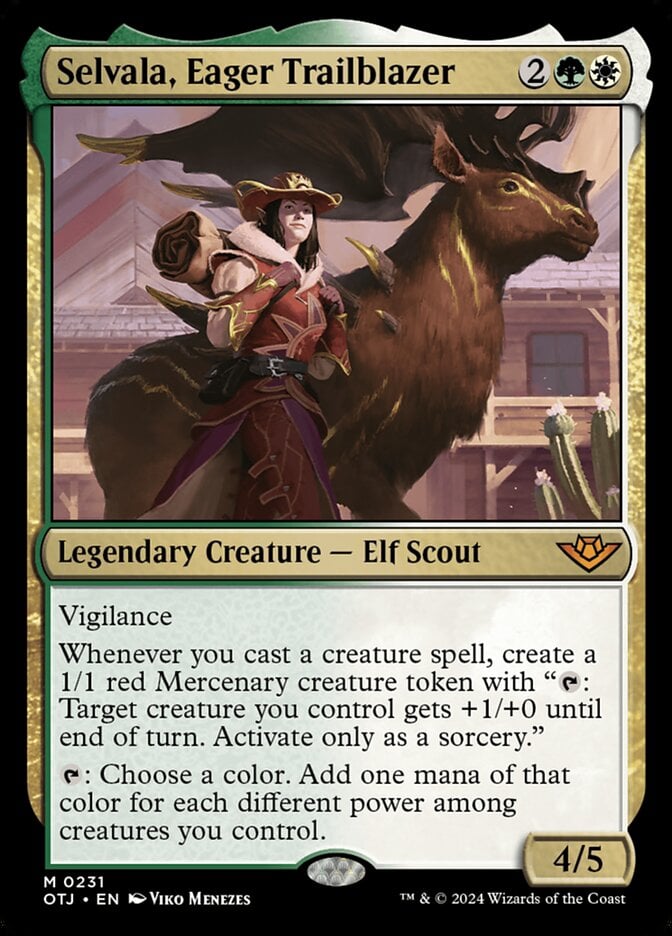
Free Mercenary tokens on a well-statted creature with vigilance is a great deal. Not as broken as some of the other cards so far, but still bomby.
The Gitrog, Ravenous Ride

Huge, hasty frog horror that upgrades your fodder creatures into free cards. Being able to attack immediately is what gives it true bomb status.
Vraska, the Silencer
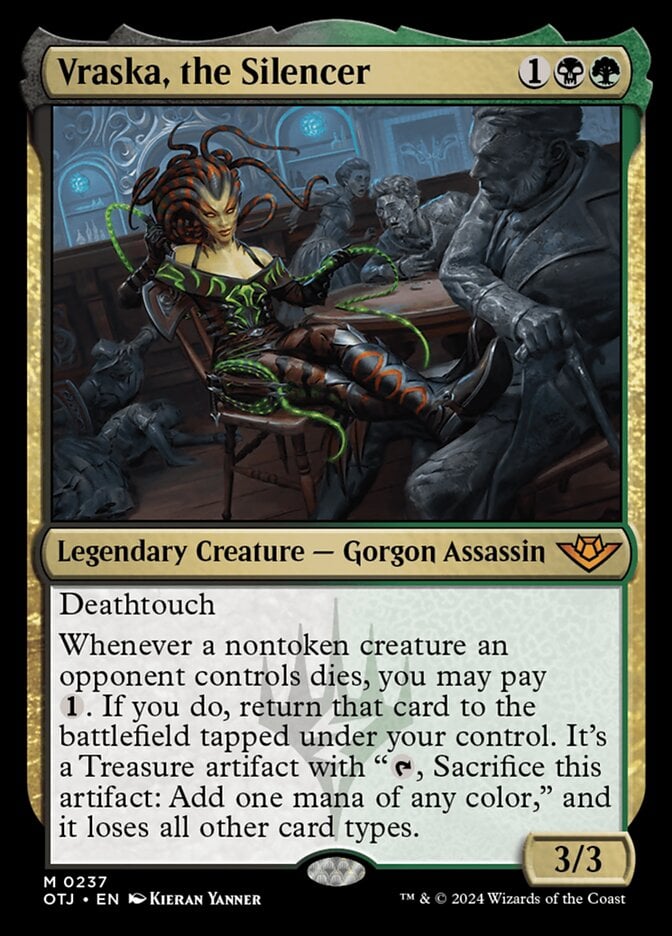
A fairly statted creature on its own that gives your removal spells “kicker” and makes combat difficult for your opponent. Note that creatures you take from your opponents as Treasure don’t lose their abilities.
Oko, the Ringleader
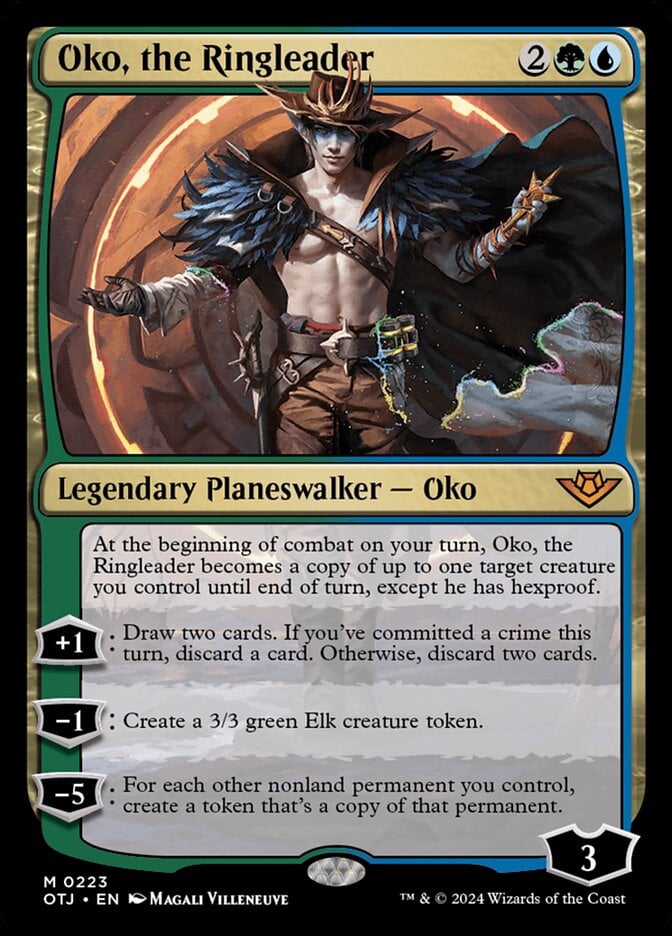
Solid planeswalker that makes 3/3s, draws cards, and can even attack as a copy of one of your creatures. Flexible, powerful, and well worth protecting.
Annie Flash, the Veteran
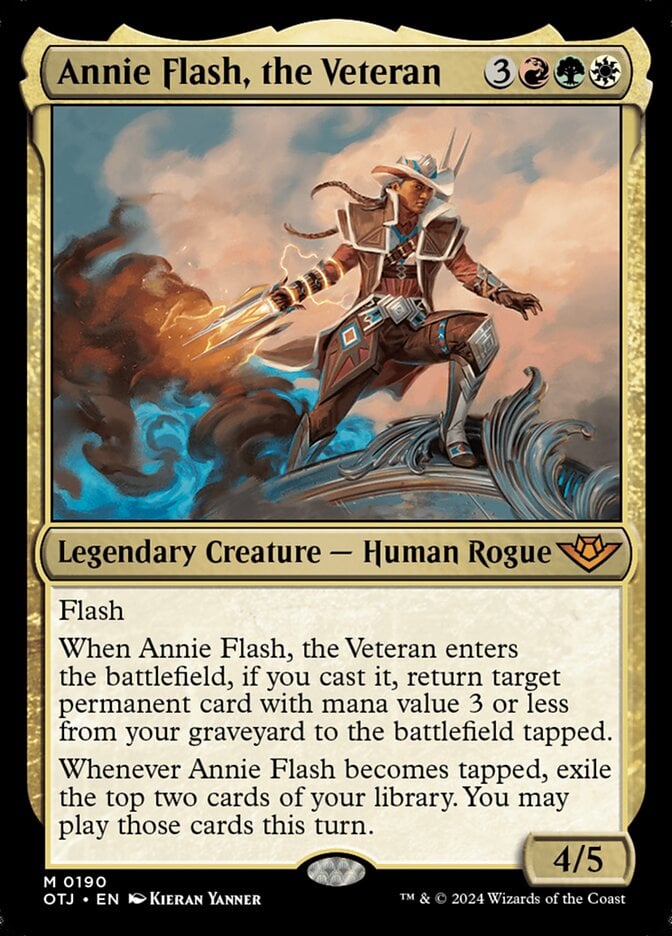
Has a fair shot at eating a creature when you play it (while getting immediate value), then draws two cards as soon as it attacks! An incredible blowout that you hopefully don’t forget when attacking into 6 open mana….
Kellan, the Kid

3/3 flying lifelink for 3 is already an excellent rate, but what truly pushes Kellan, the Kid over the top is its synergy with plotted cards. With just a bit of setup, you’ll be double-spelling and pulling way ahead of your opponent in terms of tempo.
Fortune, Loyal Steed
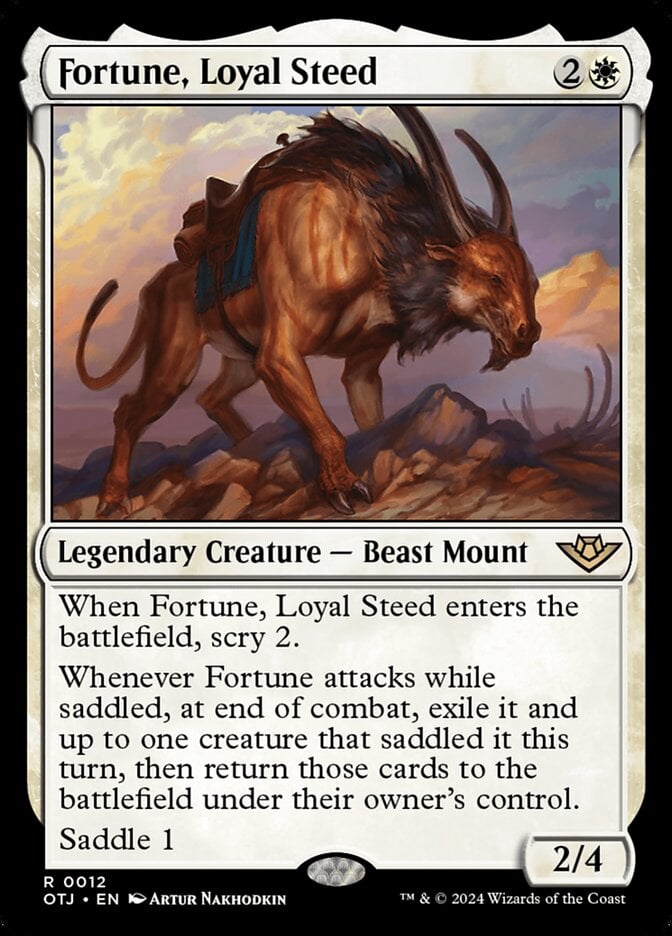
Probably falls a bit short of true “bomb” status, but this is still efficient enough that I’d love to play it. Best when paired with cheap ETB value creatures, but you’re getting to scry 2 over and over again either way. Don’t forget that this effectively gives it vigilance, too!
Stoic Sphinx
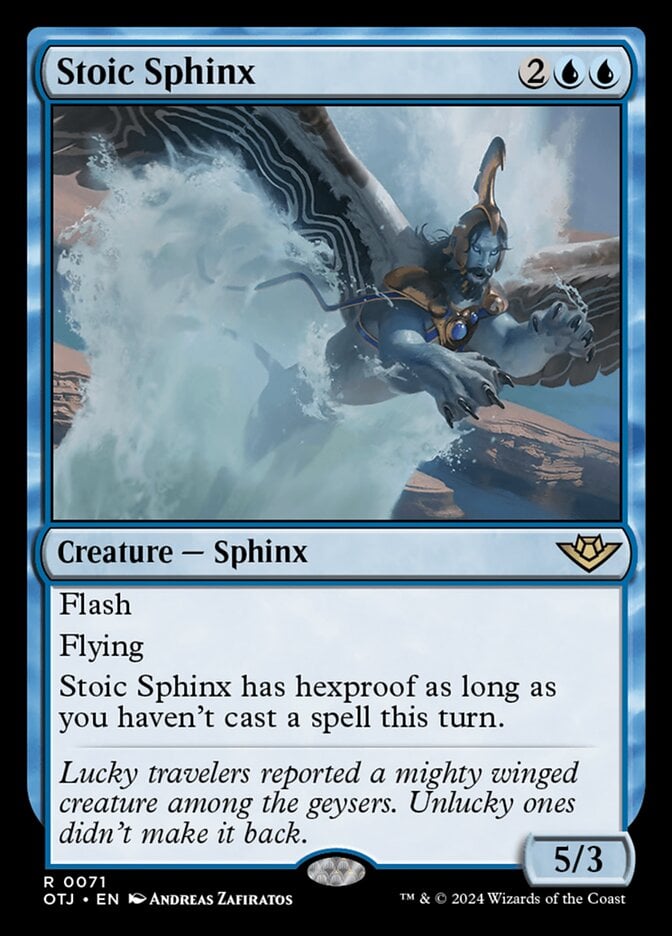
This hits very hard with evasion out of nowhere, even if its protection isn’t the most reliable. This take on hexproof is best against sorcery speed removal like Eriette's Lullaby.
Three Steps Ahead

Definitely one of the best Cancel variants ever printed. This is Cancel plus Catalog plus Mirror Image all stapled into one card.
Calamity, Galloping Inferno

A terrifying 6-drop that can immediately double up on any creature you have (“Repeat this process once”). Excellent with both small value creatures and large, inherently threatening beaters.
Great Train Heist

This is surprisingly practical for an extra combat step card. For , this can be mass Kindled Fury, but the best mode is probably extra combats + Kindled Fury for . Two combat steps with +1/+0 first strike to everything proves a challenge for your opponent to survive!
Hellspur Posse Boss
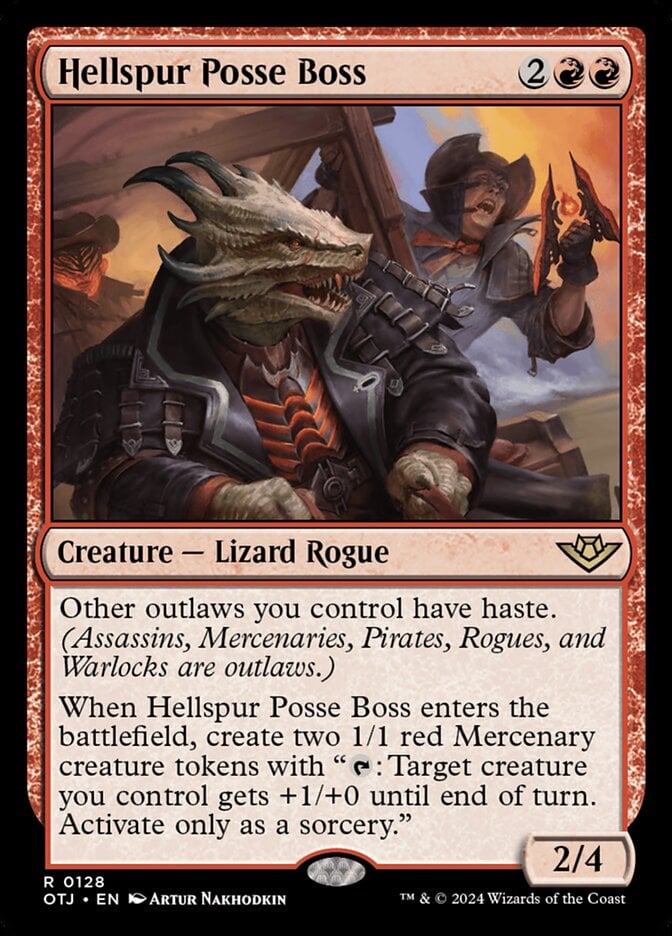
Three bodies for the price of one, plus the Mercenaries can tap immediately and future outlaws you control will have haste. Easily one of the best rares in the set.
Hell to Pay
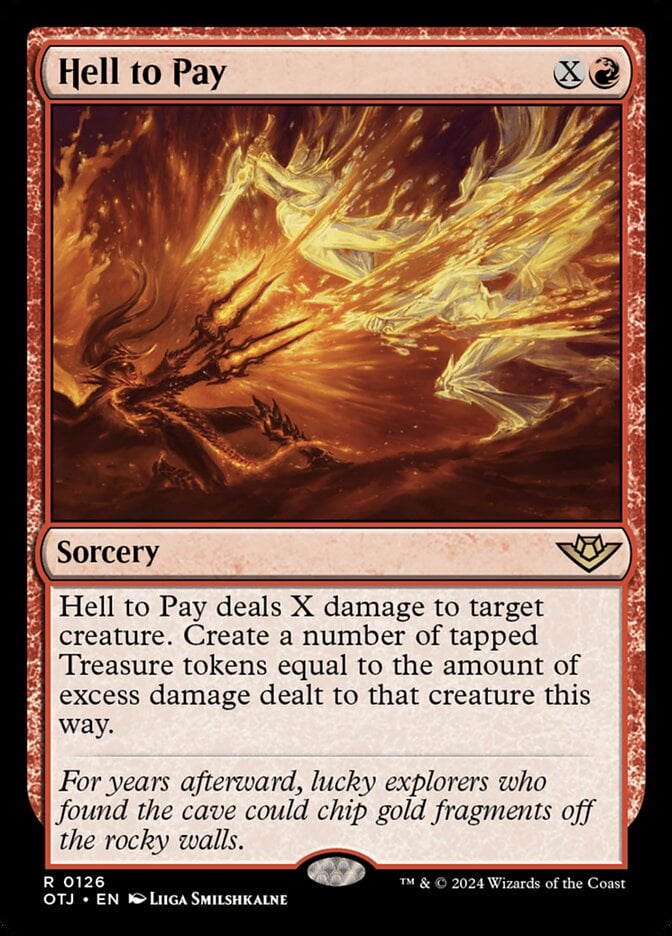
Well-priced removal that rewards you for overkill by granting you Treasures for future use. An excellent card to splash if you can.
Magda, the Hoardmaster

Turning Treasures into 4/4 Scorpion Dragons is a great way to win some games of Magic, so this is well worth building around. Keep in mind that Treasure from any source (not just crimes) works for Magda, too.
Stingerback Terror

Deadly curve topper for an aggressive deck, though you’ll need to dump your hand quickly for this to be well-sized. Plot makes this flexible enough that I’d probably play it in all but the most controlling decks.
Colossal Rattlewurm

Flash if you control a desert? Check. Six power and 5 toughness? Check. Free value when it dies/if you discard it? Sure, why not!
Freestrider Lookout
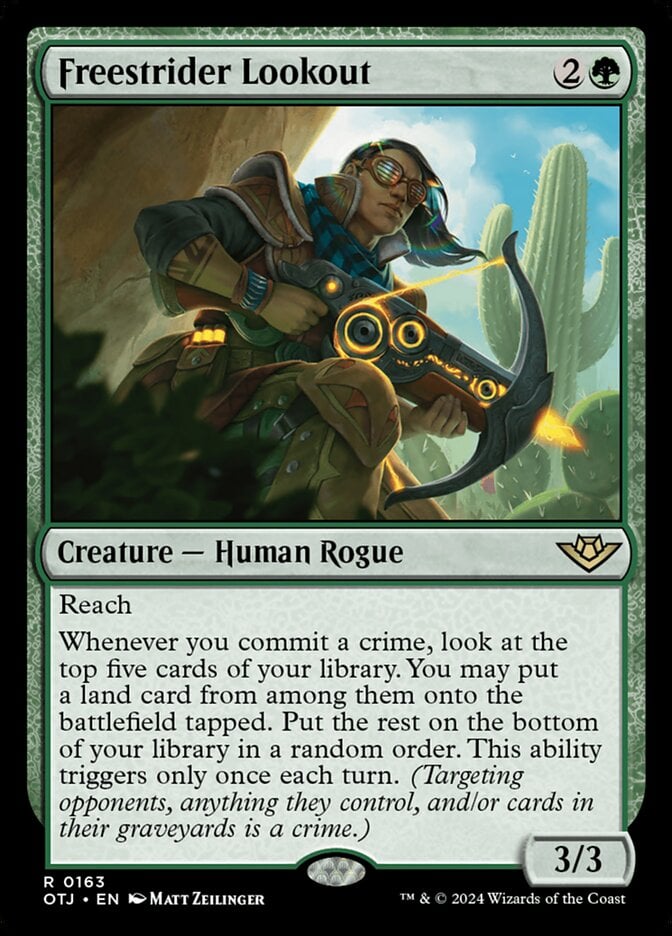
3/3 reach for that is more than 90% to draw you a land (and play it) every time you commit a crime. This kind of efficiency just isn’t seen very often!
Ornery Tumblewagg
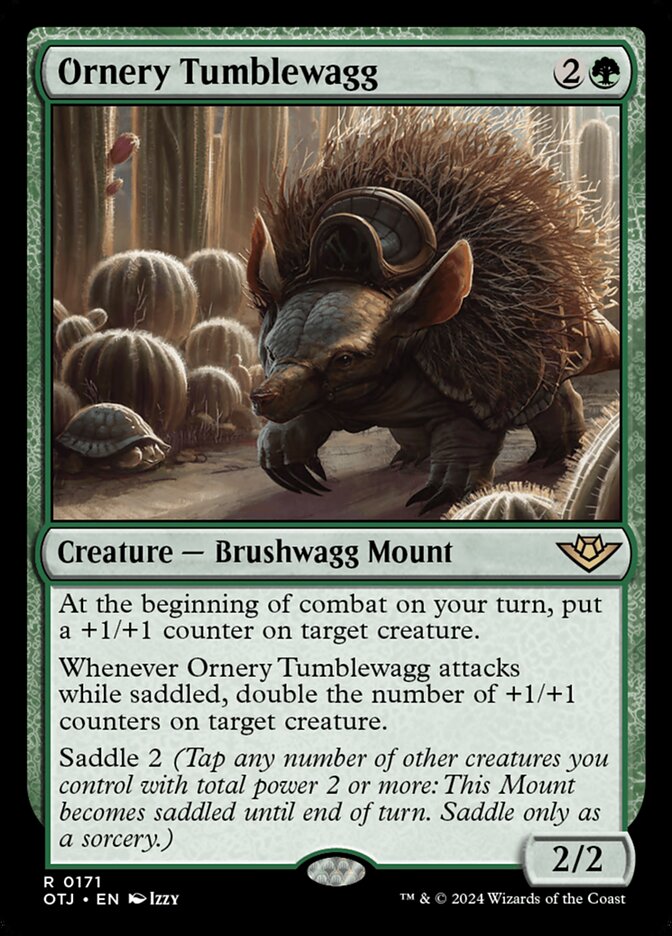
Lunarch Veteran and Siege Veteran were both absurd Limited rares, so I expected great things from this Brushwagg. Doubling the number of counters is powerful, but even without that line you’d still slam this.
Outcaster Trailblazer
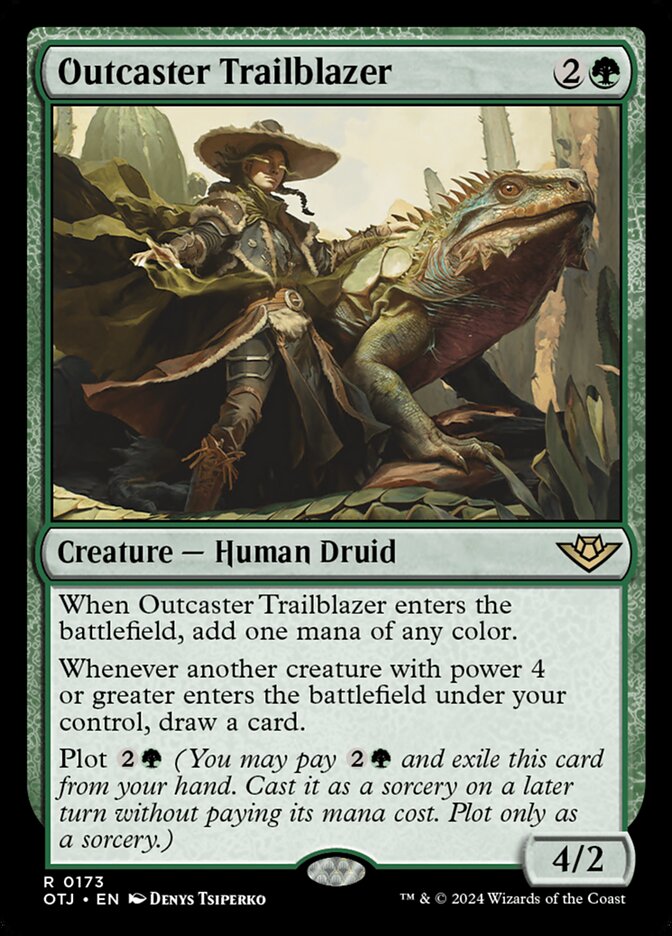
One of the strongest 4+ power incentives in the set. Works best if you can plot it and rush out something like a Cactarantula while drawing an extra card.
Akul the Unrepentant
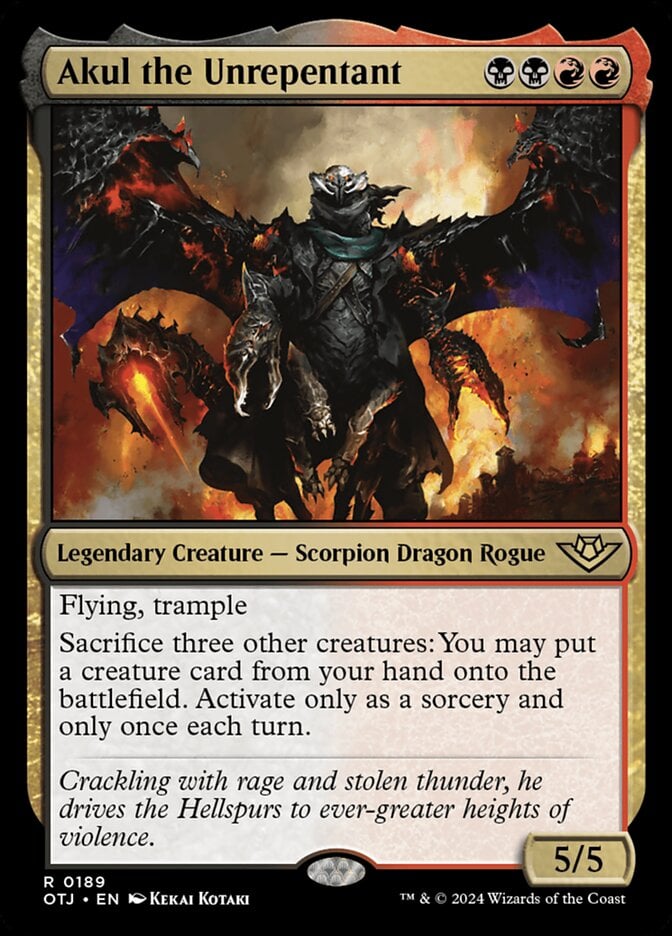
I don’t expect to use the ability much, but 5/5 with flying and trample for 4 is too good of a stat line to pass up. The only drawback here is you definitely need to be BR for its cost.
Laughing Jasper Flint
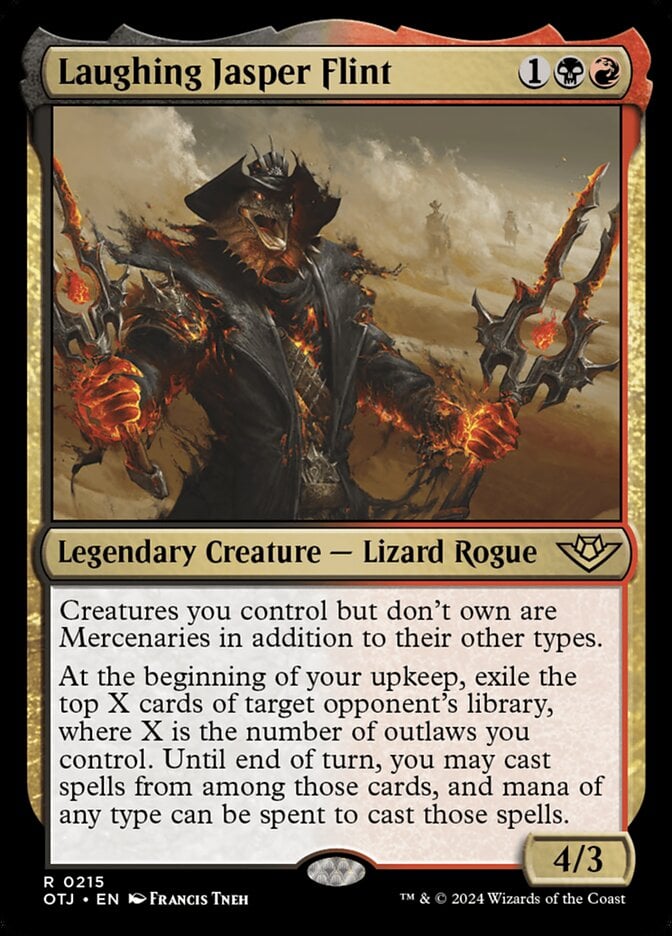
A 4/3 for 3 that draws you an extra card each upkeep would already be a bomb, but this goes even further by scaling with the number of outlaws you have in play. It also makes creatures you take from your opponent into outlaws for some reason, so please play this card!
Roxanne, Starfall Savant
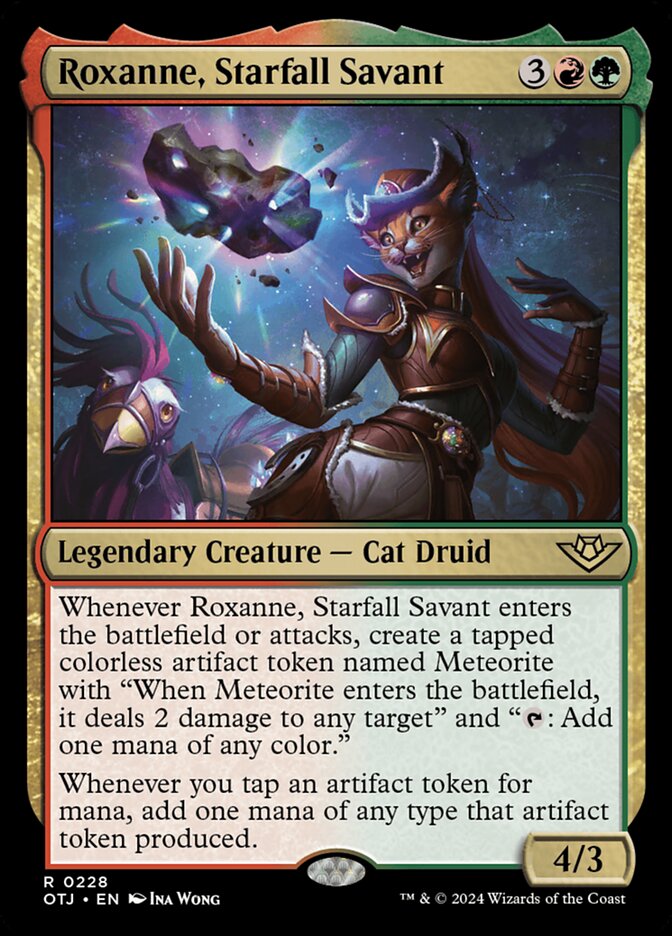
Think Inferno Titan, except instead of a titan it’s a cat with a love for shiny objects. Either way, Roxanne, Starfall Savant is quite the card in Limited, picking off small creatures over and over while ramping you via Meteorite tokens.
Seraphic Steed
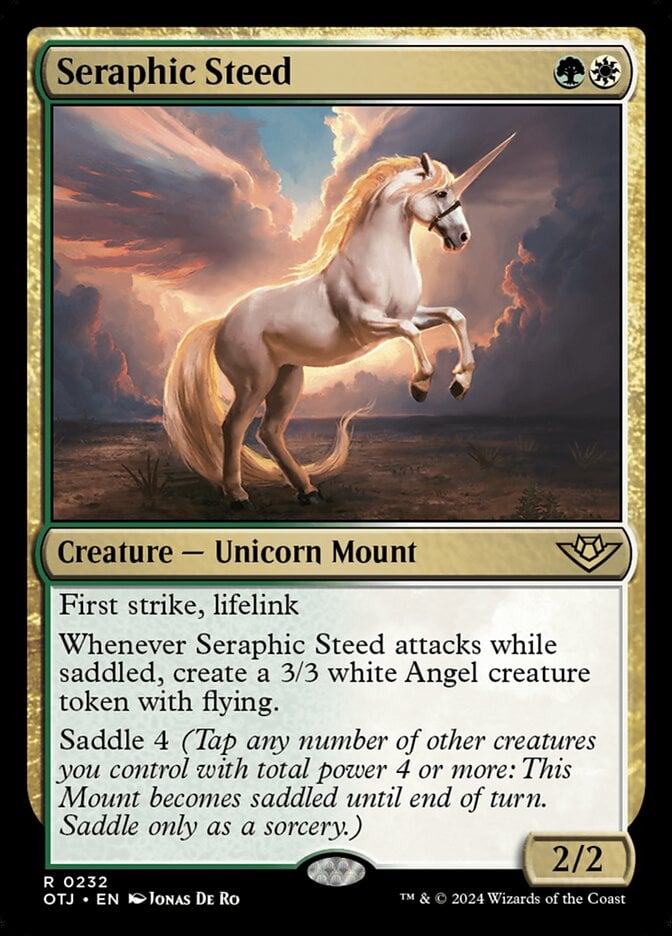
Good base stats + insane potential makes for an awesome rare. Bringing down this turn 3 Drover Grizzly on turn 2 is a nightmare curve for your opponent.
Malcolm, the Eyes

Great base stats + free Clues on every second spell keeps the spells coming. Not particularly fancy but an excellent reason to be in UR.
Bruse Tarl, Roving Rancher

Powerful value creature that draws cards or creates 2/2 Oxen when it enters the battlefield or attacks. The Ox tokens also happen to have double strike as long as Tarl stays out. Should be one of the most commonly splashed rares.
Taii Wakeen, Perfect Shot

This requires a bit of setup, but the base stats are decent and most of the cards it wants are already good. Pair Taii Wakeen with red removal like Explosive Derailment, Thunder Salvo, and Trick Shot for best results. And don’t forget that it turns lands like Abraded Bluffs into Fireballs!
Bonny Pall, Clearcutter
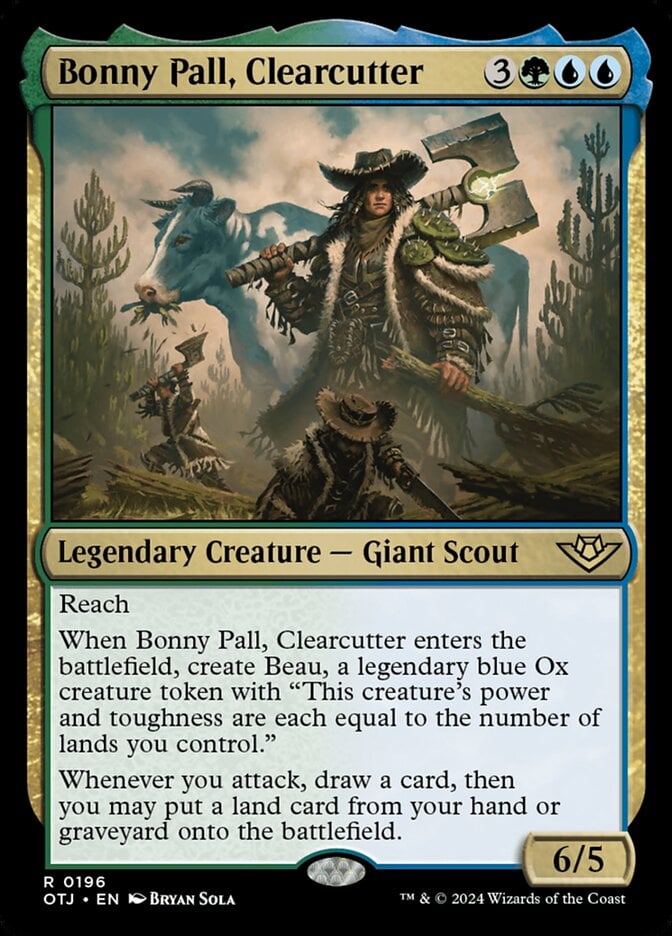
6/5 reach + a 6/6 (or larger) ox that also draws you an extra card whenever you attack (not when “it” attacks). Yeah, this rare is just gross, so definitely play this if you open it!
Marchesa, Dealer of Death

Strong base stats + great, convenient card advantage makes Marchesa, Dealer of Death well worth splashing in , , or . Pairs best with convenient crime cards like Deadeye Duelist and removal spells.
Breaking News
Mana Drain
Not sure why this is in the set, but hey, why not? Completely broken card that can instantly win the game if you counter something important then turbo out a big spell. Even if you can’t, it’s still Counterspell at worst.
Overwhelming Forces
Eight mana for a “you win the game” black sorcery, more or less. Not for every deck, but this is an effect potentially worth building around.
Crackle with Power
Another path to 8 mana “you win the game”, this time in the form of 10 direct damage to two targets from a red sorcery. Also acceptable for 5 mana as a deal 5.
Fractured Identity
Ridiculously broken Azorius card that exiles your opponent’s best thing and then gives you a copy of it. By all means, try to splash/play this if you open it!
Oko, Thief of Crowns
Somehow Mana Drain is only the second most broken card in the set! You won’t see Oko, Thief of Crowns often, but this is an absolutely top-shelf planeswalker. Make some Food, make some Elk, make your opponent regret playing this game.
Mindslaver
Similar to Overwhelming Forces in that this is an absurdly expensive effect that should also win you most games on the spot. I’m more than willing to give this legendary artifact a try in Sealed.
Electrodominance
Solid Fireball variant that costs 1 mana more but also lets you play another spell at instant speed. This has good synergy with “two or more spell” cards.
Pest Infestation
Even without destroying artifacts or killing enchantments, you’re getting a pretty strong rate here; 3 mana for 2 tokens, 5 mana for 4 tokens, and so on. Anytime you hit a Mystical Tether with this green sorcery, it’ll feel like cheating!
Primal Might
Terrifying fight spell that could kill your opponent out of nowhere, but also works as cheap interaction since you’re never forced to pay X (base rate is Prey Upon). Plays best with trample creatures for surprise kill potential.
Cruel Ultimatum
Seven mana “you win the game”, albeit with extremely specific color requirements in a barely supported color trio. Most decks won’t be able to play this Grixis sorcery, but I hope to pilot one of the few that can!
The Big Score
Collector’s Cage
Extremely powerful rare that can cheaply improve your creatures overtime while building up to freely cast whatever you hid under it. Easy candidate for the best rare from The Big Score.
Oltec Matterweaver
Good stat line for a blocker that continuously provides extra fodder whenever you cast a creature. You won’t be copying artifact tokens much, but the Gnomes make for great sacrifices.
Harvester of Misery
Excellent creature + board wipe combination that can also be cheap spot removal in a pinch. The fact that you can then retrieve it with various Raise Dead effects puts this completely over the top.
Hostile Investigator
Why 2-for-1 your opponent when you can 3-for-1 them instead? This is a filthy value creature that gets even better with other discard effects, but it needs no help to be exceptional.
Bristlebud Farmer
A well-costed beater that comes with two free Food tokens, which can be upgraded into a full card on attack.
Sandstorm Salvager
Great on its own as a 1/1 + 3/3 for only , but it gets even better when combined with other creature tokens due to its mass-pump ability.
Vaultborn Tyrant
Huge dumb dinosaur that gains life, draws cards, and replaces itself with itself when it dies. Absolutely worth getting to 7 mana for.
Loot, the Key to Everything
Tiny and useless in combat, but the card advantage is significant enough that I still could see this being good. With just one other creature in play, you’re drawing an extra card each turn.
Lost Jitte
Umezawa's Jitte comparisons are highly unflattering, but this is still a pretty decent piece of equipment. It’s very cheap but makes blocking difficult late game, provides extra mana, and has permanent sizing in combat.
Nexus of Becoming
Expensive bomb rare that puts you up a card each turn, while giving you the option to play artifacts and creatures for free as 3/3 golems. This is the kind of card that’s generally going to be much better in Sealed than Draft.
Sword of Wealth and Power
Protection from instants and sorceries is pretty dramatic protection in Limited, as the majority of removal spells fall into those two types. The combat trigger on this sword is powerful but inconsistent, and it mostly wants to play with removal spells.
Mediocre Rares
Alas, we can’t all be Bonny Pall, Clearcutter. Here are some rares that are either not worth playing or notable enough to merit explanation:
- Another Round: You’ll need a ton of ETB value creatures for this to be worth playing. It’s not impossible to make use of (at common: Peerless Ropemaster, Holy Cow, Vault Plunderer, Prickly Pair, Patient Naturalist, Spinewoods Paladin, Oasis Gardener, etc.), but most decks shouldn’t bother.
- High Noon: This enchantment actually does a tremendous job of hating on plot decks and can be sacrificed for powerful removal/burn later on. I think it’s more than playable, but its unique utility as a hate card merited its inclusion here. Just make sure you’re at least splashing red so you can blow this up.
- Step Between Worlds: Much better when plotted than hard cast, as plot means you’ll get the first crack at using your fresh seven. Still doubt this is worth the risk for most decks though.
- The Key to the Vault: This is a very powerful reward for when you’re dealing combat damage to a player, but it also requires a full 5 mana worth of setup and provides zero help in connecting. I might play it with enough fliers or in a good matchup for it, but it’s an extremely volatile card.
- Pitiless Carnage: Requires much more setup to use than your average Corrupted Conviction style card. Best with tokens/Treasures/etc., but it’ll often be overkill.
- Eriette, the Beguiler: 4/4 lifelink for 4 isn’t bad, but you’ll be hard-pressed to make it anything more than that. There aren’t many auras in this set at all, and basically none of them work especially well with its ability. One of the few uses I could think of is being able to grab your opponent’s stuff with Stop Cold for use as sacrifice fodder.
- Obeka, Splitter of Seconds: Really exciting EDH card, but definitely not great in Limited. The base stats are weaker than Eriette, the Beguiler, and the ability is similarly almost impossible to make use of.
I won’t belabor on every bad rare from Breaking News or the Big Score, but trust me that many of them (i.e., Surgical Extraction, Dust Bowl, Greed's Gambit, and Torpor Orb) are 100% unplayable.
Playing the Set
We’ve covered a lot of ground so far, but I still wanted to touch briefly on some general pointers for actually building your Sealed pool and playing the set.
Splashing
This set has quite a bit of fixing in it, so splash away! Most options for fixing are either green cards or weaker colorless cards like artifacts and lands. In total, your options for common fixing are:
Mine Raider
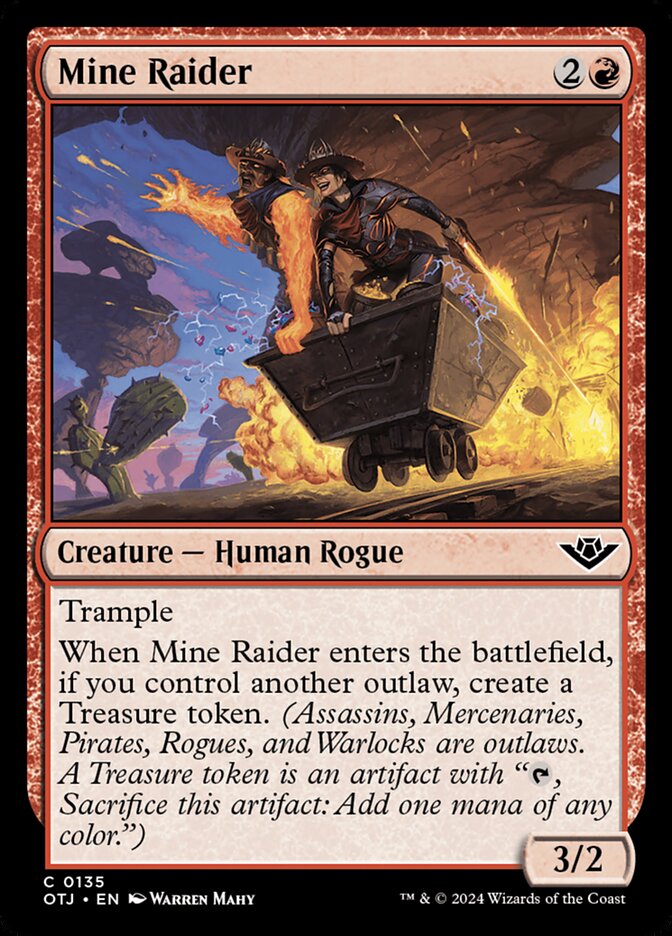
Free Treasure on your filler creature that requires other outlaws to get value. Only applies to narrow splashes without activated abilities.
Dance of the Tumbleweeds

Strong greedy common for green-based ramp strategies that makes desert synergy easier to use.
Hardbristle Bandit

Universal dork that’s weak in combat and vulnerable to removal.
Patient Naturalist

This isn’t hard fixing, but it can still help make splashes work by digging you closer to whatever basic you might be missing.
Gold Pan
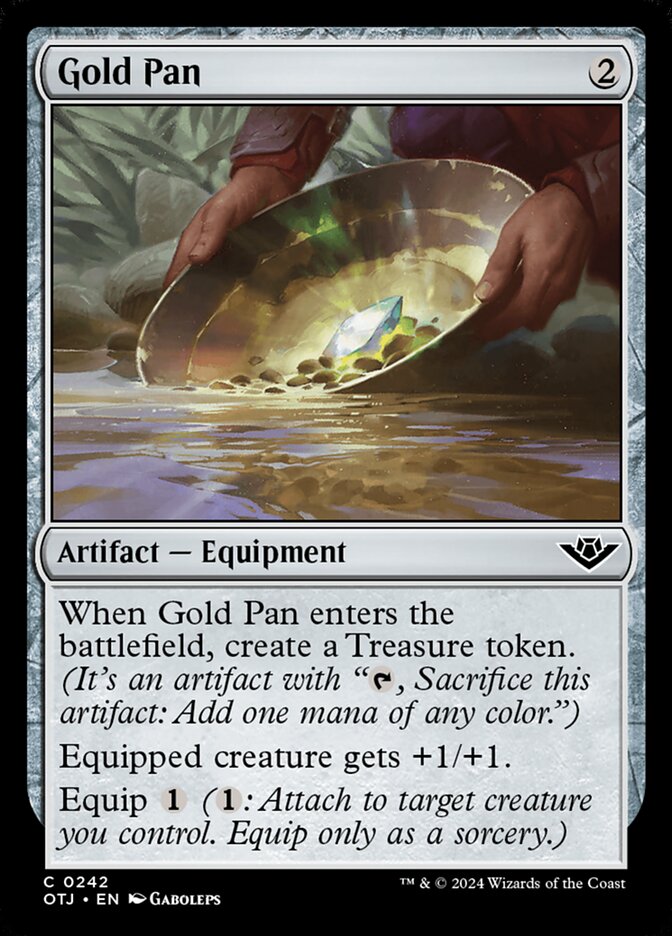
Short Sword for 2 mana that also comes with a Treasure token to make up for that. A bit of an odd fit, but good for creature decks that still want to splash a powerful card or two.
Oasis Gardener
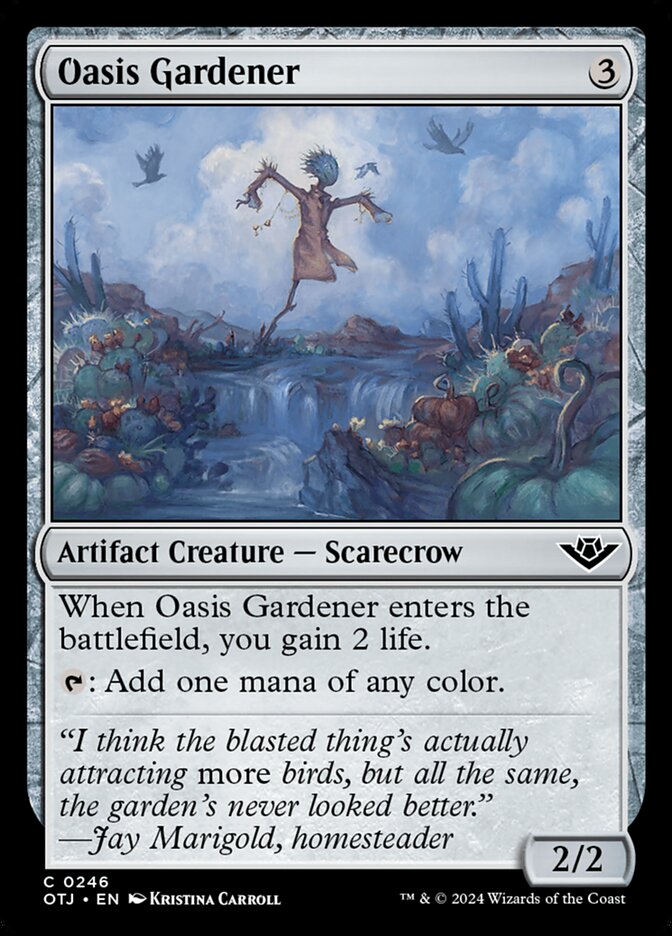
Gray Ogre dork isn’t the best rate, but the added 2 life should make this feel less bad to play. I’d expect this to be a solid role-player in multicolor piles and actively avoided in anything aggressive.
Silver Deputy
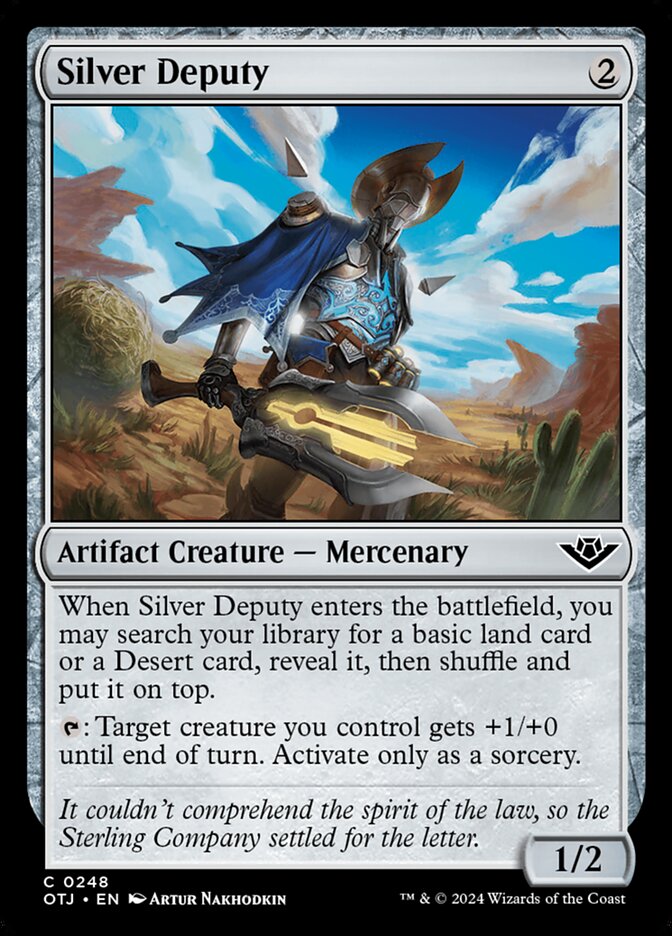
I’d probably prefer Campus Guide to this, as 2/1 is a superior stat line to 1/2. This can’t trade with bears, though it’s a mercenary and does have the same ability as tokens. Probably best in aggressive decks that still want to splash.
The “Pingin' Deserts” cycle
There are ten of these in total, one for each 2-color pair:
- Abraded Bluffs (Boros )
- Bristling Backwoods (Gruul )
- Creosote Heath (Selesnya )
- Eroded Canyon (Izzet )
- Festering Gulch (Golgari )
- Forlorn Flats (Orzhov )
- Jagged Barrens (Rakdos )
- Lonely Arroyo (Azorius )
- Lush Oasis (Simic )
- Soured Springs (Dimir )
They’re solid mana fixers that also provide a desert for cards that care about that sort of thing. Note that they have a chance to replace the basic in each pack.
Conduit Pylons
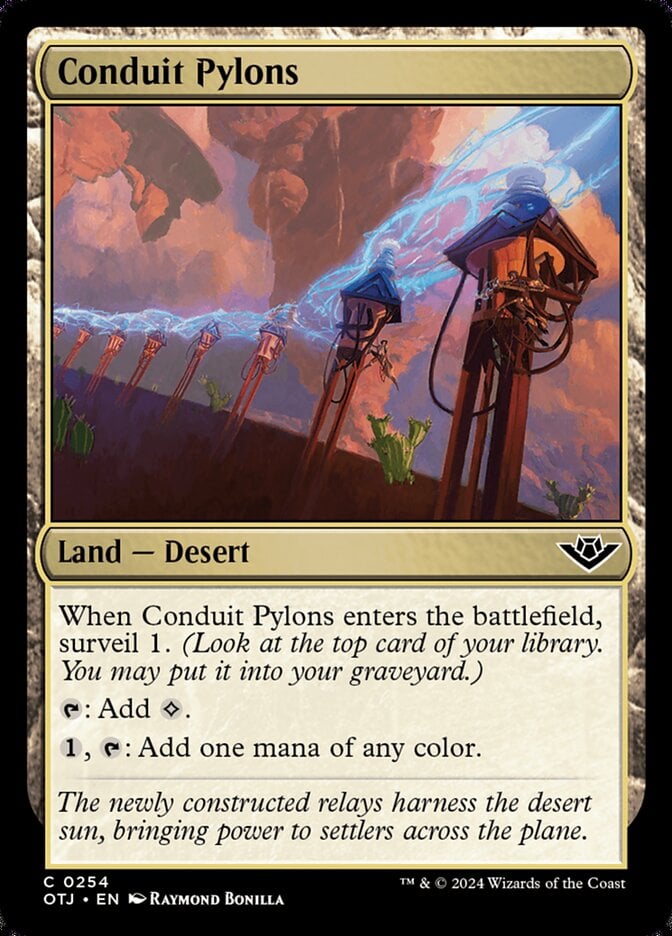
Crystal Grotto grew on me, so it’s nice to see it return in desert form. The first copy of this card tends to be good in most decks, but it’s generally poor in multiples.
Mirage Mesa

Uncharted Haven also gets the desert treatment this go-around. This is a strong all-purpose fixer that can be whatever color you need it to be that game.
Land Counts
Outlaws of Thunder Junction seems like a fairly standard 16-17 land set to me. There aren’t many overt mana sinks in the set’s mechanics, and themes like UR spells emphasize spell density as well. More proactive strategies may often find themselves shaving off a land to fit another spell in the deck. Some common land configurations you might see are:
Two Colors No Splash (17 lands)
8 lands of primary color + 8 lands of secondary color + one other land like Conduit Pylons or Mirage Mesa.
Two Colors No Splash (16 lands)
Either 8 lands of primary color + 8 lands of secondary color, or 7 lands of each plus two other lands like Abraded Bluffs.
Two Colors with a Splash (17 lands)
7 lands of primary color + 7 lands of secondary color + Mirage Mesa, Conduit Pylons, and a relevant tap land. The deck’s 23 would also ideally have a couple of fixers.
True Three Color (17 lands)
We’ll say this is a Grixis deck built around Cruel Ultimatum and Marchesa, Dealer of Death. You’ll want 4 Island, 4 Mountain, 6 Swamp, and as many dual lands, Mirage Mesa, and colorless mana fixers as you can.
Five Color Green Stuff (17 lands)
7-9 Forests, at least one of each basic for the colors you’re playing, plus as many dual lands and Mirage Mesa as possible. The rest of the lands in these decks usually prioritize whatever your second most dense color is (besides green).
Seven Steps for Sealed Success!
- Open your packs and sort your cards by rarity and color. Note any exceptional cards (bombs, removal spells, multicolor cards, mana fixing, etc.).
- Set weak cards aside, then assess which of your colors are deepest. Look for synergistic clusters of cards, especially ones that play off the set’s major ten 2-color archetypes (i.e. Ertha Jo, Frontier Mentor plus Form a Posse).
- Start laying out builds and try to include your best cards. Your baseline should be two colors with at least 7 sources for each primary color (more is better).
- Consider whether splashing makes sense for your pool. The best cards to splash are usually bombs, removal spells, or sources of card advantage.
- Keep working on your deck, aiming for a good balance of bombs, removal, card advantage, and mana curve. If you’re worried about the clock, you can mitigate time anxieties by having a baseline done early (i.e. “I know I’m playing UG for Bonny Pall, Clearcutter, so I’ll lay out Bonny + my best playables first…”)
- Settle on a final product, then battle it out!
- And don’t forget that you can use Draftsim's OTJ Sealed pool generator to practice the set before Friday.
Round Up

Loan Shark | Illustration by Wayne Reynolds
And with that, this guide has come to a close! Good luck with your prerelease this weekend. I’ll see you back here in two weeks for the Draft Guide, and in the meantime please feel free to drop by the Draftsim Discord if you have any questions.
Until then, may you always open whatever rares your heart desires!
Follow Draftsim for awesome articles and set updates: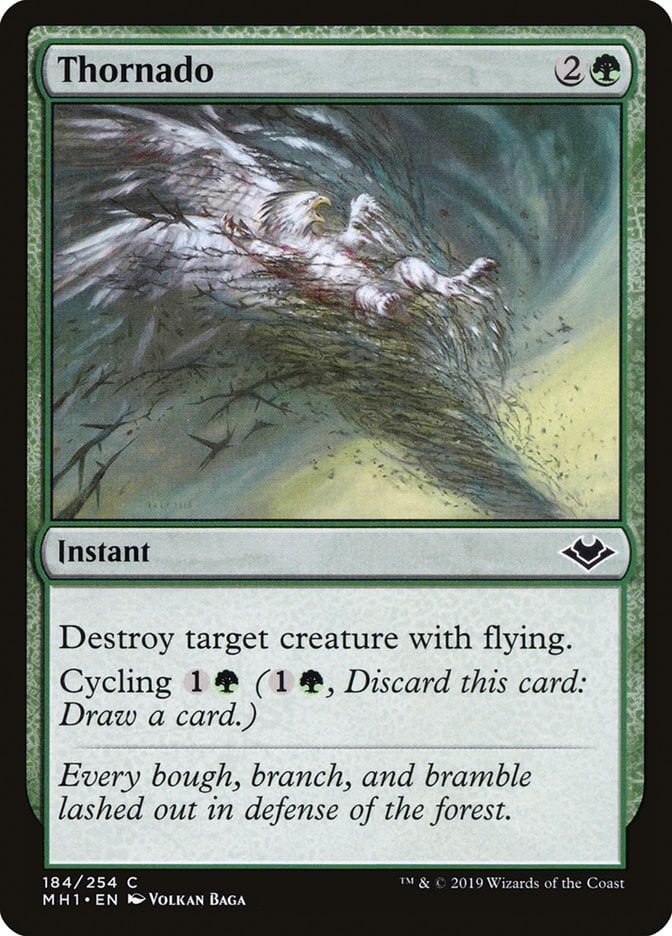
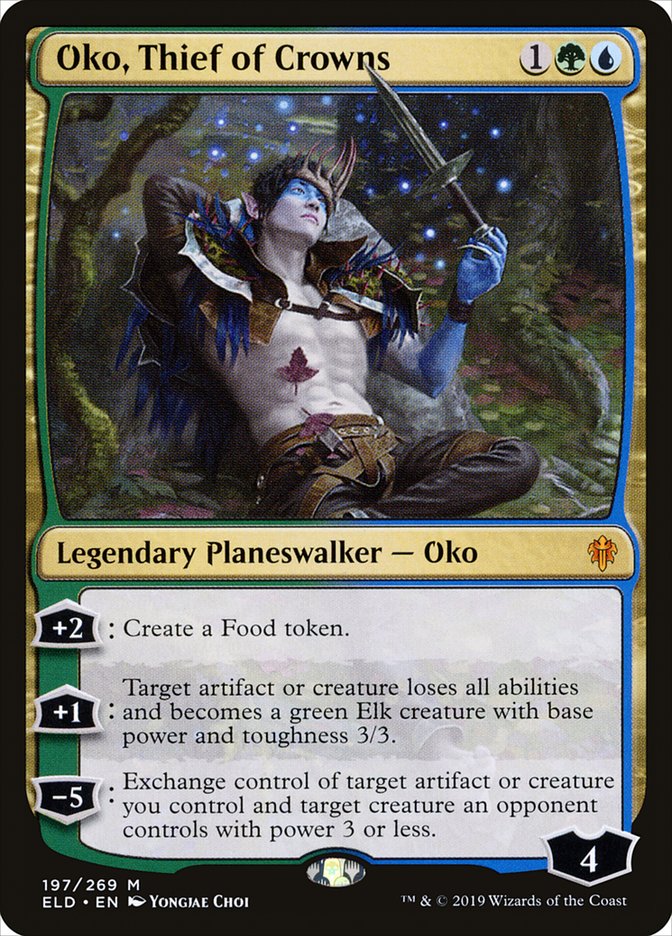
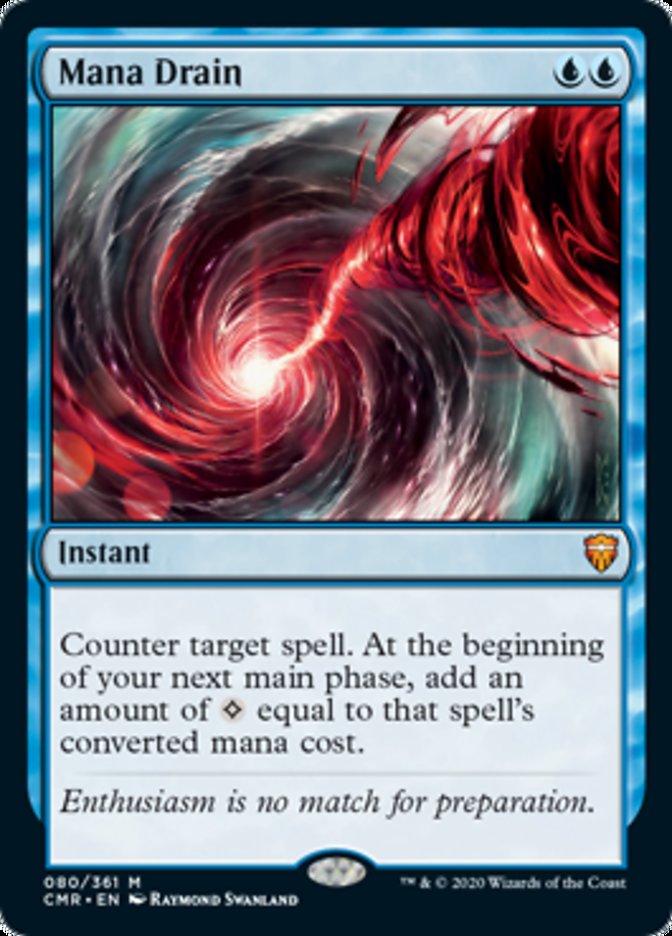
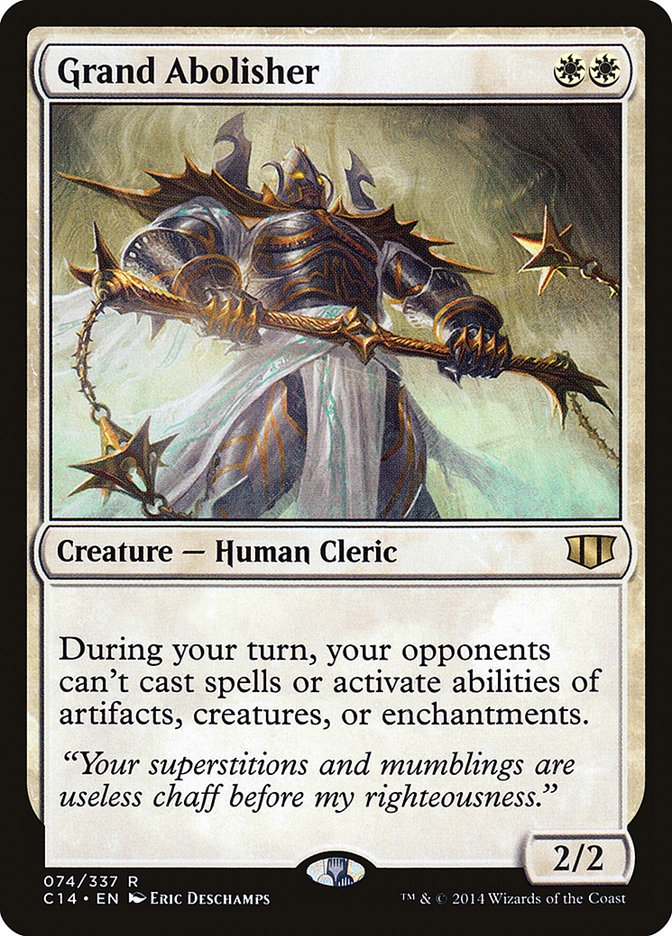

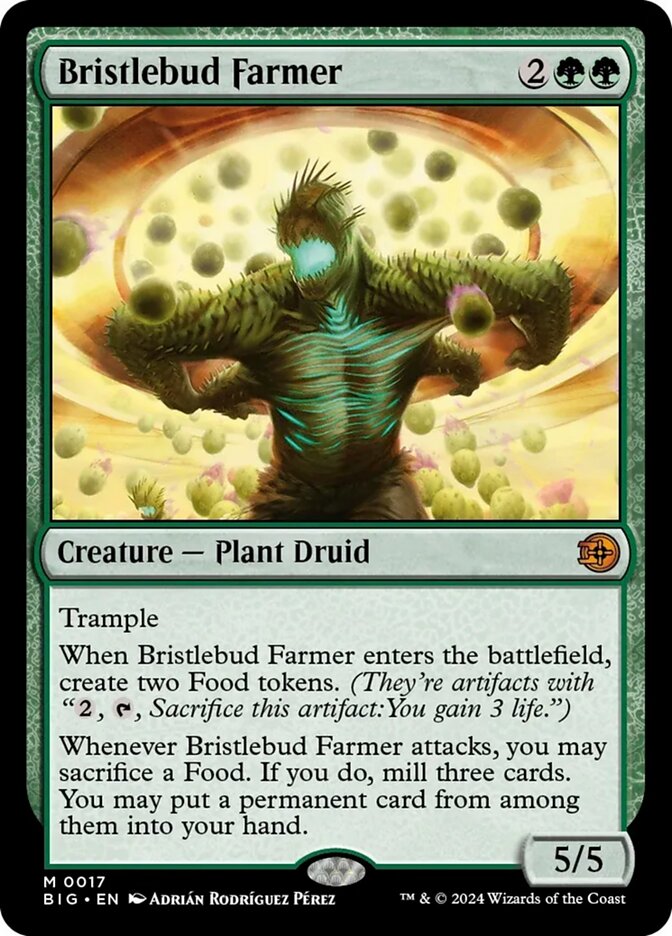
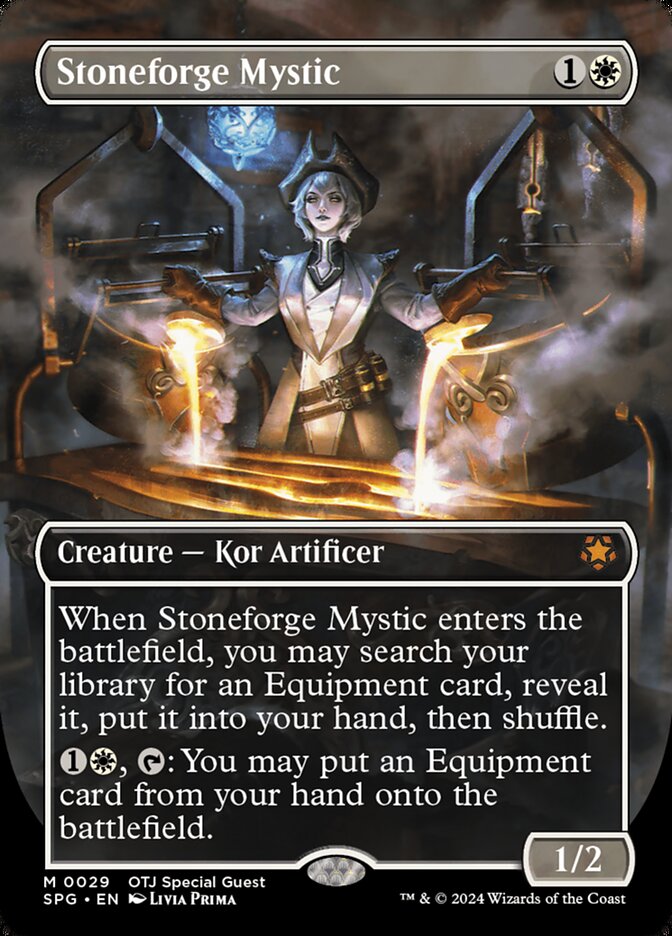



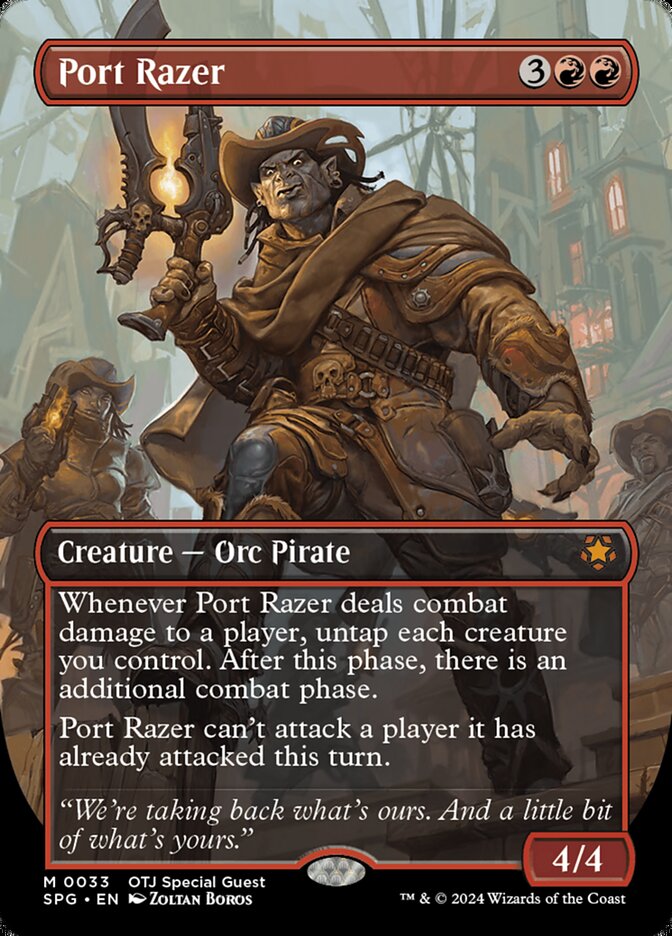
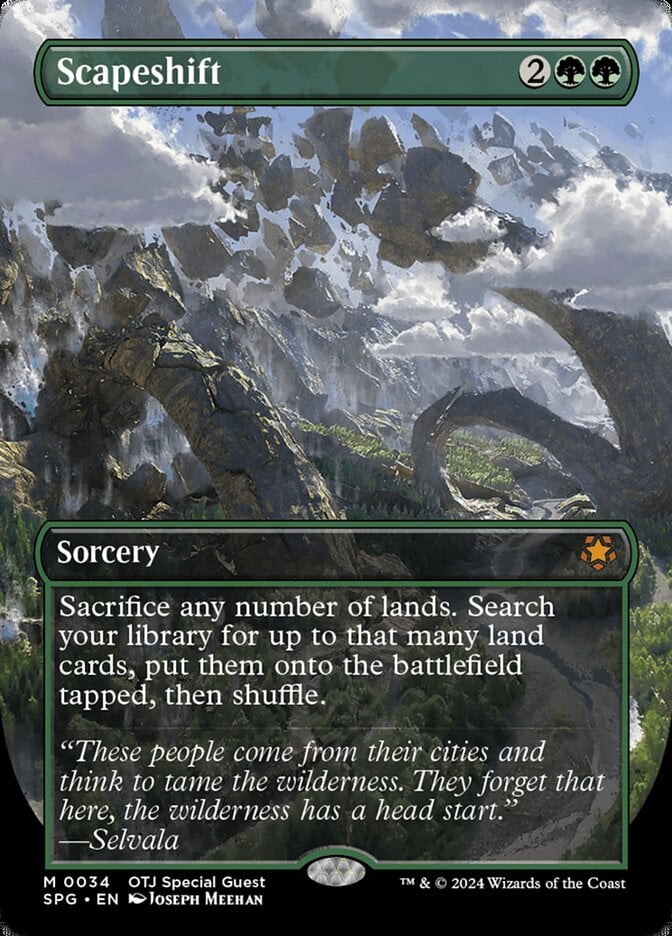
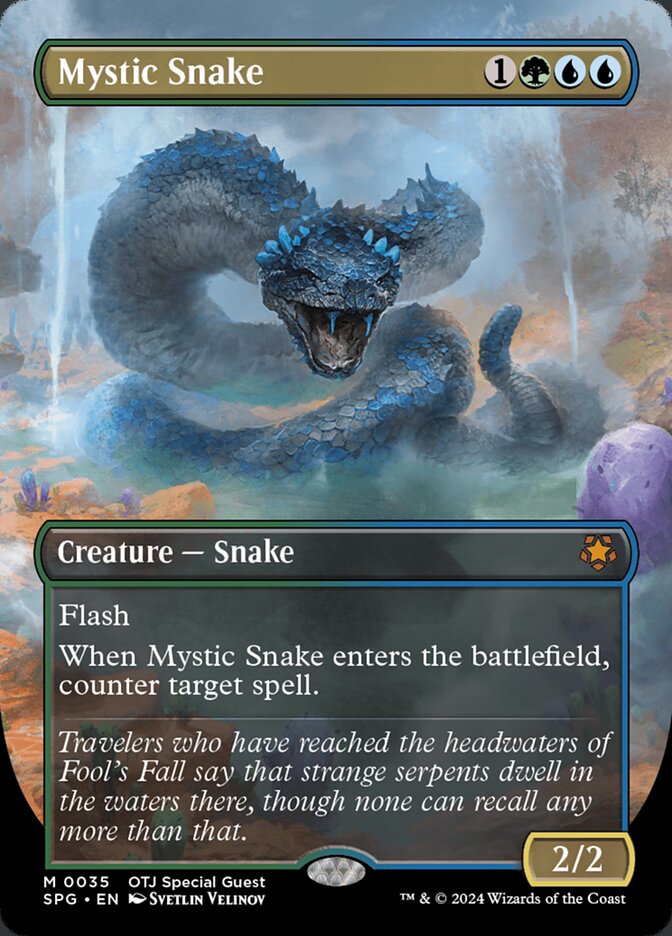

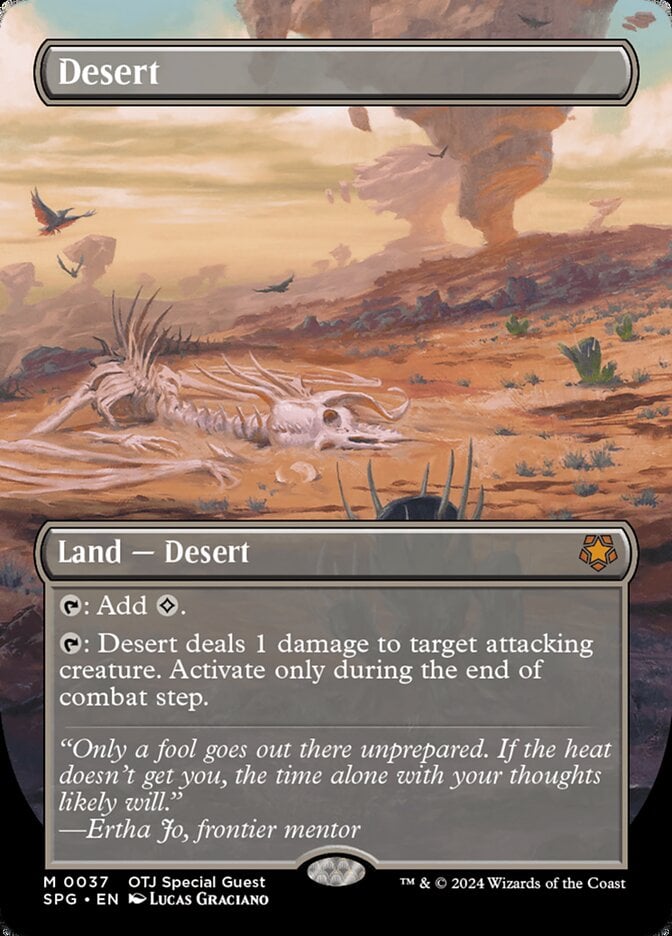
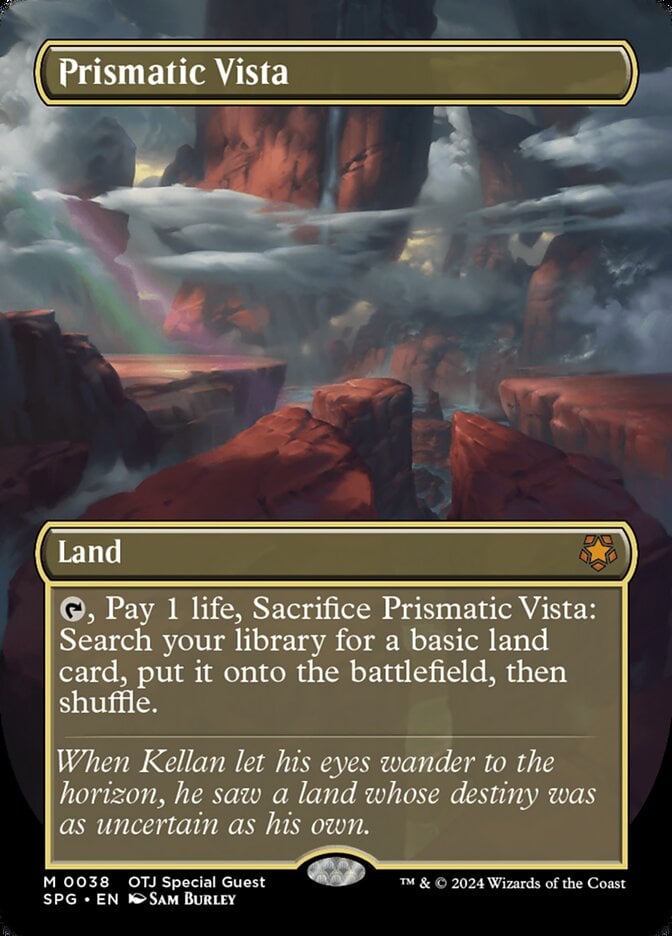
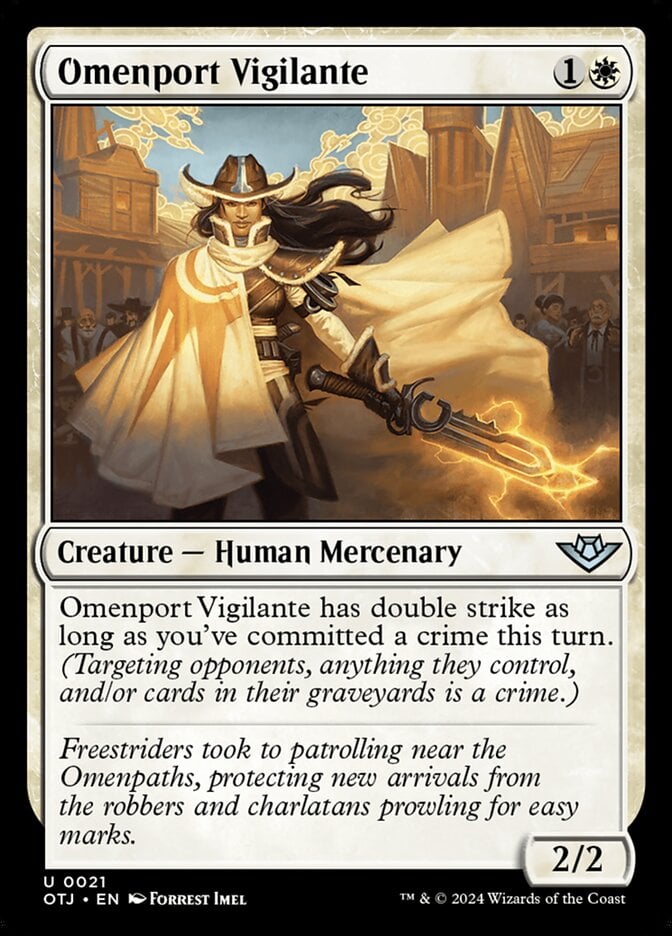
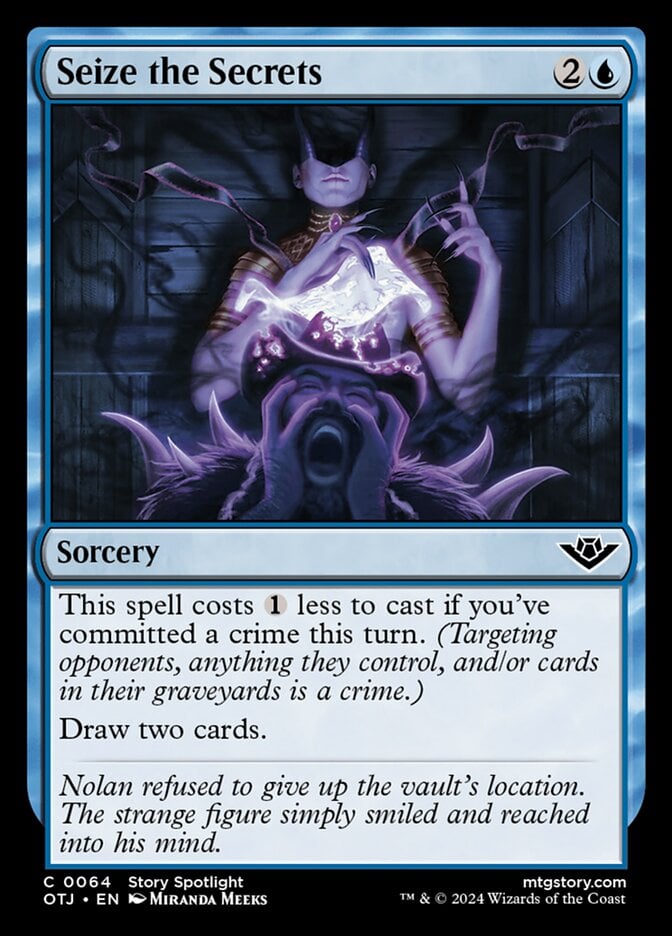
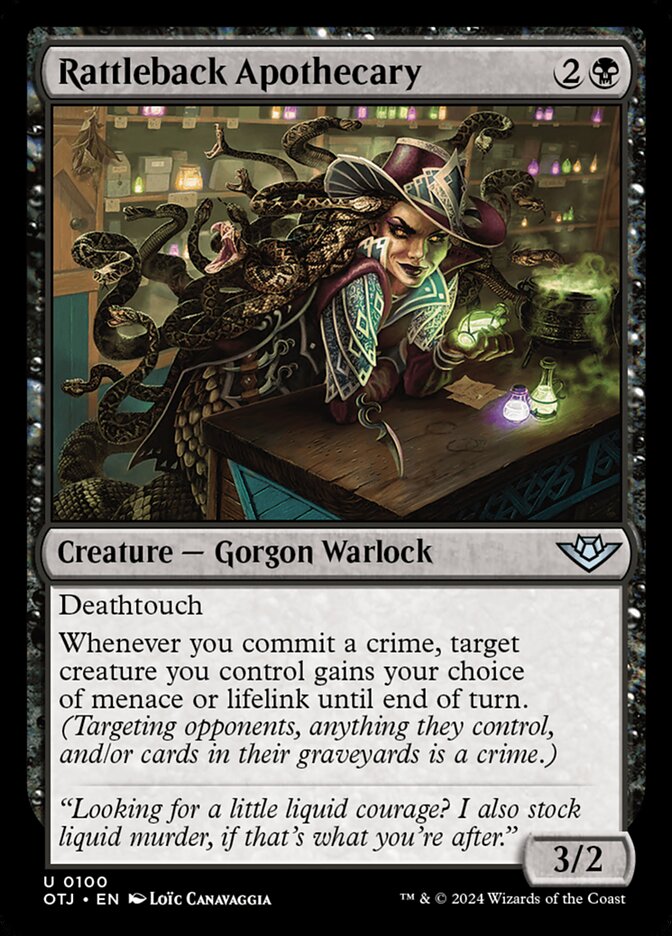
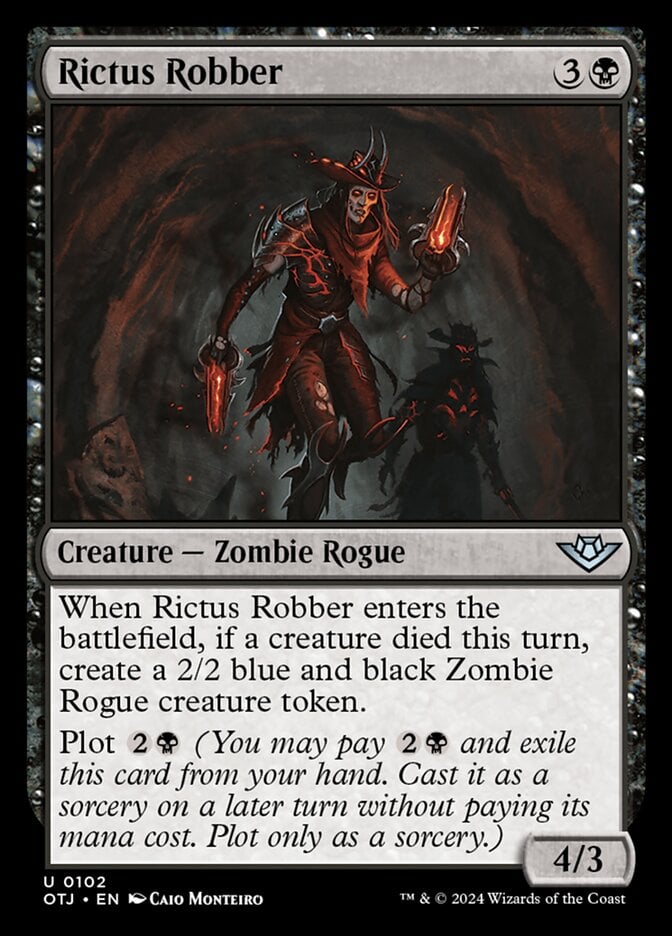
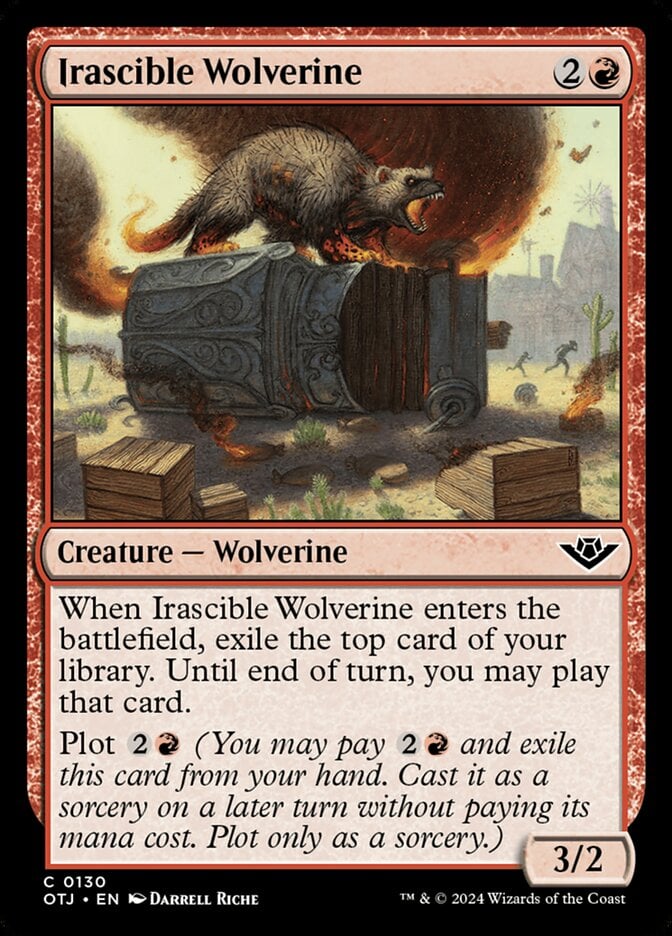
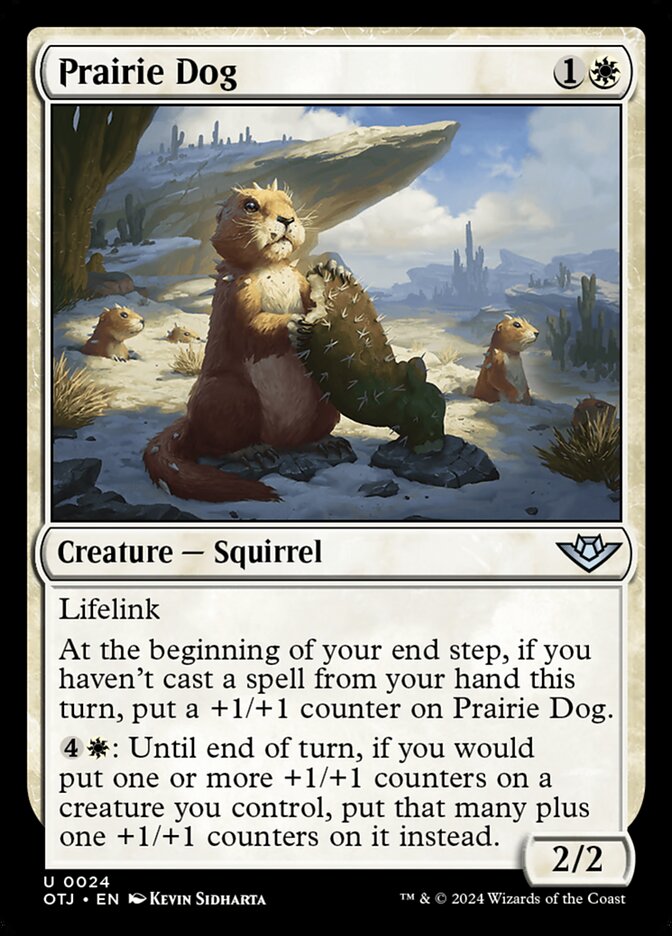

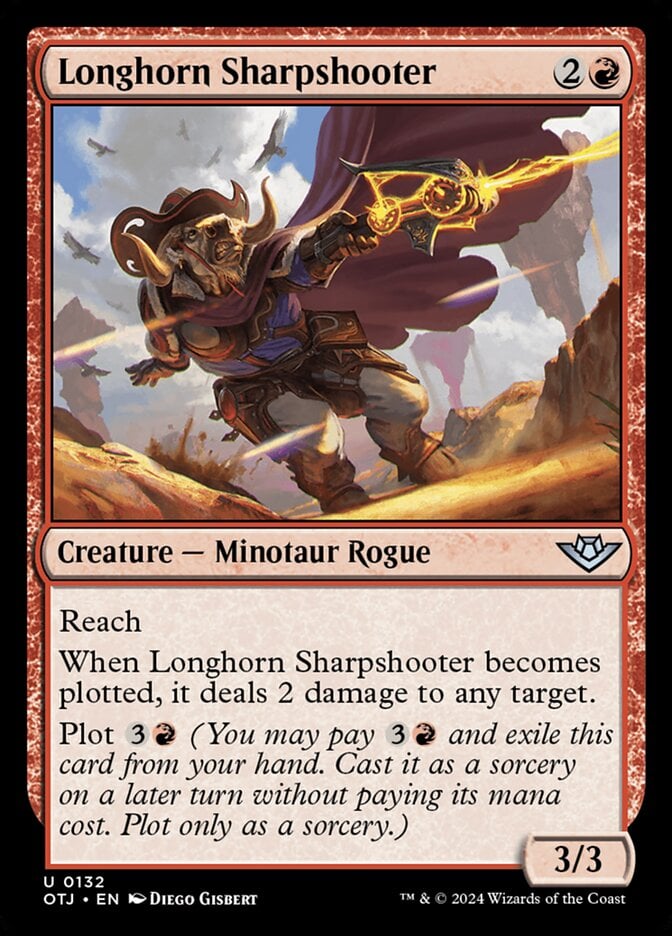
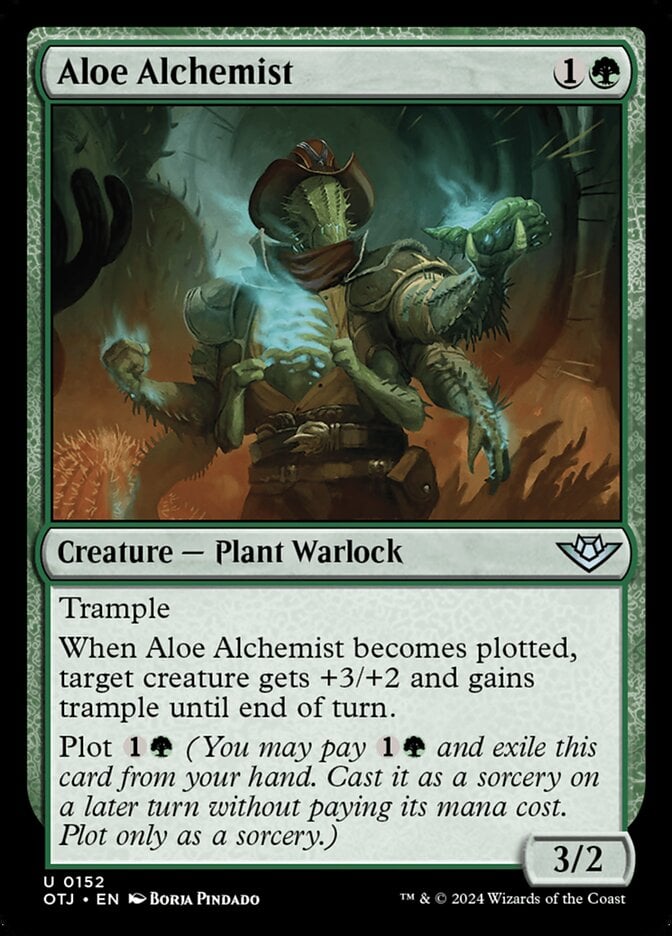
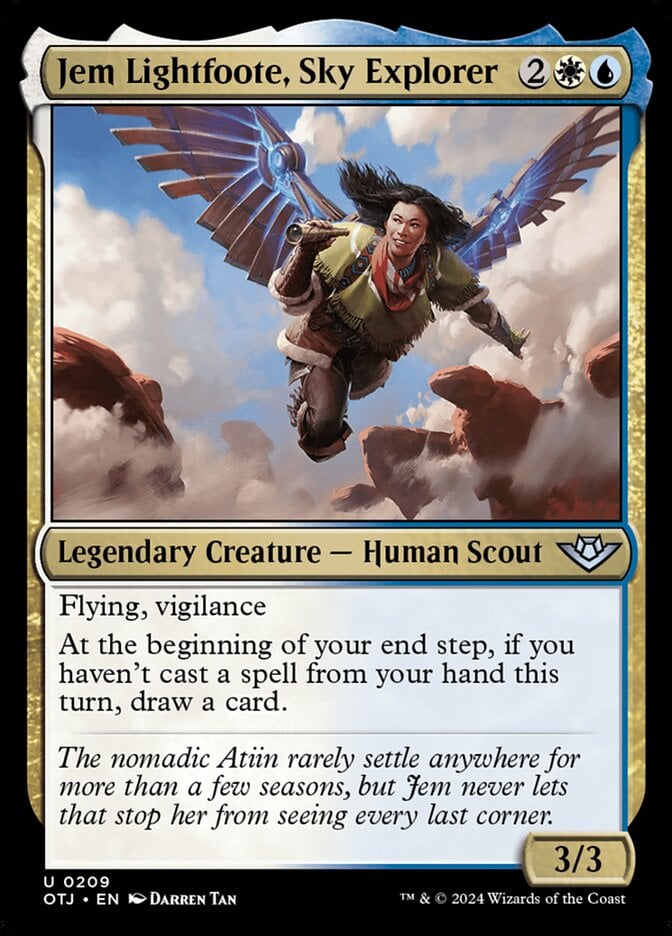


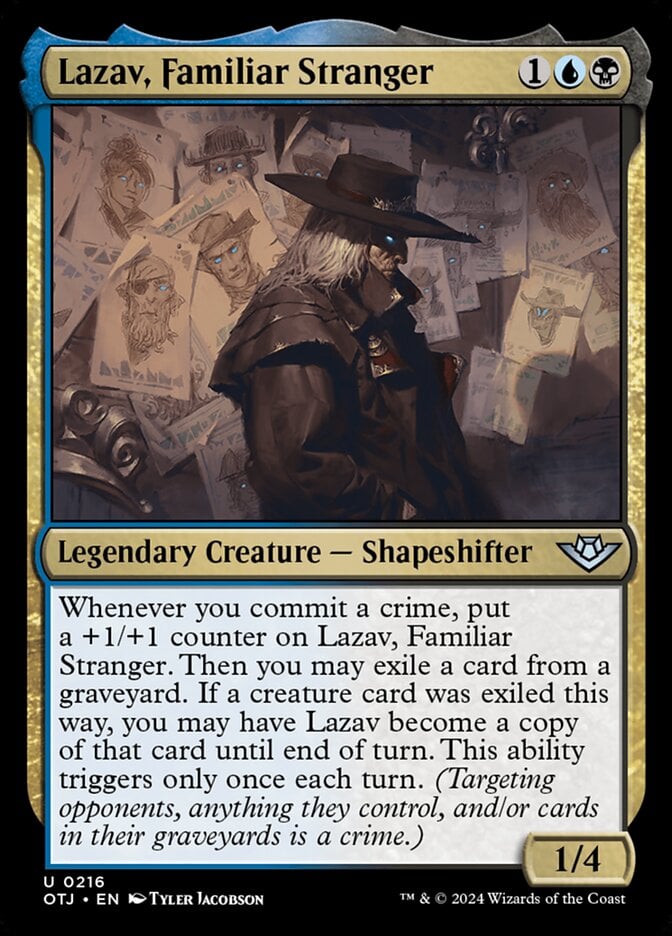

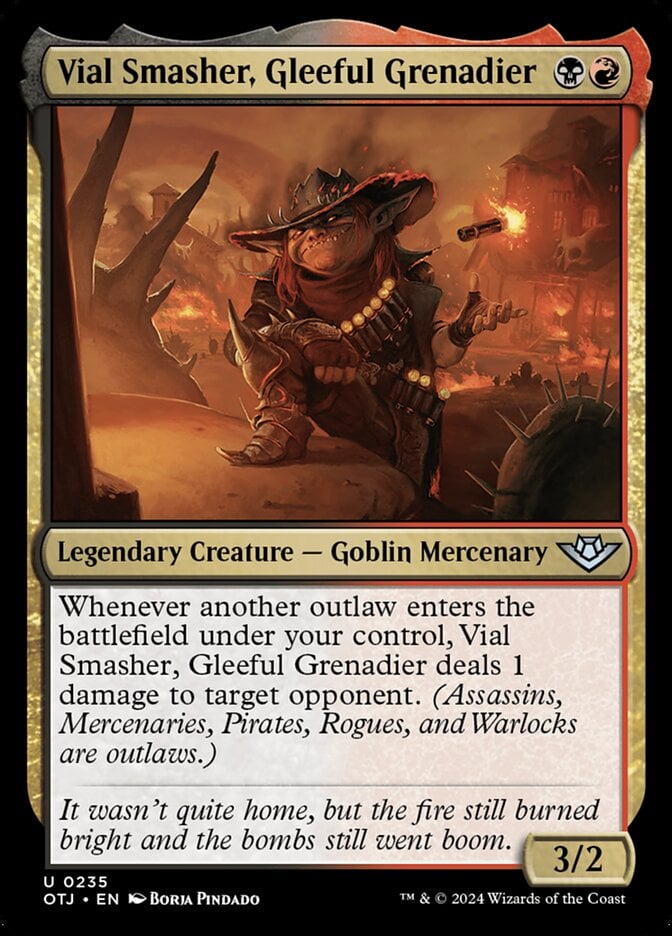
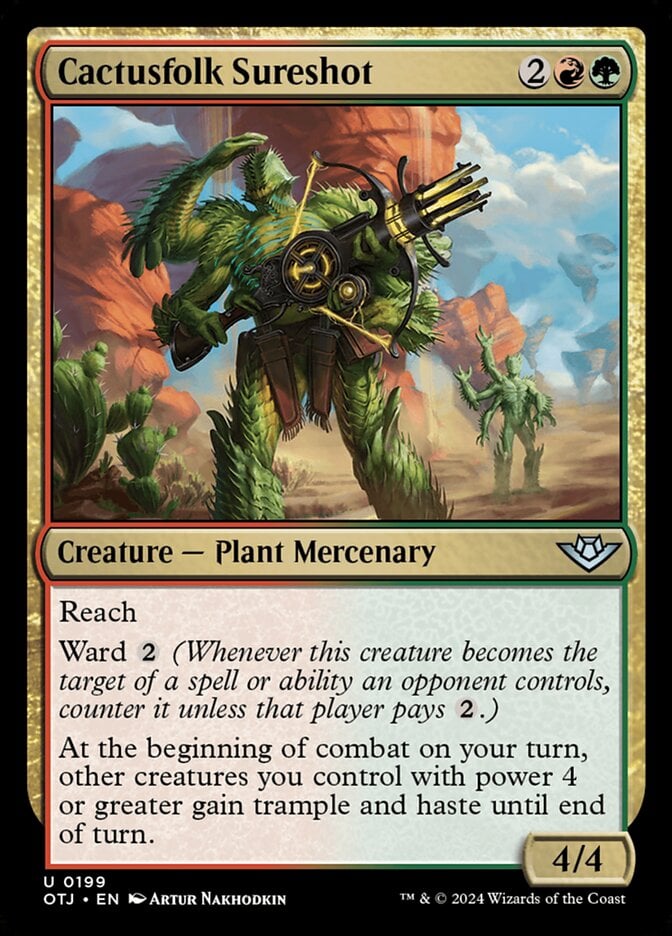
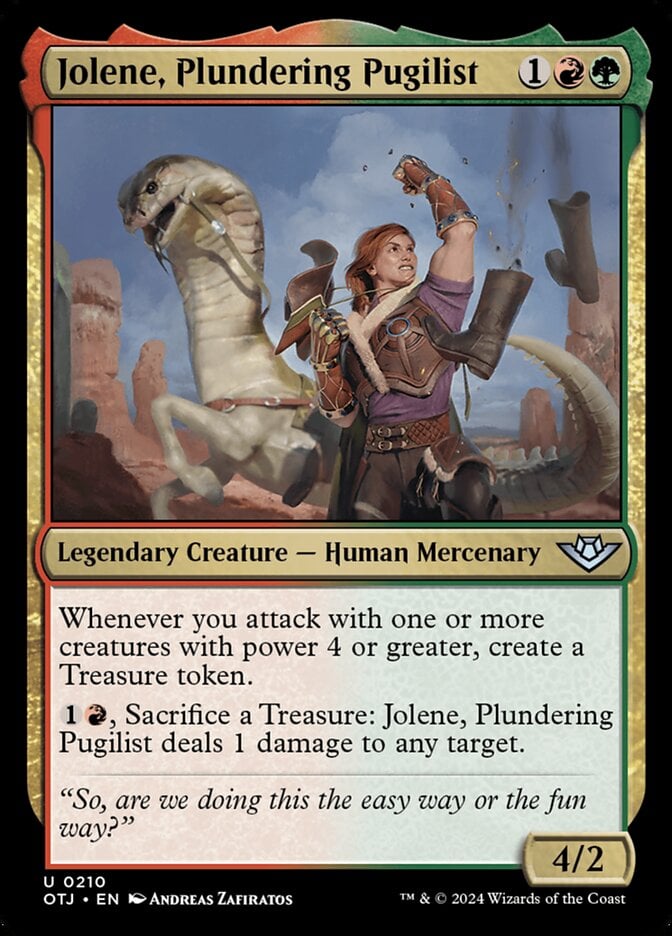
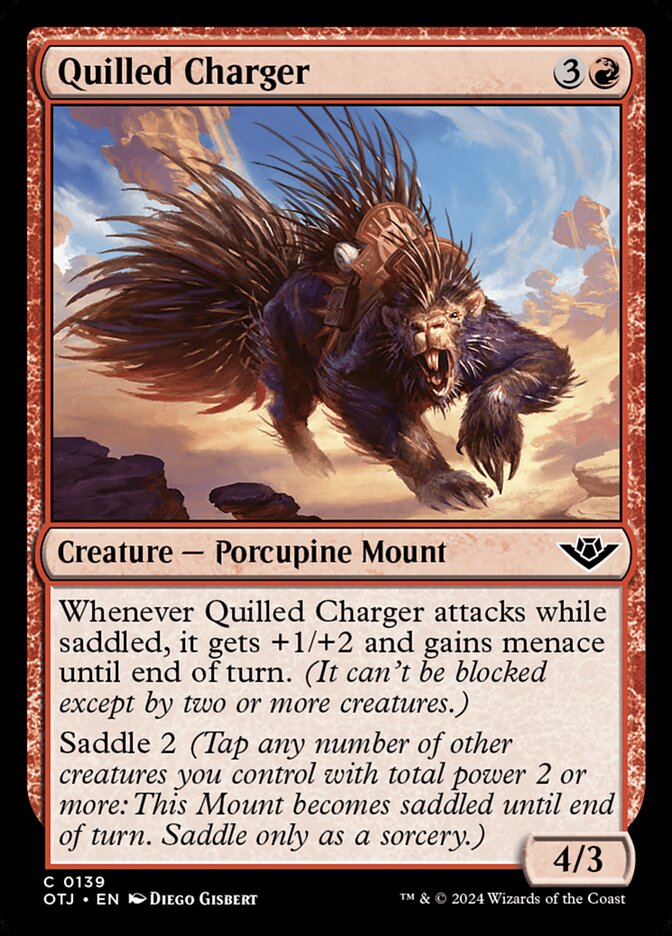

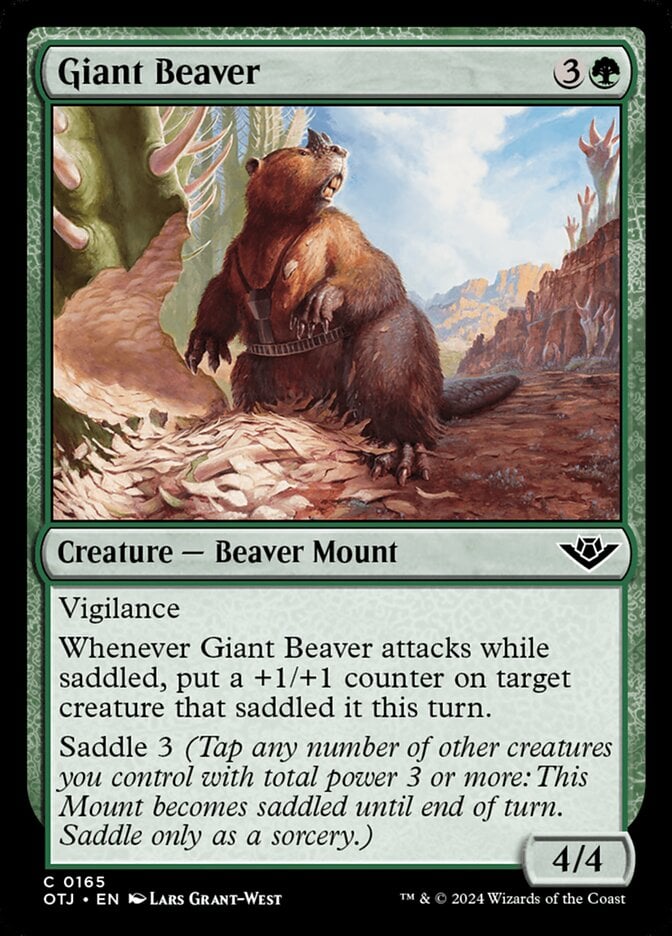
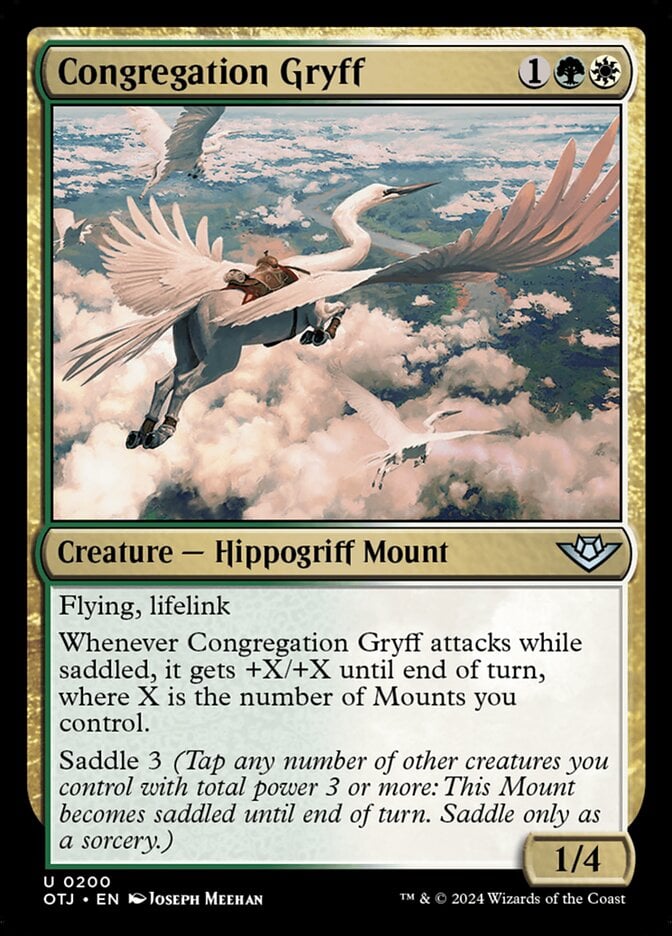

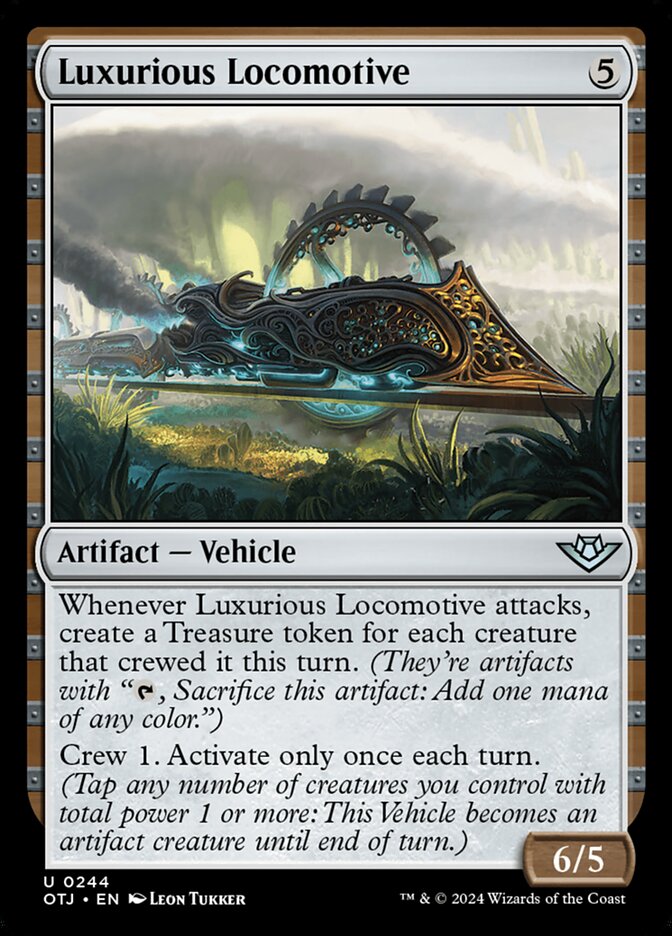
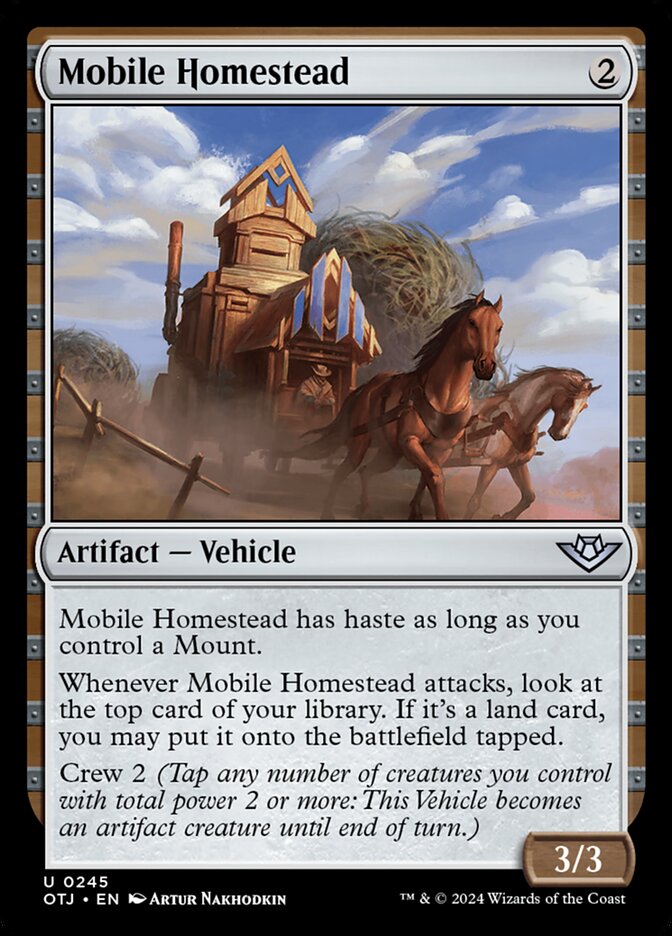

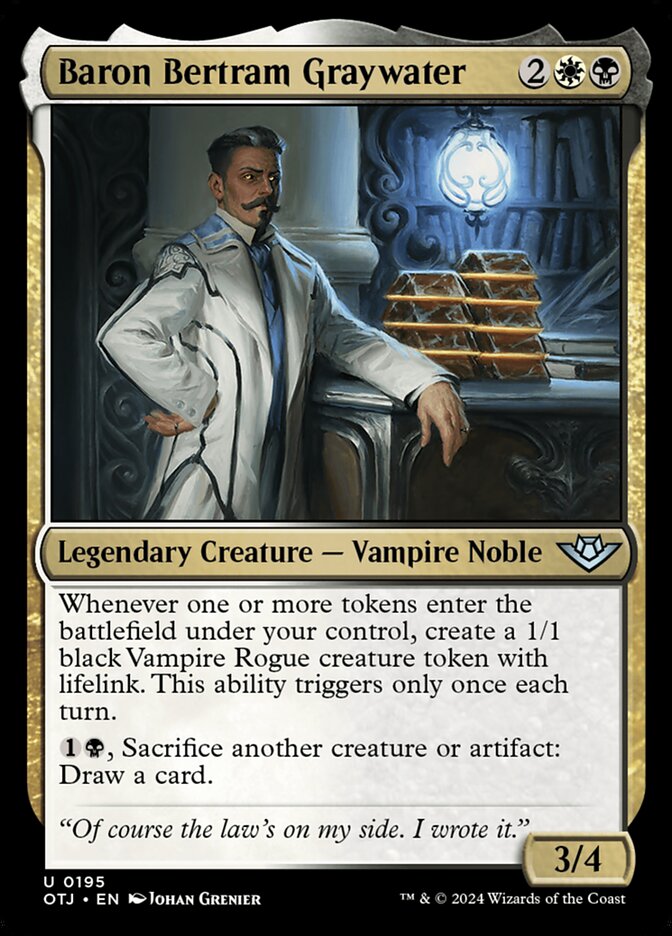
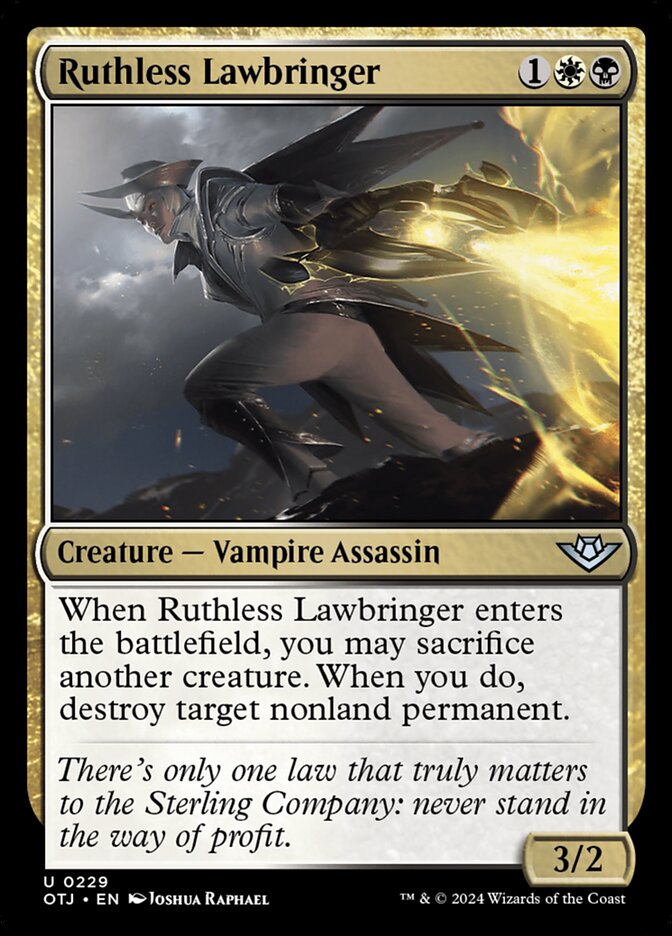
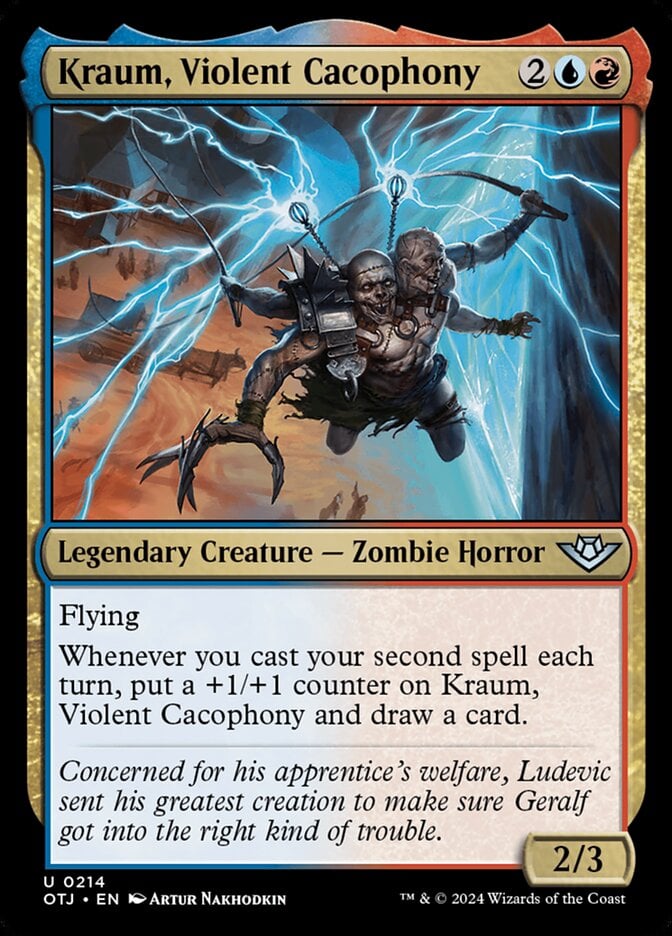

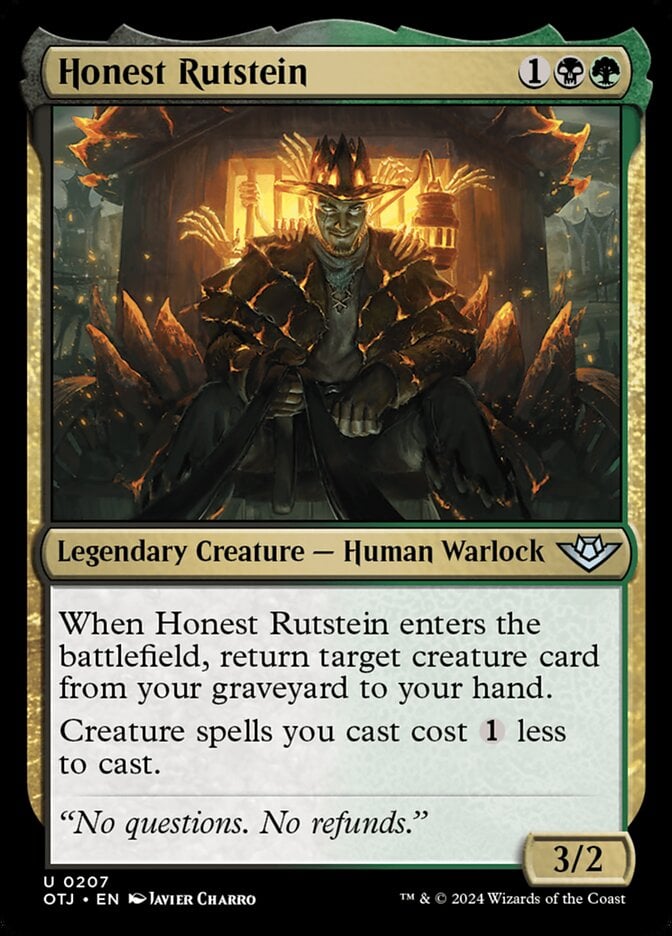
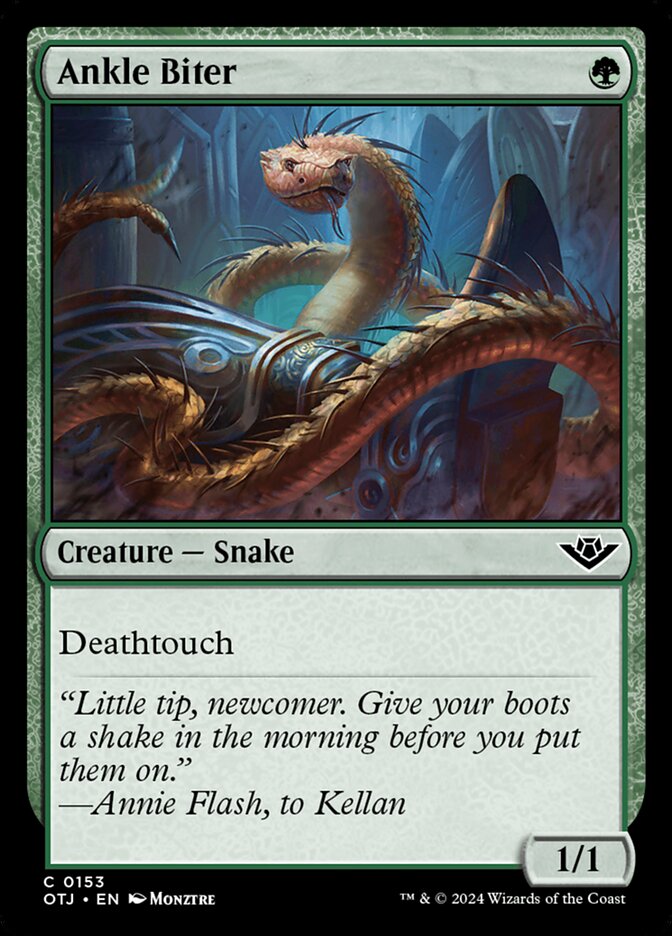
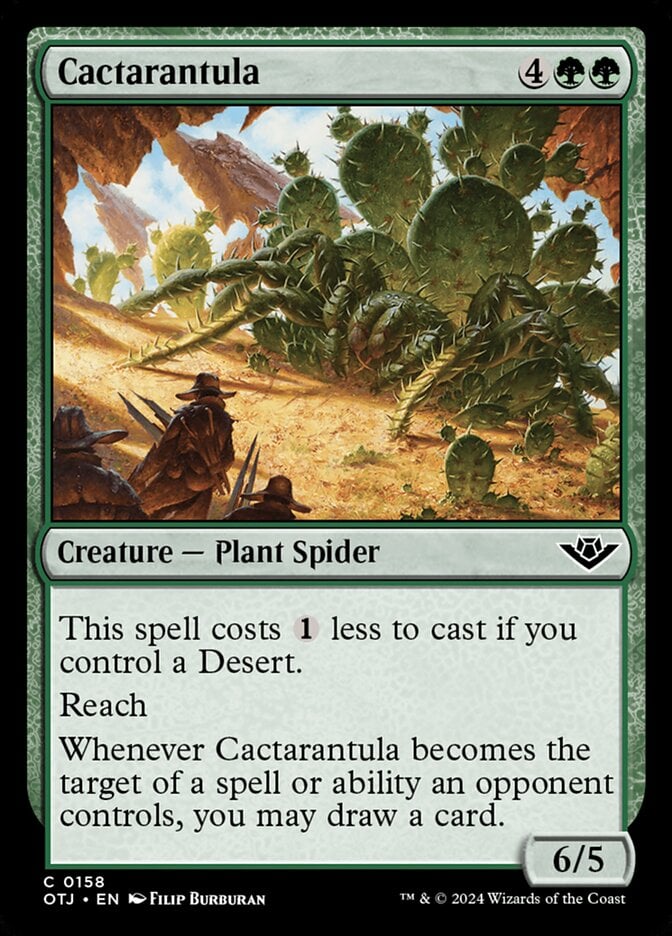
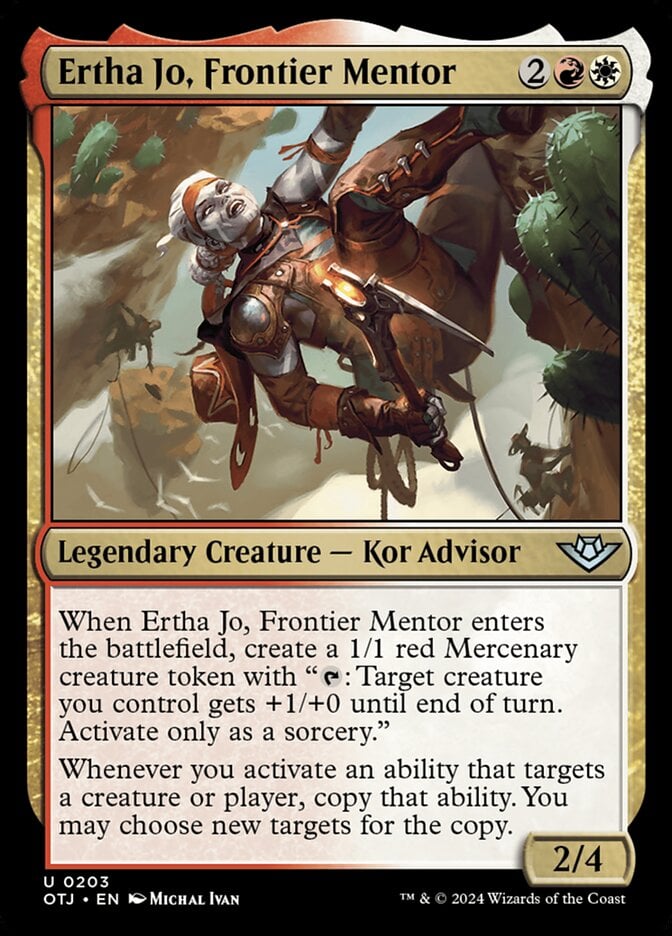
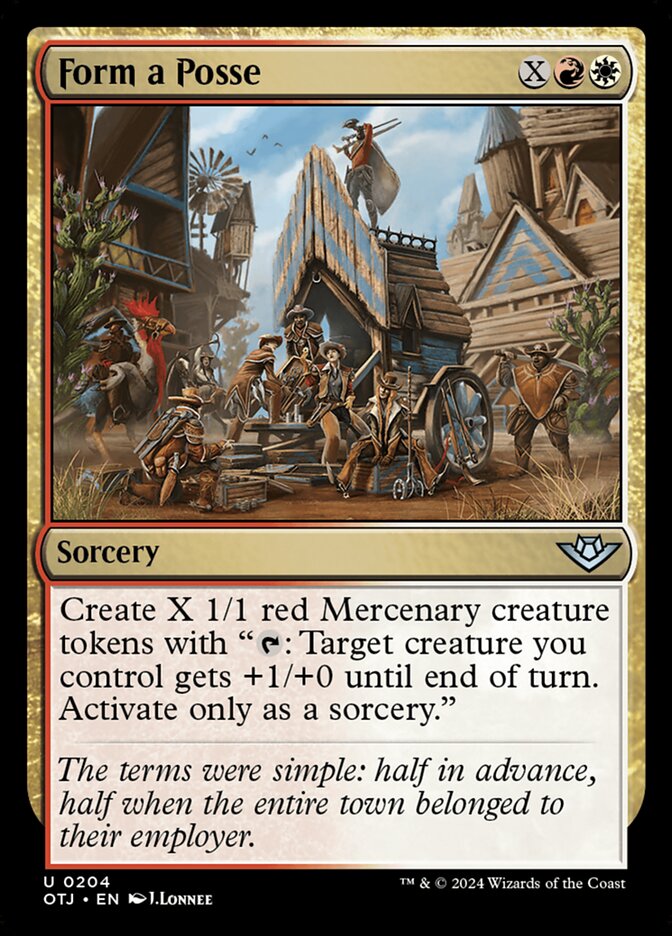
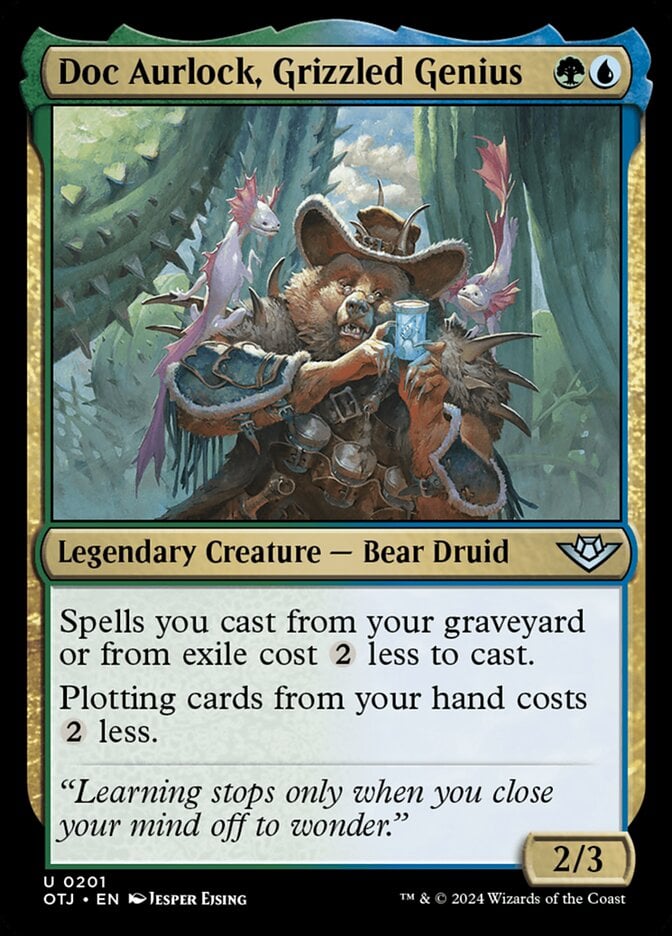
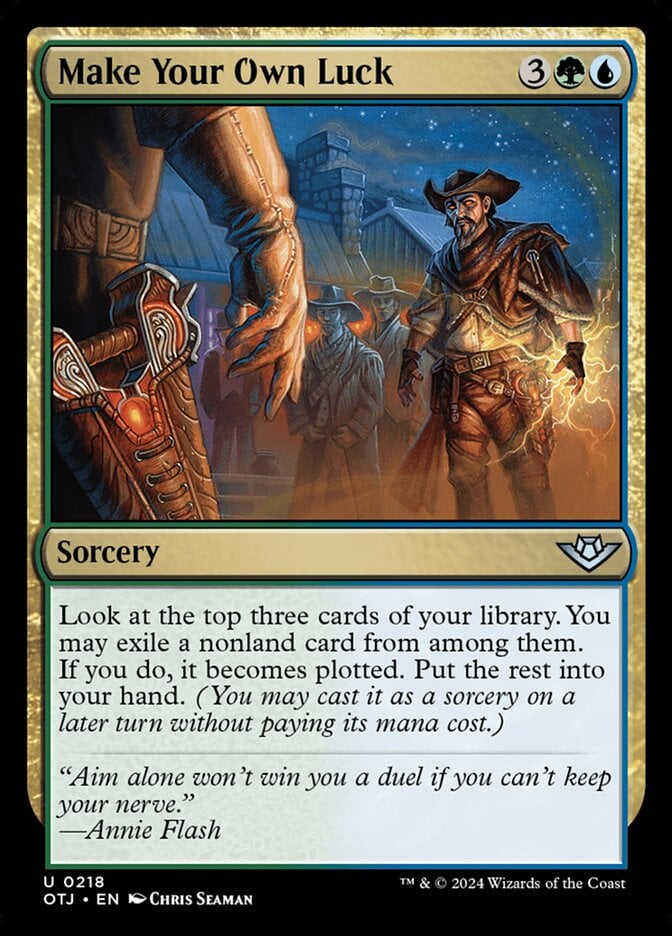
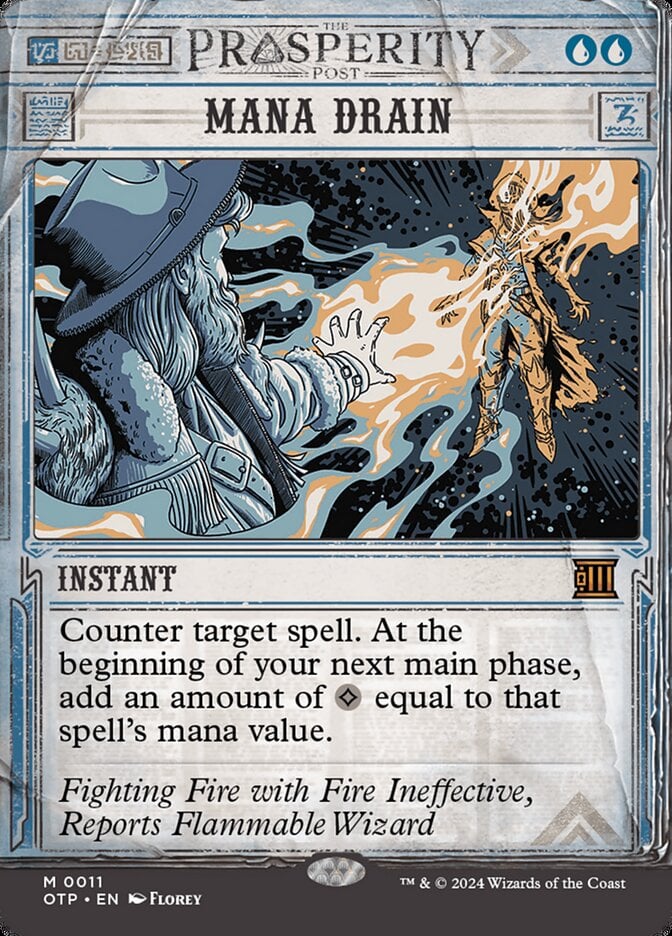
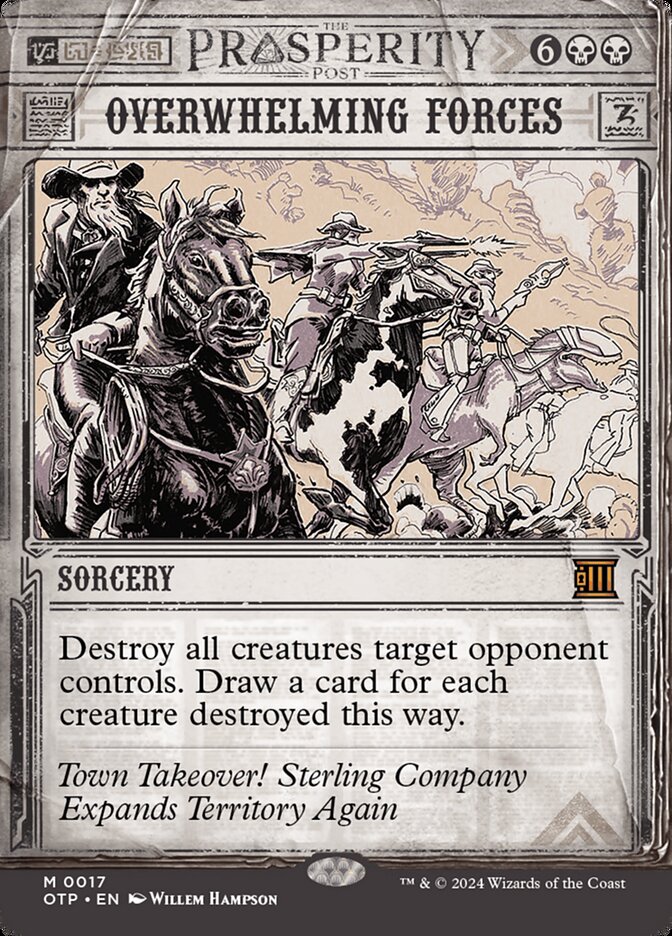
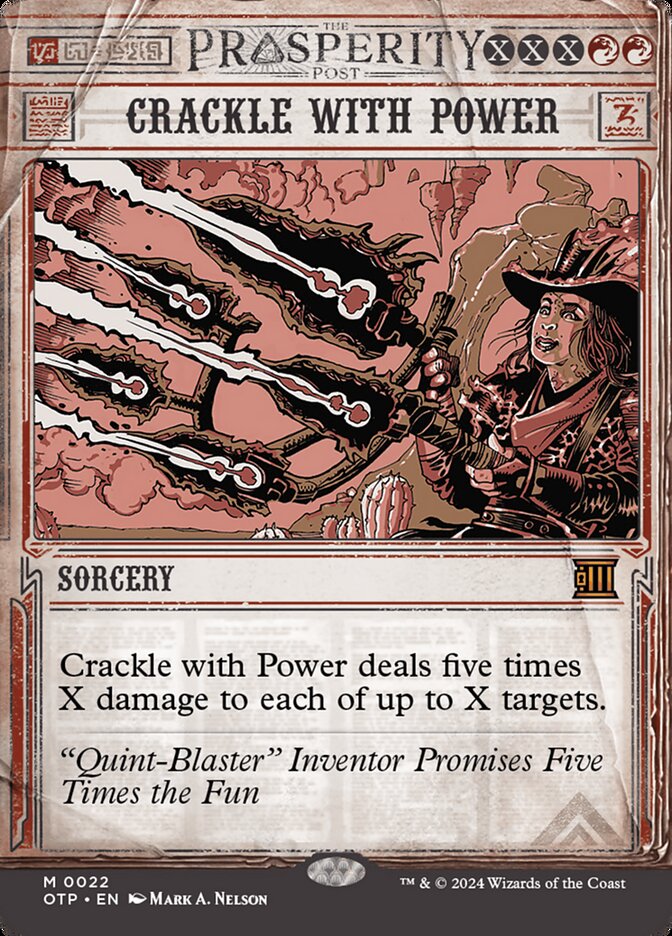
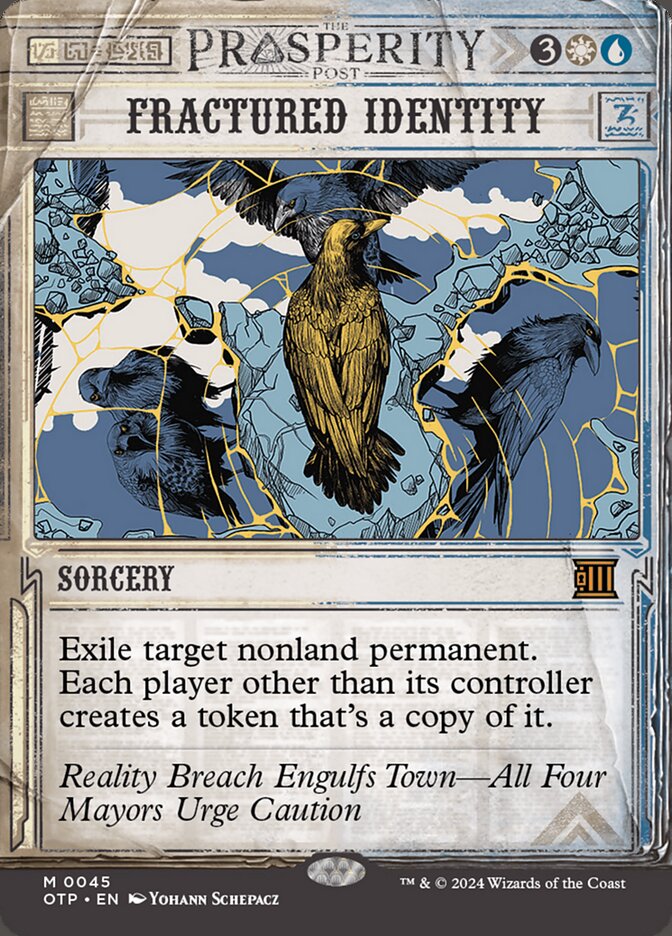

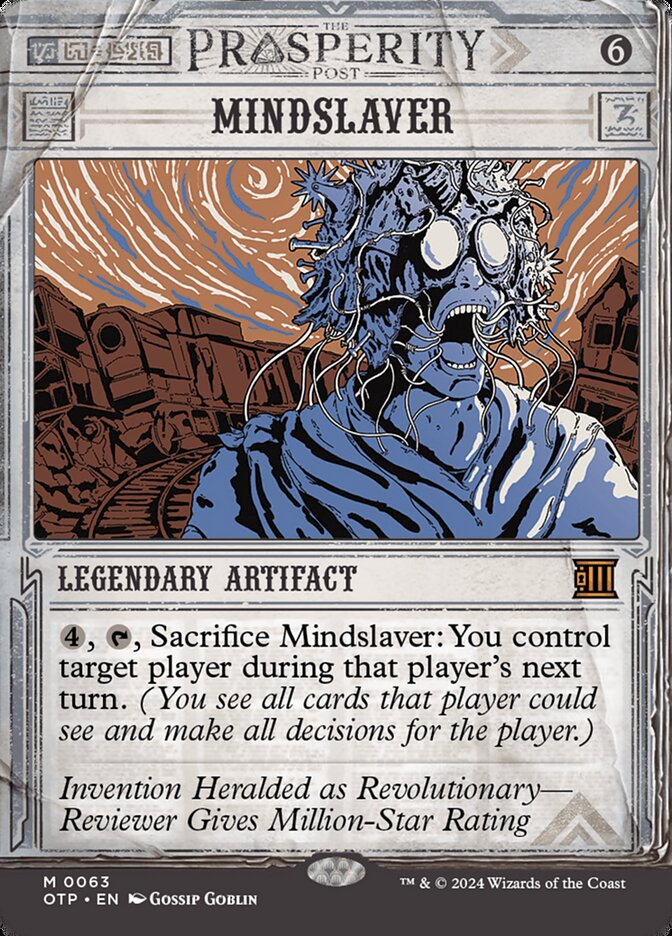
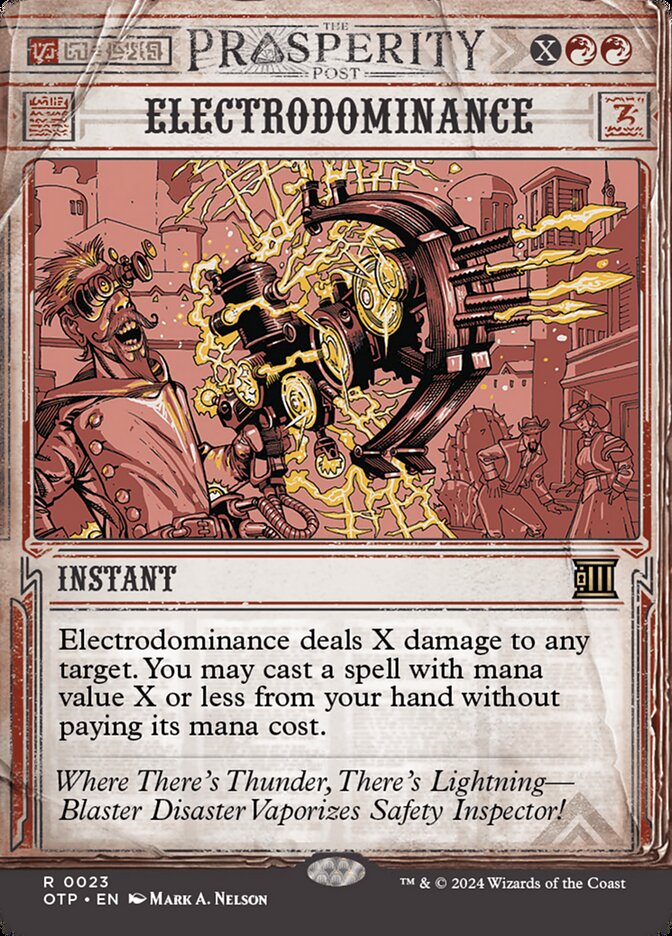
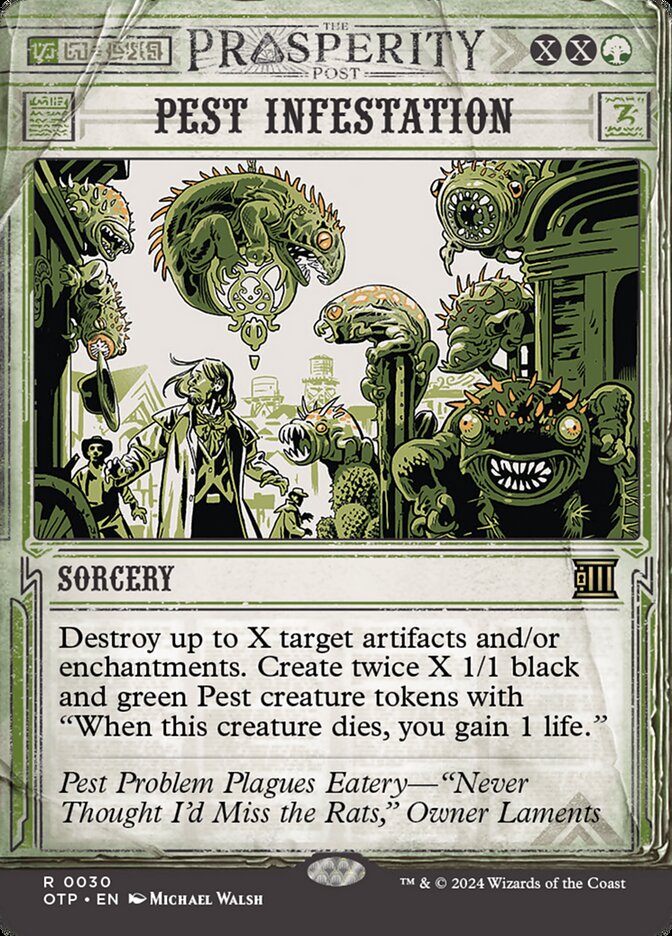

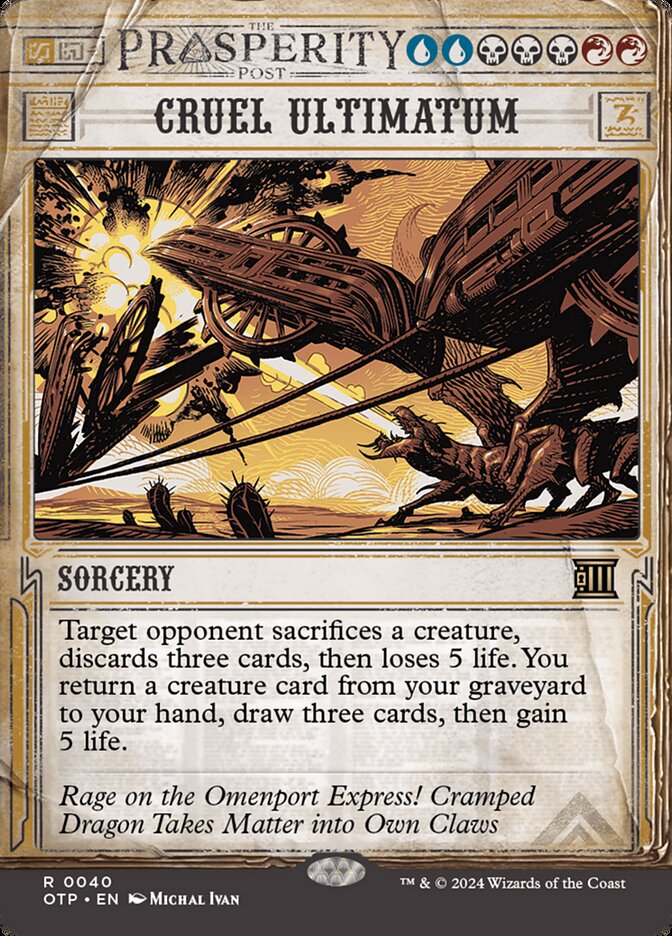
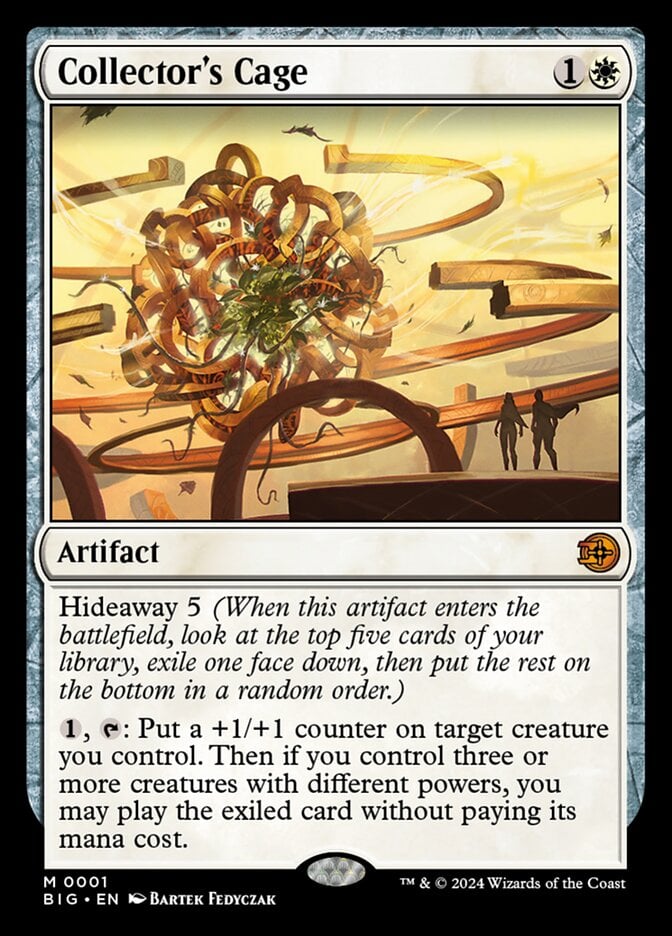
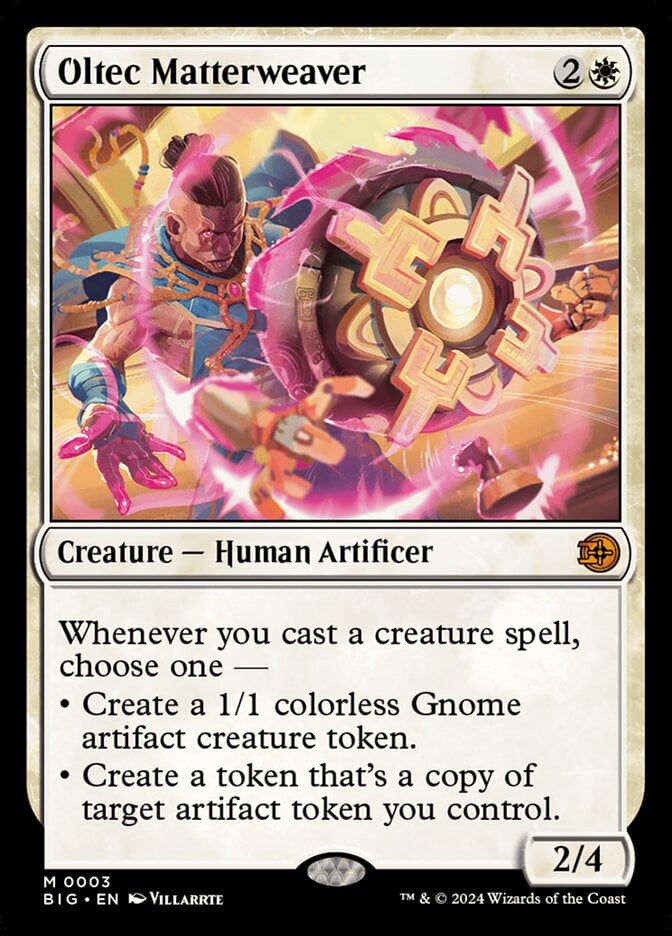

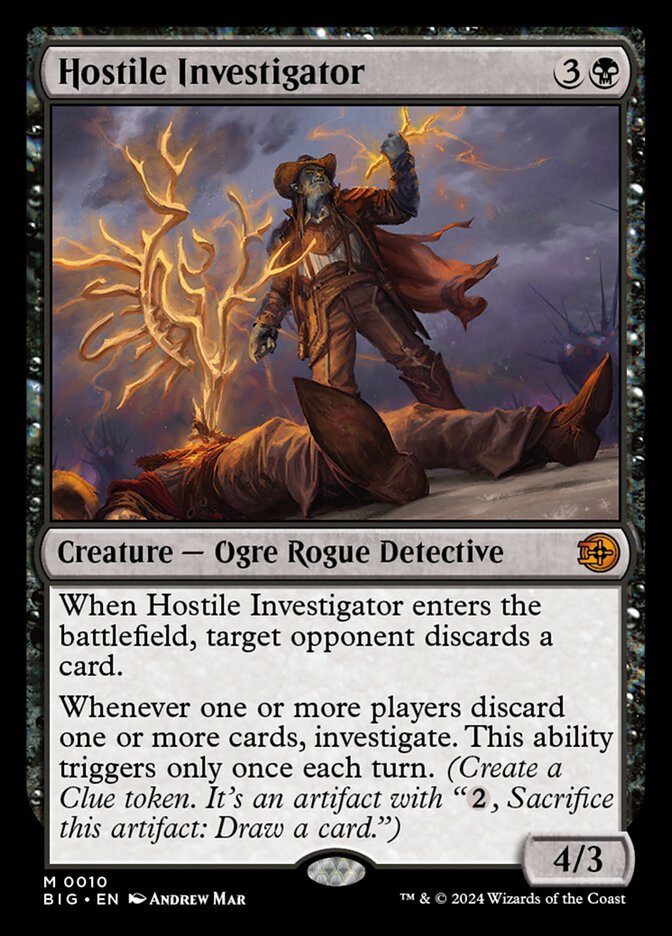
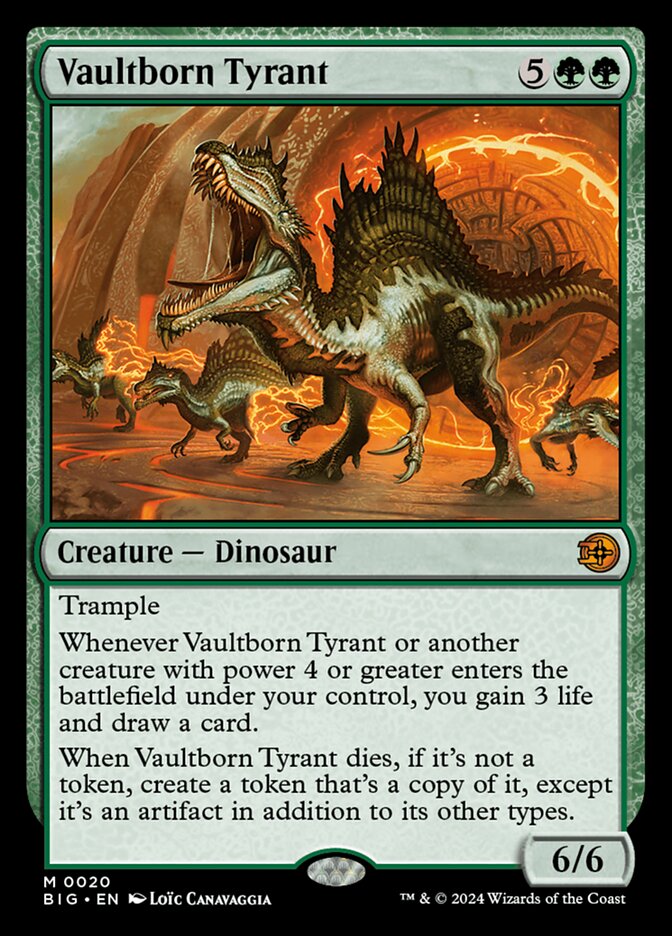

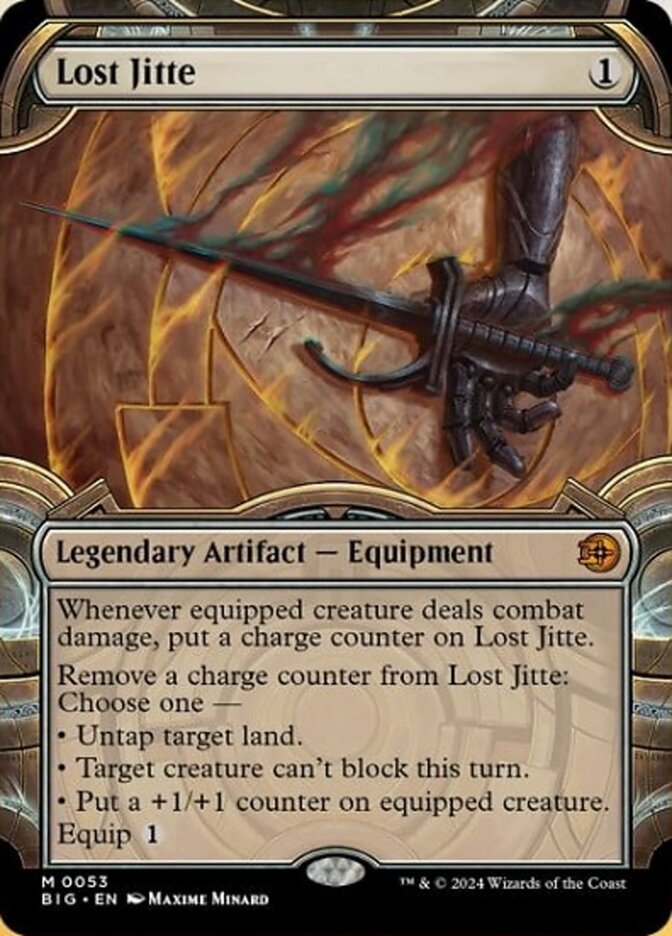
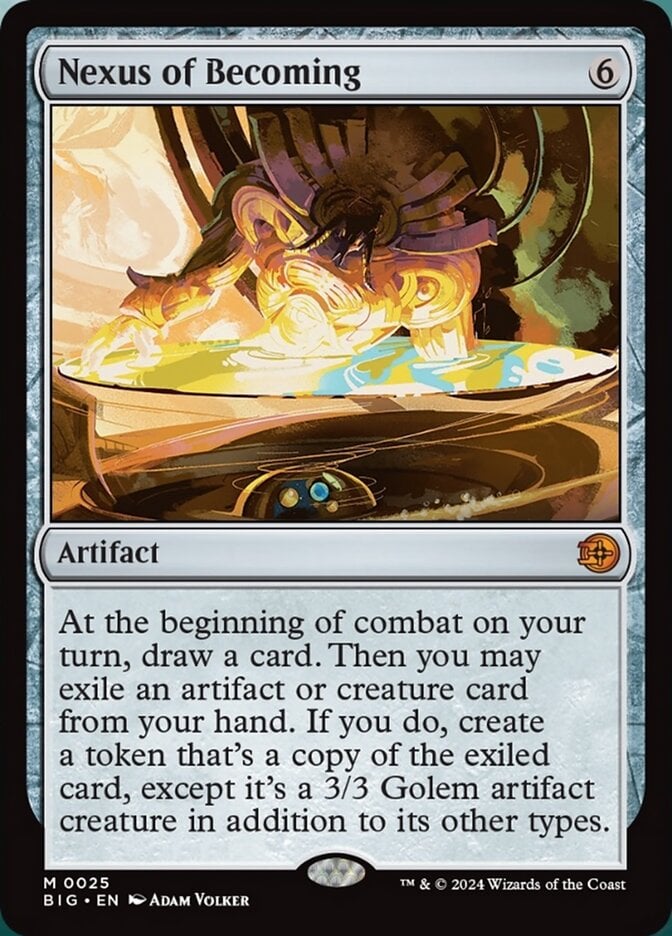
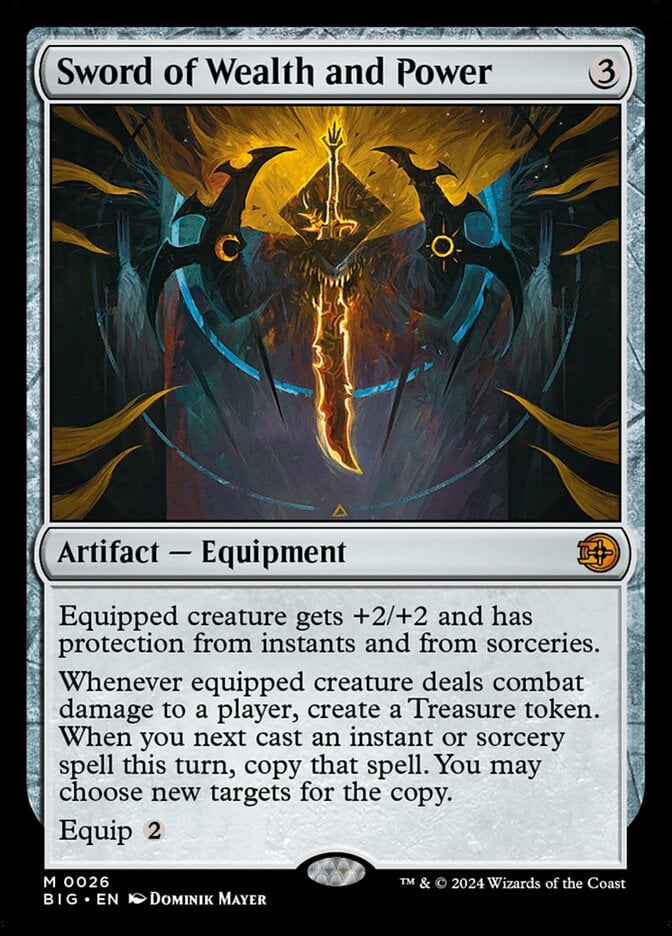
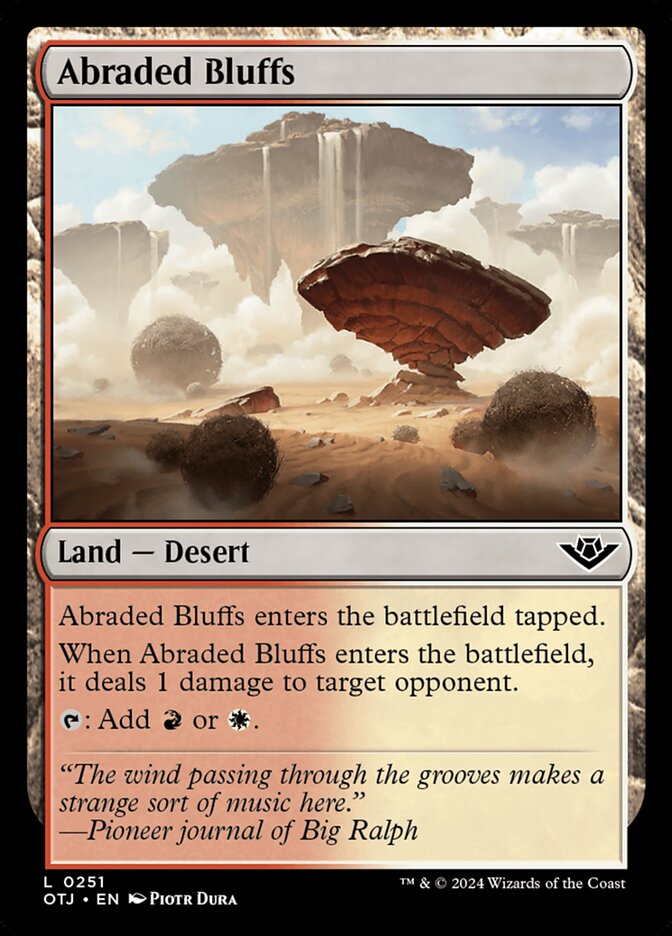
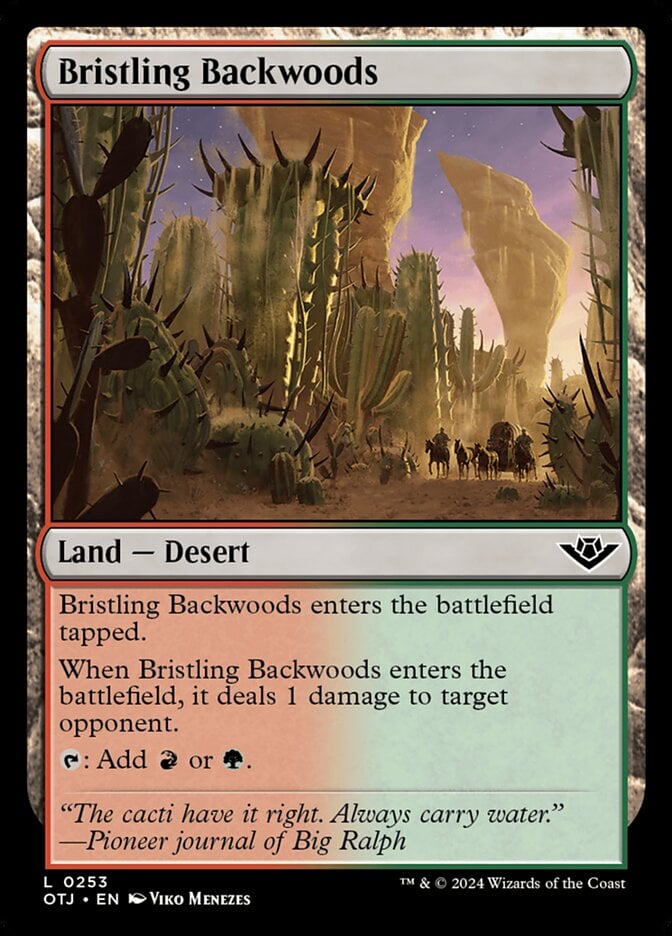

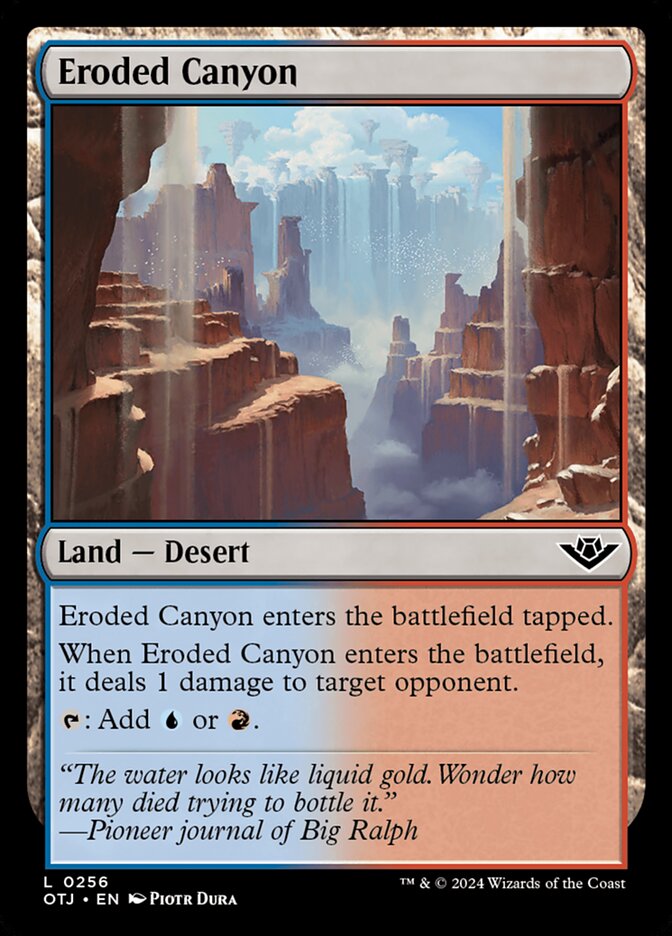
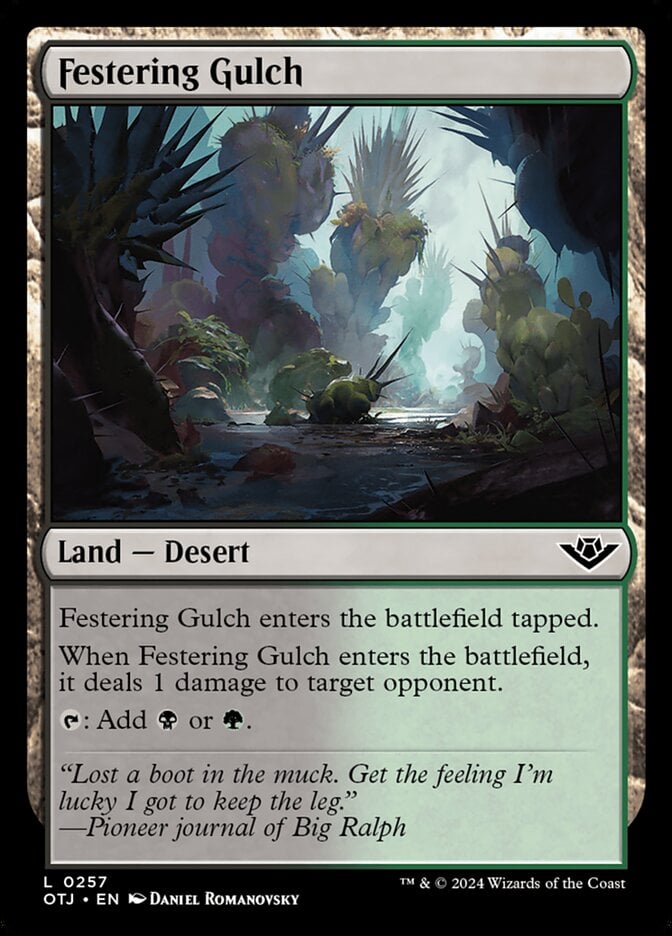
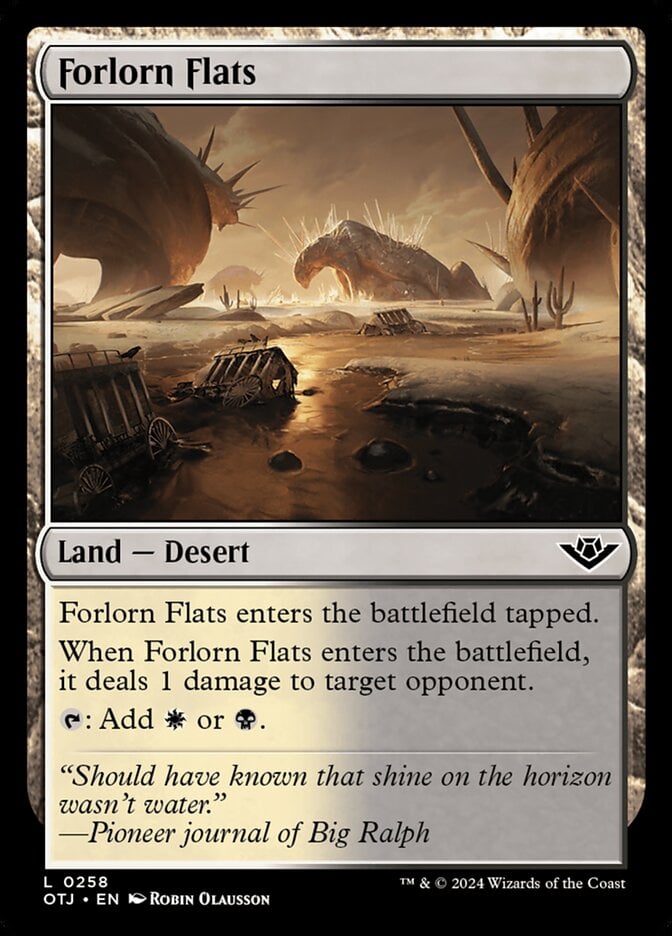

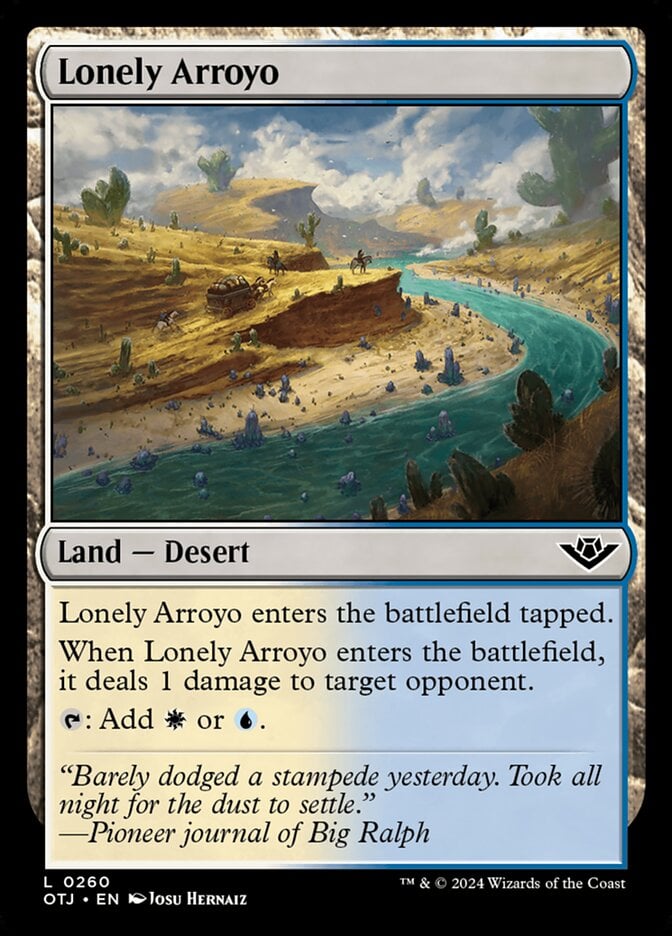
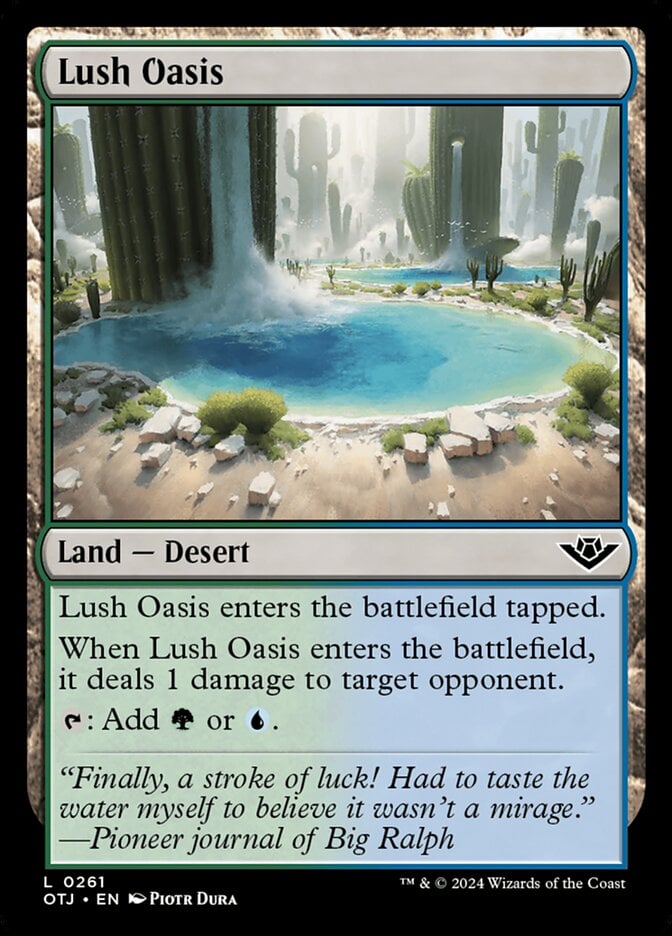
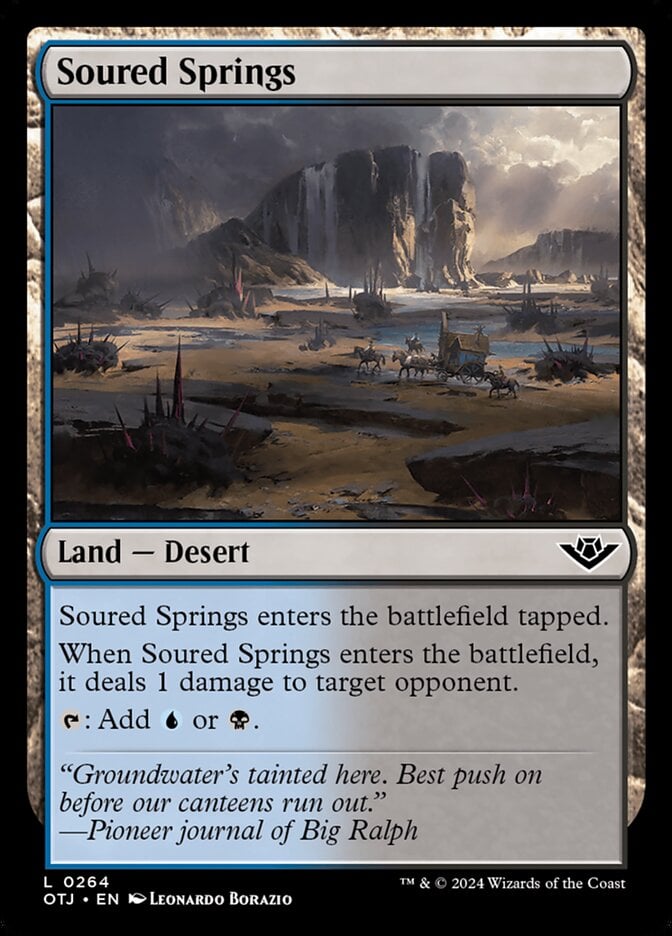
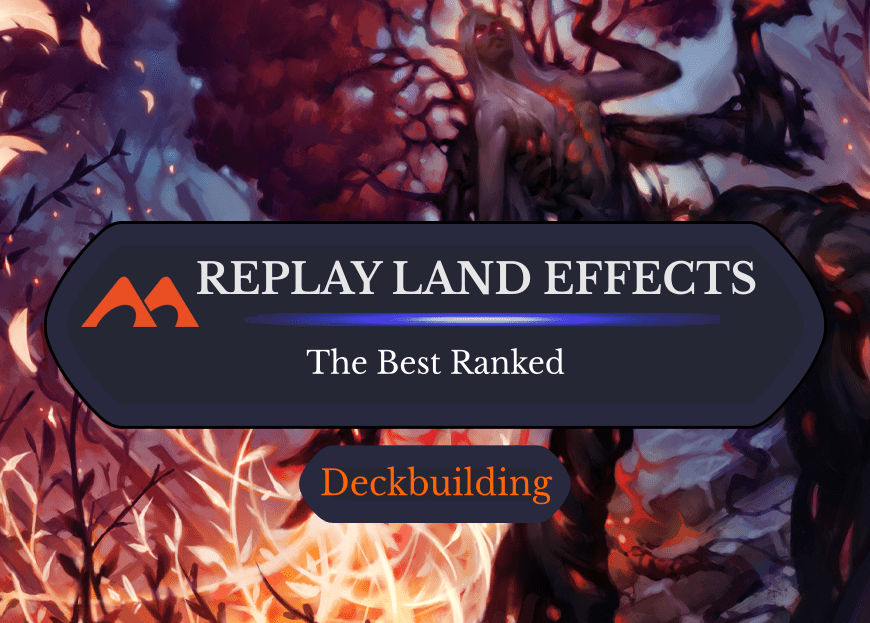
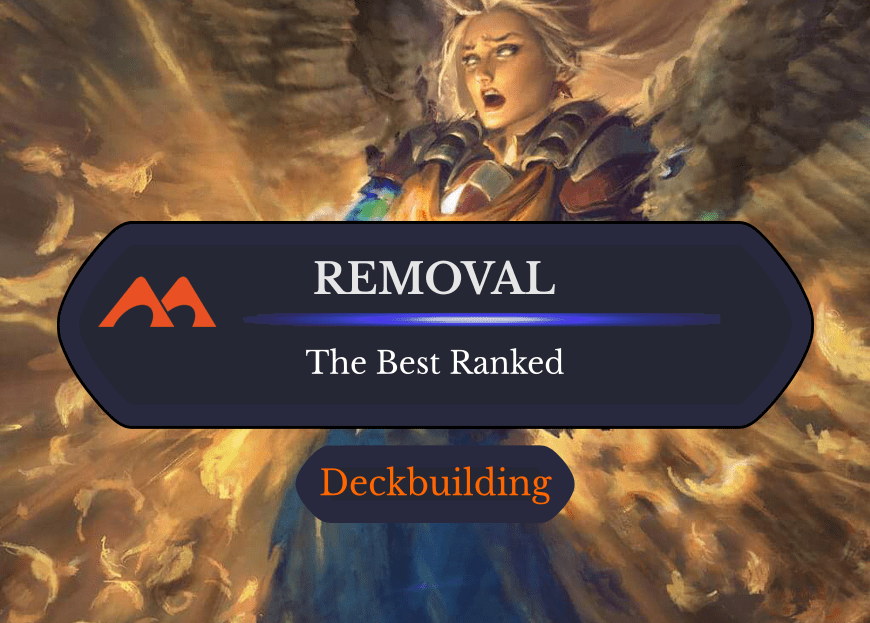
Add Comment